A
ABRAHAM DARBY - DAVID AUSTIN ROSE
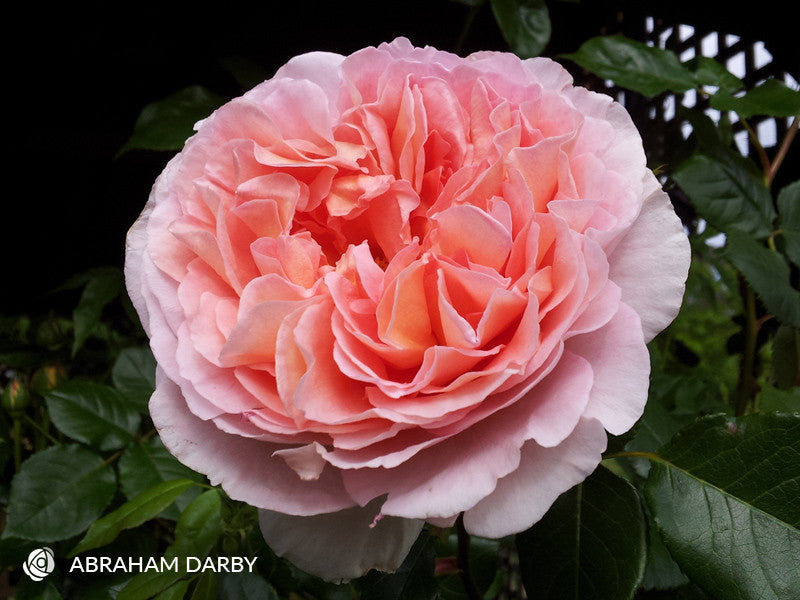 Introduced by David Austin Roses in 2000, this magnificent rose always delights because it is always different and whenever you visit with your Abraham Darby rose, you never know what to expect. This rose will surprise you each time – sometimes deep pinks swirled with apricot, buff-yellow and cream and other times much softer pinks and cream with apricot deep in the centre.
Introduced by David Austin Roses in 2000, this magnificent rose always delights because it is always different and whenever you visit with your Abraham Darby rose, you never know what to expect. This rose will surprise you each time – sometimes deep pinks swirled with apricot, buff-yellow and cream and other times much softer pinks and cream with apricot deep in the centre.
ALTISSIMO – MODERN CLIMBING ROSE, REPEAT FLOWERING, LARGE, BRILLIANT BRIGHT BLOOD-RED SINGLE-PETALLED
 Introduced by Delbard-Chabert, France in 1966 Altissimo is still very popular today because it is an excellent climbing rose for walls, fences or to train as a pillar or support to the posts of a pergola. Altissimo is a vigorous climbing rose with stiff stems capable of branching readily if used to espalier on a wall or fence where it would flower more like a floribunda/cluster-flowered rose and to which it is particularly suited for masses of flowers – grown in this way, Altissimo will cover a wall 3mts x 3mts and be an absolute sight to behold throughout the entire flowering season.
Introduced by Delbard-Chabert, France in 1966 Altissimo is still very popular today because it is an excellent climbing rose for walls, fences or to train as a pillar or support to the posts of a pergola. Altissimo is a vigorous climbing rose with stiff stems capable of branching readily if used to espalier on a wall or fence where it would flower more like a floribunda/cluster-flowered rose and to which it is particularly suited for masses of flowers – grown in this way, Altissimo will cover a wall 3mts x 3mts and be an absolute sight to behold throughout the entire flowering season.
The large, open flowers with 7-8 petals, display yellow stamens which attract the bees for pollination. Altissimo is lightly fragrant and will repeat flower well throughout the Spring, Summer and Autumn if trimmed constantly as the blooms finish.
Altissimo is a very easy-care rose with dark leathery, exceptionally healthy foliage and in Italian, Altissimo means ‘in the highest’ – Altissimo is very appropriately named because it is a very worth climbing rose to place at the top of your list of ‘must have’ roses since it has so many wonderful qualities and is well suited to a variety of situations in the rose garden. Altissimo happily lets you be the boss and make it do whatever it is you want and whichever site you would like it to cover, this intensely bright coloured, free-flowering climbing rose will never disappoint!
- Stunning large bright red single rose with yellow stamens
- Climber to suit many different aspects in rose garden
- Exceedingly healthy
- Very free flowering
CULTURAL NOTES:
The generally sunny, dry and hot conditions of the Australian garden are particularly well suited to planting roses and roses flourish in our gardens when you take measures to provide the following:
WATER – Roses are very deep rooted plants and require one good, deep soaking at least every 10 days in hot and dry conditions.
FEED – Because roses flower throughout all but the Winter season, they should be regularly fertilized with quality (preferably organic) fertilizer which contains a balance of major nutrients (NPK) and trace elements. The fertilizer should be applied at least once a month – small amount often – with fortnightly applications of liquid seaweed over the foliage.
PRUNE – During Winter, 70% of the rose plant should be pruned and all old wood removed back to the crown and the bush pruned to shape.
During the flowering seasons, 25% of all flowering stems should be cut back after flowering to encourage strong re-growth.
MULCH – Particular attention to application of lucerne or pea straw directly around the root-zone of each rose will enhance the overall health of the rose and then the whole bed should be mulched to 75mm with any other mulch medium available.
B
BEST FRIEND – HYBRID TEA ROSE, DEEP HOT PLUM PINK, CONTINUAL FLOWERING ROSE OF CLASSICAL STYLE AND BEAUTY
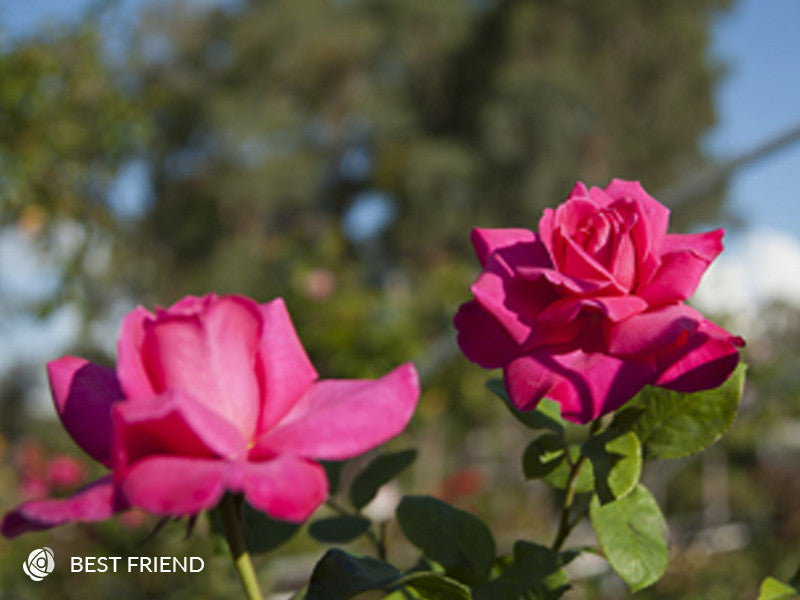 Bred by Meilland of France in 1998 and registered as ‘Caprice de Meilland’ until it came into Australia and was released under it’s current name: Best Friend. This magnificent rose was named by the R.S.P.C.A to honour the unconditional love and special friendship which all animal lovers cherish. This exquisite rose produces long, strong stems of the most highly fragrant bright pink roses which are ideally suited for flower arrangements. The attractive large leaves are rather light green and the only warning with this rose is that it should be placed in an open position with lots of airflow because it has a tendency to get powdery mildew if it is against a wall or has other plants growing below it!
Bred by Meilland of France in 1998 and registered as ‘Caprice de Meilland’ until it came into Australia and was released under it’s current name: Best Friend. This magnificent rose was named by the R.S.P.C.A to honour the unconditional love and special friendship which all animal lovers cherish. This exquisite rose produces long, strong stems of the most highly fragrant bright pink roses which are ideally suited for flower arrangements. The attractive large leaves are rather light green and the only warning with this rose is that it should be placed in an open position with lots of airflow because it has a tendency to get powdery mildew if it is against a wall or has other plants growing below it!
Best Friend is a very tall growing plant and yet is quite suitable to grow as a standard rose but must then be very well supported with a steel stake which extends 30cms beyond the bud union and kept well groomed throughout the flowering season … cut long stems of flowers each time you trim this magnificent rose and it will reward you with a continual supply of the most delightfully fragrant blooms to remind you of your Best Friend, man or beast!
- Highly fragrant
- Exceptionally beautiful hot pink blooms
- Ideal for flower arrangements
- Lovely name as a gift for many, varied occasions
- Strong, tall grower suitable for hedge
CULTURAL NOTES:
The generally sunny, dry and hot conditions of the Australian garden are particularly well suited to planting roses and roses flourish in our gardens when you take measures to provide the following:
WATER – Roses are very deep rooted plants and require one good, deep soaking at least every 10 days in hot and dry conditions.
FEED – Because roses flower throughout all but the Winter season, they should be regularly fertilized with quality (preferably organic) fertilizer which contains a balance of major nutrients (NPK) and trace elements. The fertilizer should be applied at least once a month – small amount often – with fortnightly applications of liquid seaweed over the foliage.
PRUNE – During Winter, 70% of the rose plant should be pruned and all old wood removed back to the crown and the bush pruned to shape.
During the flowering seasons, 25% of all flowering stems should be cut back after flowering to encourage strong re-growth.
MULCH – Particular attention to application of lucerne or pea straw directly around the root-zone of each rose will enhance the overall health of the rose and then the whole bed should be mulched to 75mm with any other mulch medium available.
C
CARMAGNOLE – A DELBARD SHRUB ROSE OF INCREDIBLE BEAUTY AND HEALTHY VIGOROUS GROWTH
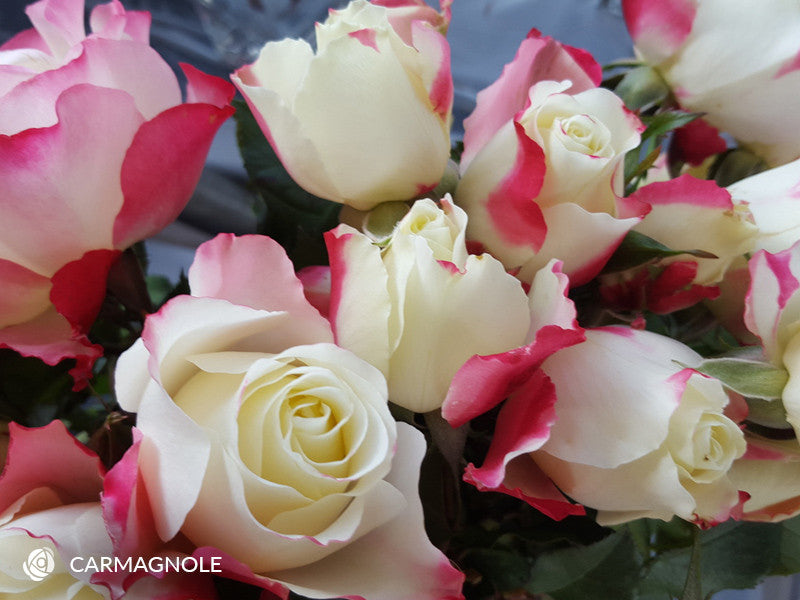 Bred by Delbard & Chabert, 1990, this delightful rose begs you to pick the buds and place them in a vase where they will slowly proceed to open and display a delightful cluster of stamens.
Bred by Delbard & Chabert, 1990, this delightful rose begs you to pick the buds and place them in a vase where they will slowly proceed to open and display a delightful cluster of stamens.
Carmagnole has deep cream flowers which fade to white and the outer petals are flushed with pleasant brush-strokes of medium pink which, as the flowers age, turn to very pale pink.
The bush is sturdy and extremely healthy – very, very large thorns in masses which make this a wonderful rose to plant as an impenetrable hedge-row which would keep both man and beast well away!
- White edged pink flowers of incredible perfection and beauty
- Extremely sturdy and free flowering shrub rose
- Ideal for mass planting where no man or beast should go
- Low maintenance, healthy shrub rose
CULTURAL NOTES:
The generally sunny, dry and hot conditions of the Australian garden are particularly well suited to planting roses and roses flourish in our gardens when you take measures to provide the following:
WATER – Roses are very deep rooted plants and require one good, deep soaking at least every 10 days in hot and dry conditions.
FEED – Because roses flower throughout all but the Winter season, they should be regularly fertilized with quality (preferably organic) fertilizer which contains a balance of major nutrients (NPK) and trace elements. The fertilizer should be applied at least once a month – small amount often – with fortnightly applications of liquid seaweed over the foliage.
PRUNE – During Winter, 70% of the rose plant should be pruned and all old wood removed back to the crown and the bush pruned to shape.
During the flowering seasons, 25% of all flowering stems should be cut back after flowering to encourage strong re-growth.
MULCH – Particular attention to application of lucerne or pea straw directly around the root-zone of each rose will enhance the overall health of the rose and then the whole bed should be mulched to 75mm with any other mulch medium available.
CELINE DELBARD – A DELBARD MODERN SHRUB ROSE PRODUCING THE MOST AMAZING ABUNDANCE OF BRIGHT SALMON-PINK BLOOMS CONTINUOUSLY.
 Bred by Delbard & Chabert, 1990, this delightful rose begs you to pick the buds and place them in a vase where they will slowly proceed to open and display a delightful cluster of stamens.
Bred by Delbard & Chabert, 1990, this delightful rose begs you to pick the buds and place them in a vase where they will slowly proceed to open and display a delightful cluster of stamens.
Carmagnole has deep cream flowers which fade to white and the outer petals are flushed with pleasant brush-strokes of medium pink which, as the flowers age, turn to very pale pink.
The bush is sturdy and extremely healthy – very, very large thorns in masses which make this a wonderful rose to plant as an impenetrable hedge-row which would keep both man and beast well away!
- White edged pink flowers of incredible perfection and beauty
- Extremely sturdy and free flowering shrub rose
- Ideal for mass planting where no man or beast should go
- Low maintenance, healthy shrub rose
CULTURAL NOTES:
The generally sunny, dry and hot conditions of the Australian garden are particularly well suited to planting roses and roses flourish in our gardens when you take measures to provide the following:
WATER – Roses are very deep rooted plants and require one good, deep soaking at least every 10 days in hot and dry conditions.
FEED – Because roses flower throughout all but the Winter season, they should be regularly fertilized with quality (preferably organic) fertilizer which contains a balance of major nutrients (NPK) and trace elements. The fertilizer should be applied at least once a month – small amount often – with fortnightly applications of liquid seaweed over the foliage.
PRUNE – During Winter, 70% of the rose plant should be pruned and all old wood removed back to the crown and the bush pruned to shape.
During the flowering seasons, 25% of all flowering stems should be cut back after flowering to encourage strong re-growth.
MULCH – Particular attention to application of lucerne or pea straw directly around the root-zone of each rose will enhance the overall health of the rose and then the whole bed should be mulched to 75mm with any other mulch medium available.
CHARLES DE GAULLE – HYBRID TEA ROSE, LARGE MULTI-PETALLED, UNIQUE WARM LILAC MAUVE/BLUE – ONE OF THE FINEST OF ALL THE OLDER MAUVE ROSES
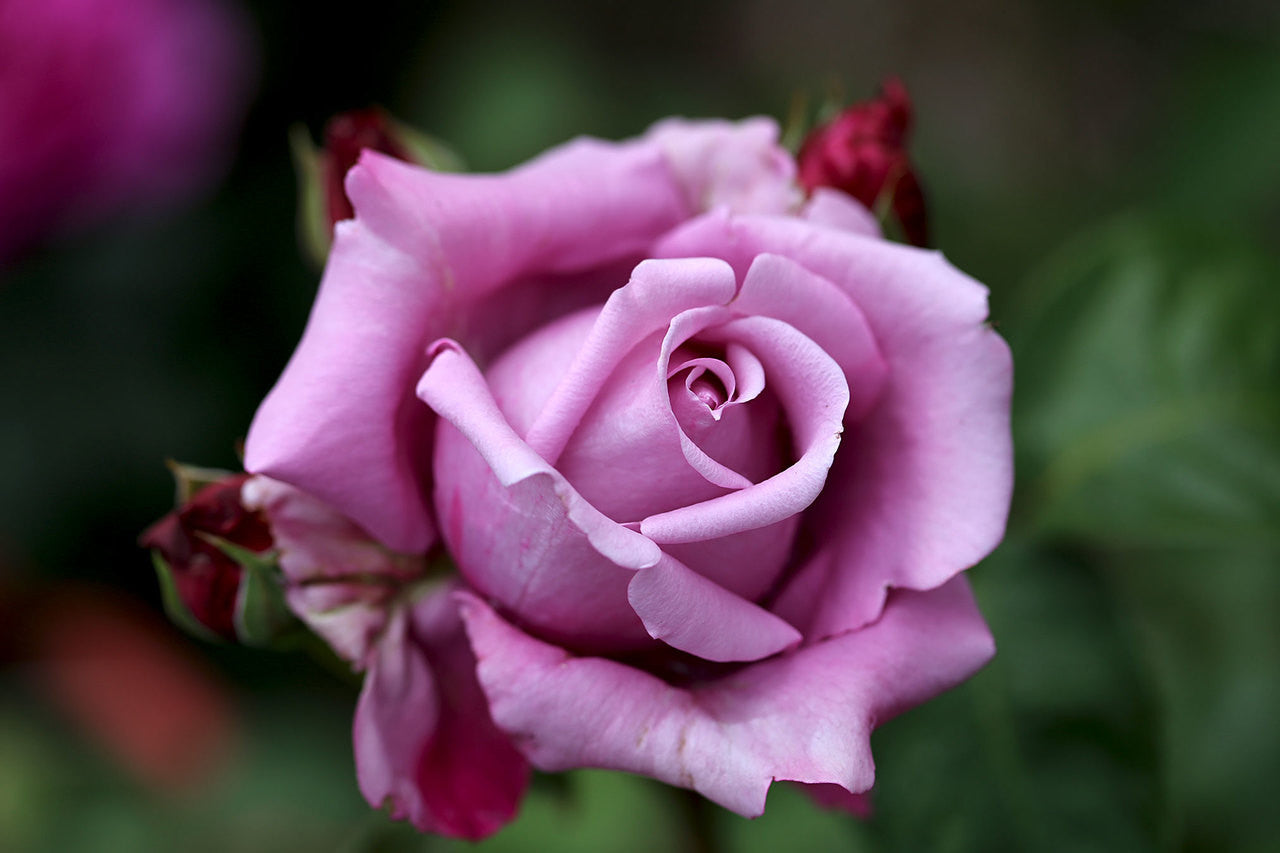 Another beautiful Hybrid Tea rose from the Meilland’s of France, this sensational rose has been available to rose gardeners in Australia since the mid 70’s. In New Zealand this rose is known as ‘Katherine Mansfield’ – one of their great writers. This rose was named after the renowned and great French Statesman “Charles de Gaulle”.
Another beautiful Hybrid Tea rose from the Meilland’s of France, this sensational rose has been available to rose gardeners in Australia since the mid 70’s. In New Zealand this rose is known as ‘Katherine Mansfield’ – one of their great writers. This rose was named after the renowned and great French Statesman “Charles de Gaulle”.
Charles de Gaulle is particularly suited to being grown as a standard rose because it has a natural shape where the branches grow wide of the bud union and form an urn. It is not a particularly tall growing rose – to 1.2mts and almost as broad. It flowers continuously throughout the season on a somewhat short stem and can form a cluster of perfectly formed, very highly fragrant blooms on thick stems … as such, one stem is perfect to give the appearance of a whole vase of flowers! Charles de Gaulle was awarded the Belfast Fragrance Prize in 1978 and is exceptionally healthy and free-flowering in hot weather – in humid or wet weather this beautiful rose will have a tendency to sulk and not produce the magnificent flowers we come to expect from such an exceptional Hybrid Tea rose which is claimed to be the finest mauve rose!
- One of the best old mauve roses
- Highly fragrant blooms continually
- Ideal to grow as a standard rose
- Strong, healthy foliage
CULTURAL NOTES:
The generally sunny, dry and hot conditions of the Australian garden are particularly well suited to planting roses and roses flourish in our gardens when you take measures to provide the following:
WATER – Roses are very deep rooted plants and require one good, deep soaking at least every 10 days in hot and dry conditions.
FEED – Because roses flower throughout all but the Winter season, they should be regularly fertilized with quality (preferably organic) fertilizer which contains a balance of major nutrients (NPK) and trace elements. The fertilizer should be applied at least once a month – small amount often – with fortnightly applications of liquid seaweed over the foliage.
PRUNE – During Winter, 70% of the rose plant should be pruned and all old wood removed back to the crown and the bush pruned to shape.
During the flowering seasons, 25% of all flowering stems should be cut back after flowering to encourage strong re-growth.
MULCH – Particular attention to application of lucerne or pea straw directly around the root-zone of each rose will enhance the overall health of the rose and then the whole bed should be mulched to 75mm with any other mulch medium available.
D
DOUBLE DELIGHT – CLASSICAL HYBRID TEA ROSE WITH LARGE DOUBLE, HIGH-CENTRED SINGLE-STEMMED BLOOMS OF CREAMY CENTRE WITH CARMINE/CERISE BORDER AND INTENSE SPICY FRAGRANCE
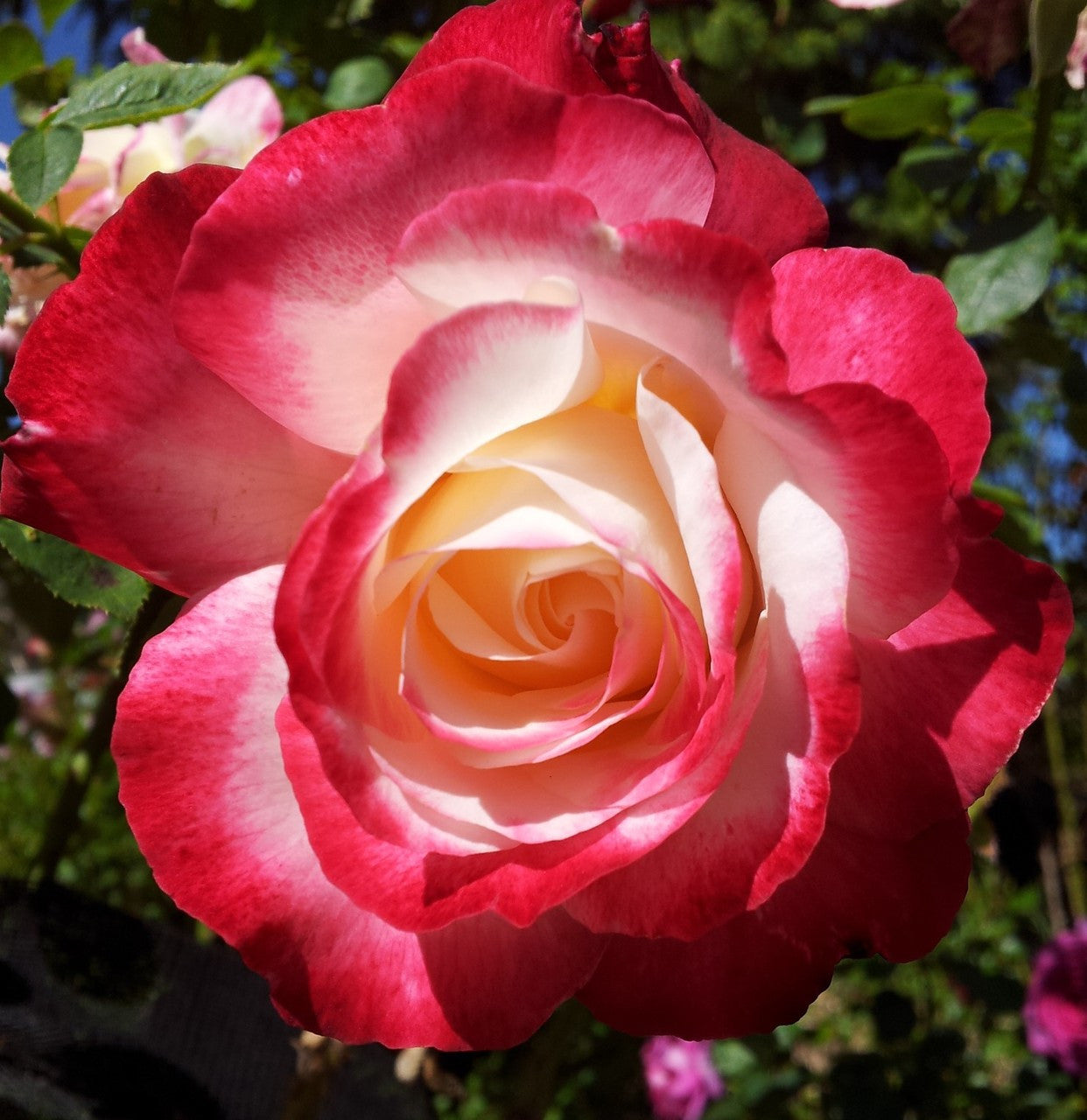 Bred in the USA by Swim & Ellis in 1976 this magnificent rose will be seen in gardens throughout Australia – popular mostly for the incredibly sweet perfume which is always evident and even a person with poor sense of smell will experience the pleasure of rose fragrance with this beauty. Double Delight has been a favourite rose with gardeners for many years and was inducted to the World Federation of Rose Societies, Rose Hall of Fame in 1985 being voted the people’s choice most popular rose in that year. It’s popularity is probably the cause of it’s demise as today, the bush is more difficult to grow because it has a lot of disease issues!
Bred in the USA by Swim & Ellis in 1976 this magnificent rose will be seen in gardens throughout Australia – popular mostly for the incredibly sweet perfume which is always evident and even a person with poor sense of smell will experience the pleasure of rose fragrance with this beauty. Double Delight has been a favourite rose with gardeners for many years and was inducted to the World Federation of Rose Societies, Rose Hall of Fame in 1985 being voted the people’s choice most popular rose in that year. It’s popularity is probably the cause of it’s demise as today, the bush is more difficult to grow because it has a lot of disease issues!
Double Delight is a bushy plant and can grow to 1.5mts – particularly loves the hot weather when the cerise border becomes very defined and the fragrance supreme. In humid, wet weather, Double Delight sulks and the blooms refuse to open; the foliage is very susceptible to black-spot so this rose should be planted with lots of air circulation and few or no other plants around it.
In 1983 Double Delight Climbing was released and our experience of this rose is that it produced lots of foliage but very few flowers so we cannot recommend it.
- Extremely distinct coloured cream with carmine border
- Very highly fragrant blooms
- Bushy growth
CULTURAL NOTES:
The generally sunny, dry and hot conditions of the Australian garden are particularly well suited to planting roses and roses flourish in our gardens when you take measures to provide the following:
WATER – Roses are very deep rooted plants and require one good, deep soaking at least every 10 days in hot and dry conditions.
FEED – Because roses flower throughout all but the Winter season, they should be regularly fertilized with quality (preferably organic) fertilizer which contains a balance of major nutrients (NPK) and trace elements. The fertilizer should be applied at least once a month – small amount often – with fortnightly applications of liquid seaweed over the foliage.
PRUNE – During Winter, 70% of the rose plant should be pruned and all old wood removed back to the crown and the bush pruned to shape.
During the flowering seasons, 25% of all flowering stems should be cut back after flowering to encourage strong re-growth.
MULCH – Particular attention to application of lucerne or pea straw directly around the root-zone of each rose will enhance the overall health of the rose and then the whole bed should be mulched to 75mm with any other mulch medium available
E
ELINA – HYBRID TEA ROSE WITH LARGE, HIGH CENTRED CREAMY PALE-YELLOW TO IVORY BLOOMS ON TALL, STRAIGHT STEMS WHICH FLOWERS CONTINUALLY
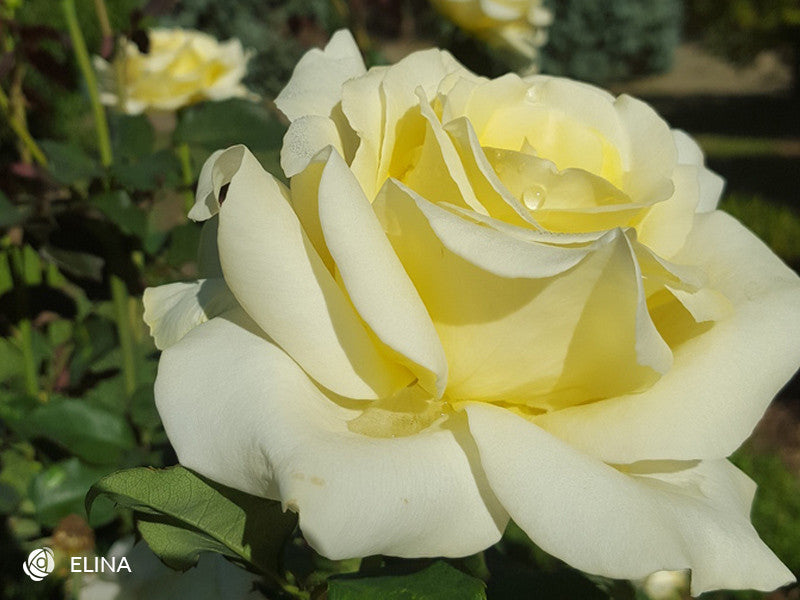 Bred by Dickson, UK, 1984, Elina commands recognition wherever she is planted by the robust height alone! Elina is a strong, vigorous bush with dark-green very disease-resistant foliage which adds enormous beauty as a foil for the huge, magnificently formed ivory blooms which are at least 15cms across and make perfect exhibition specimens, lasting very well in the vase. There is little fragrance.
Bred by Dickson, UK, 1984, Elina commands recognition wherever she is planted by the robust height alone! Elina is a strong, vigorous bush with dark-green very disease-resistant foliage which adds enormous beauty as a foil for the huge, magnificently formed ivory blooms which are at least 15cms across and make perfect exhibition specimens, lasting very well in the vase. There is little fragrance.
Elina was named ‘Peaudouce’ (for a nappy company in England) and thankfully this name was later changed! Elina was introduced to the World Rose Hall of Fame in 2006 and received many Gold Medal Awards in trial gardens around the world.
Elina can be grown as a standard rose specimen but must then be very well staked to accommodate the vigorous growth. The first Spring flush of roses is a little later than other roses but Elina makes up for this by producing masses of strong, single stemmed flowers abundantly right up until the Winter frosts, is not fussed about all weather conditions and enjoys the company of a host of companion plants because she will grow taller than most other plants anyway!
- A very highly recommended rose for any situation
- Extremely healthy, vigorous, robust and free flowering
- Large, long-stemmed blooms which last when vased
- Suitable to grow as a tall hedge-row
CULTURAL NOTES:
The generally sunny, dry and hot conditions of the Australian garden are particularly well suited to planting roses and roses flourish in our gardens when you take measures to provide the following:
WATER – Roses are very deep rooted plants and require one good, deep soaking at least every 10 days in hot and dry conditions.
FEED – Because roses flower throughout all but the Winter season, they should be regularly fertilized with quality (preferably organic) fertilizer which contains a balance of major nutrients (NPK) and trace elements. The fertilizer should be applied at least once a month – small amount often – with fortnightly applications of liquid seaweed over the foliage.
PRUNE – During Winter, 70% of the rose plant should be pruned and all old wood removed back to the crown and the bush pruned to shape.
During the flowering seasons, 25% of all flowering stems should be cut back after flowering to encourage strong re-growth.
MULCH – Particular attention to application of lucerne or pea straw directly around the root-zone of each rose will enhance the overall health of the rose and then the whole bed should be mulched to 75mm with any other mulch medium available.
F
FATHER’S LOVE – MODERN HYBRID TEA ROSE AND PERFECTLY NAMED ROSE TO REMEMBER THAT SPECIAL PERSON IN YOUR LIFE
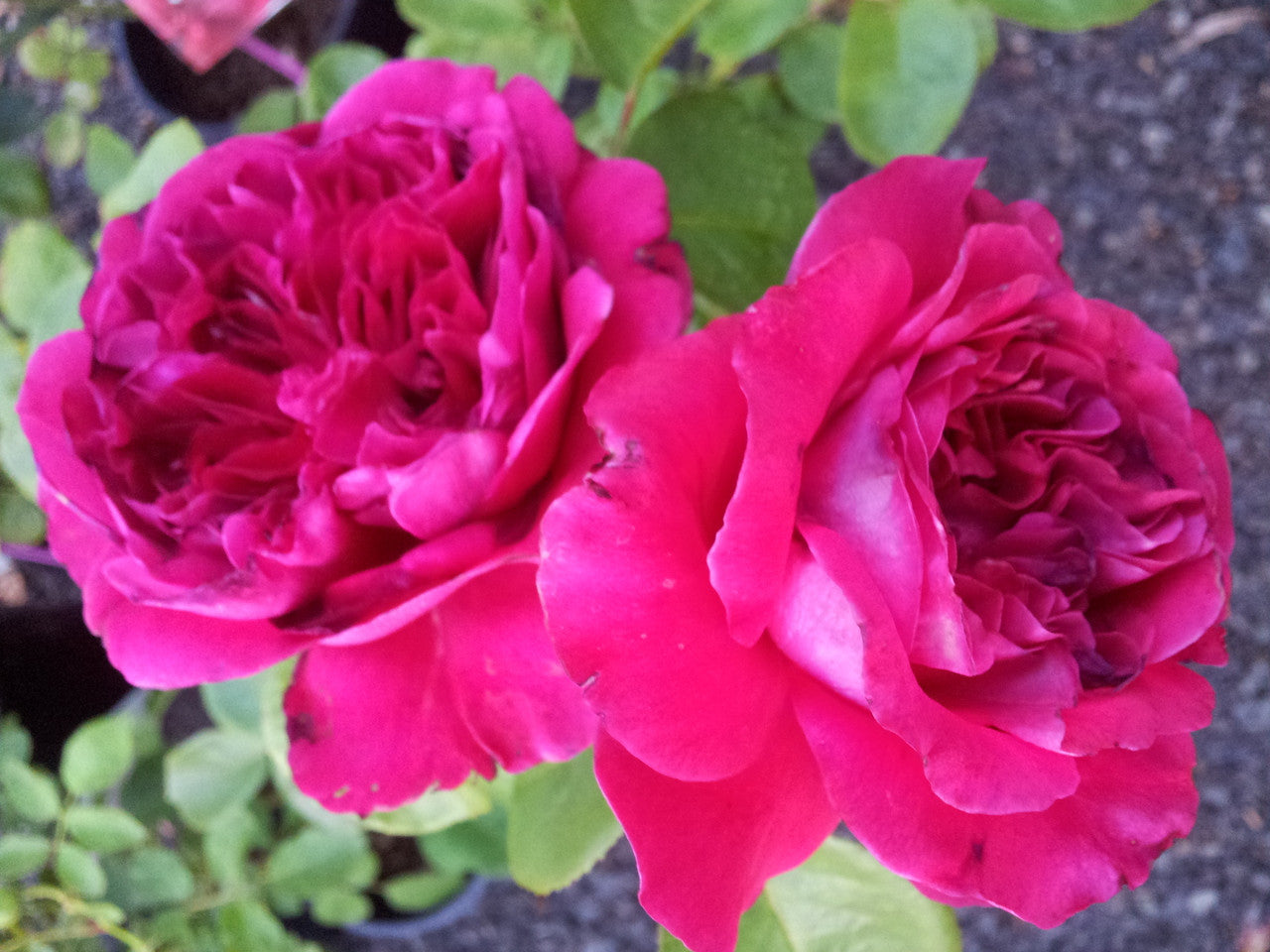 Bred by Meilland, France has rich, dark velvety red blooms in a classical Hybrid Tea bud and then the bloom reveals a massive swirl of petals deep in the bud as it opens.
Bred by Meilland, France has rich, dark velvety red blooms in a classical Hybrid Tea bud and then the bloom reveals a massive swirl of petals deep in the bud as it opens.
- Unusual swirling petals of rich dark red
- Wonderful spicy rose fragrance
- Excellent gift rose for any father
- Proceeds to Masonic Foundation
Father’s Love has a wonderful spicy rose fragrance and makes a spectacular long-lasting display in the vase. The bush is robust and healthy with lush dark-green foliage and will grow very well as a large pot specimen.
Proceeds from the sale of this ‘manly’ rose will go to the Masonic Foundation promoting awareness and the fight against prostate cancer.
- Unusual swirling petals of rich dark red
- Wonderful spicy rose fragrance
- Excellent gift rose for any father
- Proceeds to Masonic Foundation
CULTURAL NOTES:
The generally sunny, dry and hot conditions of the Australian garden are particularly well suited to planting roses and roses flourish in our gardens when you take measures to provide the following:
WATER – Roses are very deep rooted plants and require one good, deep soaking at least every 10 days in hot and dry conditions.
FEED – Because roses flower throughout all but the Winter season, they should be regularly fertilized with quality (preferably organic) fertilizer which contains a balance of major nutrients (NPK) and trace elements. The fertilizer should be applied at least once a month – small amount often – with fortnightly applications of liquid seaweed over the foliage.
PRUNE – During Winter, 70% of the rose plant should be pruned and all old wood removed back to the crown and the bush pruned to shape.
During the flowering seasons, 25% of all flowering stems should be cut back after flowering to encourage strong re-growth.
MULCH – Particular attention to application of lucerne or pea straw directly around the root-zone of each rose will enhance the overall health of the rose and then the whole bed should be mulched to 75mm with any other mulch medium available.
FIRE ‘N’ ICE – MODERN SHRUB ROSE/FLORIBUNDA ROSE WHICH HAS THE MOST DESCRIPTIVELY APPROPRIATE NAME
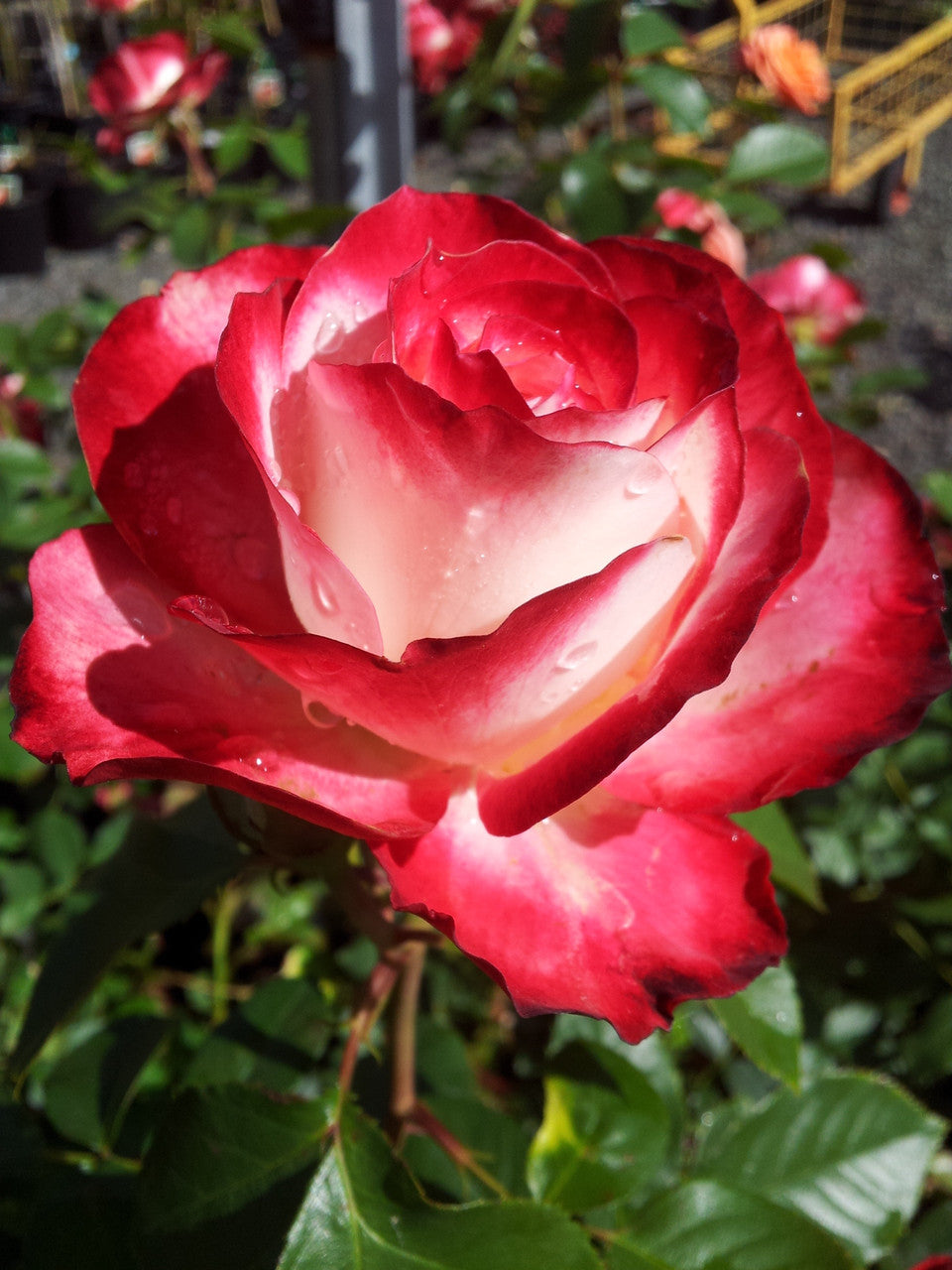 Fire ‘n’ Ice should be widely grown for it’s immense disease resistance. The foliage is lush and glossy dark green and makes a wonderful foil for the magnificent procession of strong stems of blooms all over the shrub.
Fire ‘n’ Ice should be widely grown for it’s immense disease resistance. The foliage is lush and glossy dark green and makes a wonderful foil for the magnificent procession of strong stems of blooms all over the shrub.
The flowers are very durable in the vase with one stem creating an impressive floral art decoration. Little fragrance.
- Very tough and exceedingly healthy
- Stunning and very showy masses of blooms
- Would make a magnificent hedge-row of constant colour
- Strong, glossy foliage
CULTURAL NOTES:
The generally sunny, dry and hot conditions of the Australian garden are particularly well suited to planting roses and roses flourish in our gardens when you take measures to provide the following:
WATER – Roses are very deep rooted plants and require one good, deep soaking at least every 10 days in hot and dry conditions.
FEED – Because roses flower throughout all but the Winter season, they should be regularly fertilized with quality (preferably organic) fertilizer which contains a balance of major nutrients (NPK) and trace elements. The fertilizer should be applied at least once a month – small amount often – with fortnightly applications of liquid seaweed over the foliage.
PRUNE – During Winter, 70% of the rose plant should be pruned and all old wood removed back to the crown and the bush pruned to shape.
During the flowering seasons, 25% of all flowering stems should be cut back after flowering to encourage strong re-growth.
MULCH – Particular attention to application of lucerne or pea straw directly around the root-zone of each rose will enhance the overall health of the rose and then the whole bed should be mulched to 75mm with any other mulch medium available.
FIREFIGHTER – HYBRID TEA ROSE IS WHAT I PERSONALLY HAVE BEEN WAITING FOR – A FRAGRANT DARK RED ROSE WITH VERY FEW THORNS!
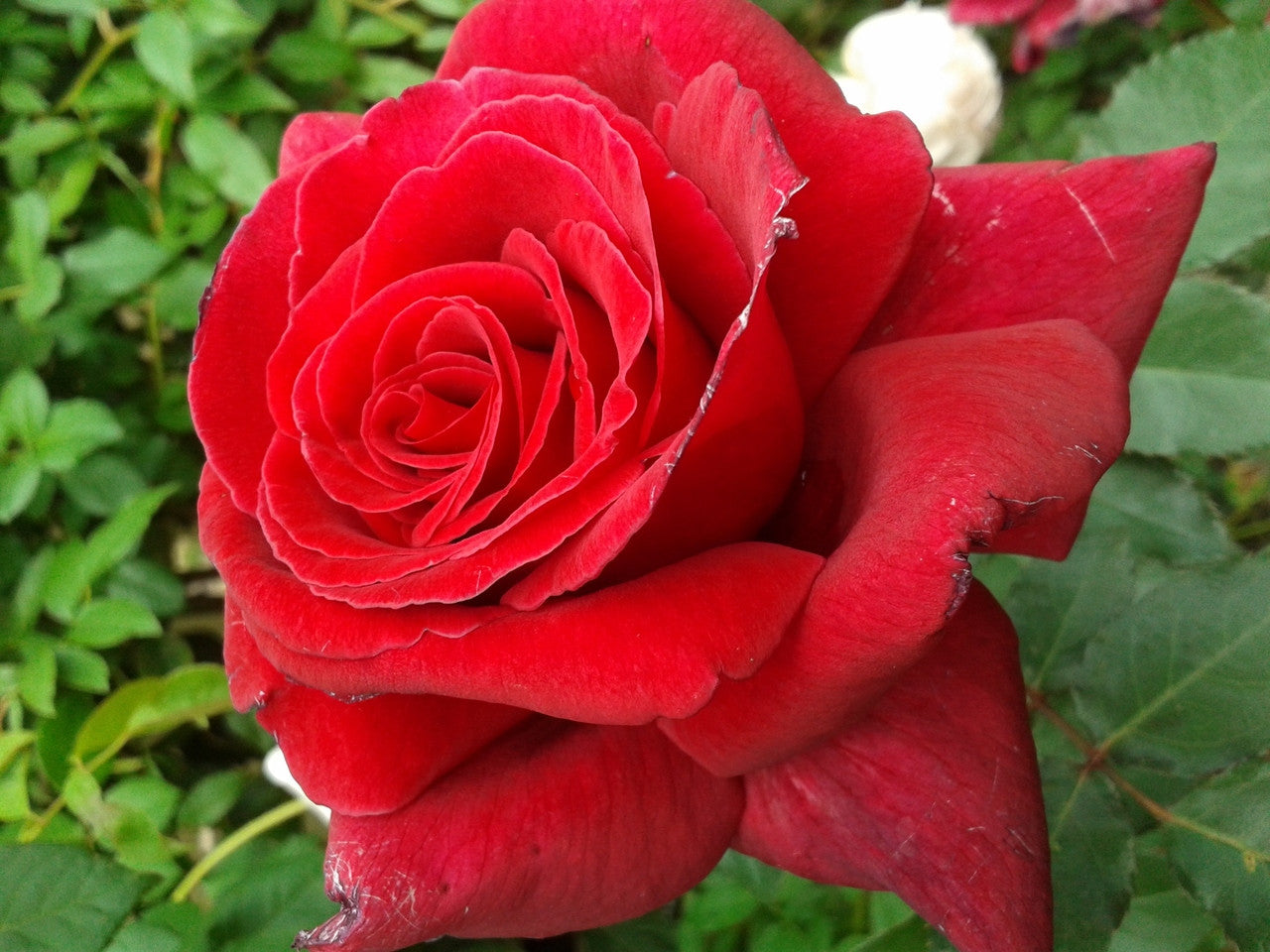 Bred by Joseph Orard prior to 1998 and introduced to Australia in 2009 this glorious specimen with tall single stems of the most highly fragrant dark red rose which is suitable to work with in floral art and yet easy to grow in the open garden will be a joy to all rose gardeners. The men will rush out to buy it because it has so very few thorns and tell us in the nursery that they just love the red roses … we know it’s all about the lack of thorns even though we also know that men prefer their garden roses to be red!
Bred by Joseph Orard prior to 1998 and introduced to Australia in 2009 this glorious specimen with tall single stems of the most highly fragrant dark red rose which is suitable to work with in floral art and yet easy to grow in the open garden will be a joy to all rose gardeners. The men will rush out to buy it because it has so very few thorns and tell us in the nursery that they just love the red roses … we know it’s all about the lack of thorns even though we also know that men prefer their garden roses to be red!
As much as anything, Firefighter will be purchased to commemorate the wonderful work our firefighters do here in Australia and as it states on the plant label: “This rose is so named as to remember those men and women who risk their lives daily to protect ours”. Quirky interesting fact: This rose was planned for release in the Winter of 2009 AFTER the Black Saturday fires and is quite separate to the CFA Firestar series of roses which commenced release in 2010!
- Highly fragrant, very dark red rose
- Very suited to floral art because few thorns on picking stems
- Commemorative rose for Firefighters across Australia
CULTURAL NOTES:
The generally sunny, dry and hot conditions of the Australian garden are particularly well suited to planting roses and roses flourish in our gardens when you take measures to provide the following:
WATER – Roses are very deep rooted plants and require one good, deep soaking at least every 10 days in hot and dry conditions.
FEED – Because roses flower throughout all but the Winter season, they should be regularly fertilized with quality (preferably organic) fertilizer which contains a balance of major nutrients (NPK) and trace elements. The fertilizer should be applied at least once a month – small amount often – with fortnightly applications of liquid seaweed over the foliage.
PRUNE – During Winter, 70% of the rose plant should be pruned and all old wood removed back to the crown and the bush pruned to shape.
During the flowering seasons, 25% of all flowering stems should be cut back after flowering to encourage strong re-growth.
MULCH – Particular attention to application of lucerne or pea straw directly around the root-zone of each rose will enhance the overall health of the rose and then the whole bed should be mulched to 75mm with any other mulch medium available.
G
GOLD BUNNY – FLORIBUNDA ROSE WHICH SPORTED OUT TO A CLIMBING ROSE – WARM YELLOW, FULL PETALLED BLOOMS IN ABUNDANCE OVER THE WHOLE FLOWERING SEASON
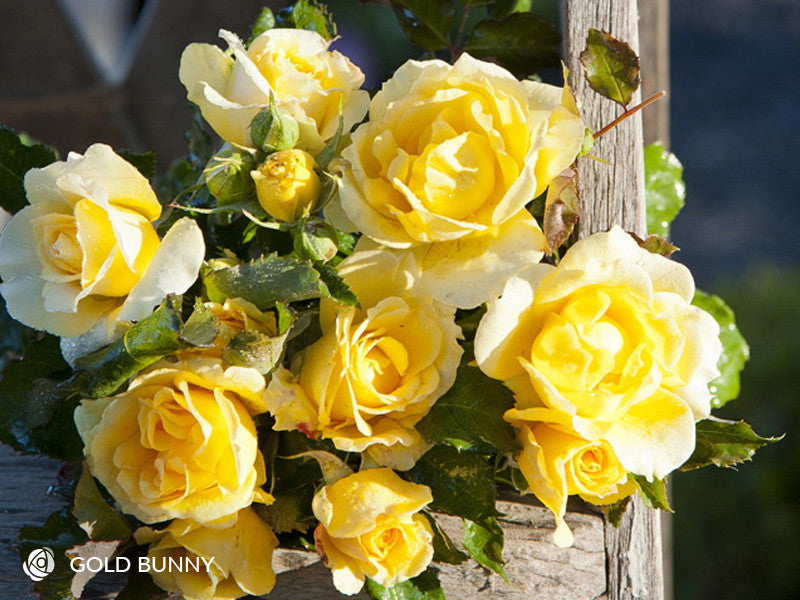 Bred by Paolino, France, 1978 with the climbing version also introduced by Meilland in 1991 this magnificent rose is one of the significant heralds that Spring is sprung and once Gold Bunny starts flowering, it literally does not stop. There is an abundance of large, fluffy and warm golden yellow blooms which fade to cream on a short bush with lush mid-green, healthy foliage.
Bred by Paolino, France, 1978 with the climbing version also introduced by Meilland in 1991 this magnificent rose is one of the significant heralds that Spring is sprung and once Gold Bunny starts flowering, it literally does not stop. There is an abundance of large, fluffy and warm golden yellow blooms which fade to cream on a short bush with lush mid-green, healthy foliage.
Gold Bunny is an ideal standard rose because it is a moderate grower with a lovely urn-shaped growth habit.
This is definitely a rose which loves attention in the form of regular fertilizing and foliage applications of liquid seaweed – if you treat this rose with the loving it deserves, it will reward you by being the biggest show-off. The fertilizer should be applied while Gold Bunny is in full flower and that way, she doesn’t collapse under the pressure of producing such a magnificent display of blooms … but sheds cleanly and presses on to produce the next round of flowers.
- Extraordinarily free flowering golden yellow blooms throughout the season
- Ideal for borders and as a standard rose
- Stunning climbing rose
- Very healthy enjoying copious feeding and TLC
CULTURAL NOTES:
The generally sunny, dry and hot conditions of the Australian garden are particularly well suited to planting roses and roses flourish in our gardens when you take measures to provide the following:
WATER – Roses are very deep rooted plants and require one good, deep soaking at least every 10 days in hot and dry conditions.
FEED – Because roses flower throughout all but the Winter season, they should be regularly fertilized with quality (preferably organic) fertilizer which contains a balance of major nutrients (NPK) and trace elements. The fertilizer should be applied at least once a month – small amount often – with fortnightly applications of liquid seaweed over the foliage.
PRUNE – During Winter, 70% of the rose plant should be pruned and all old wood removed back to the crown and the bush pruned to shape.
During the flowering seasons, 25% of all flowering stems should be cut back after flowering to encourage strong re-growth.
MULCH – Particular attention to application of lucerne or pea straw directly around the root-zone of each rose will enhance the overall health of the rose and then the whole bed should be mulched to 75mm with any other mulch medium available.
GOLDEN CELEBRATION – DAVID AUSTIN MODERN SHRUB ROSE WHICH CAN ALSO BE GROWN AS A CLIMBER AGAINST A WALL OR SUPPORTED BY A PILLAR FRAME
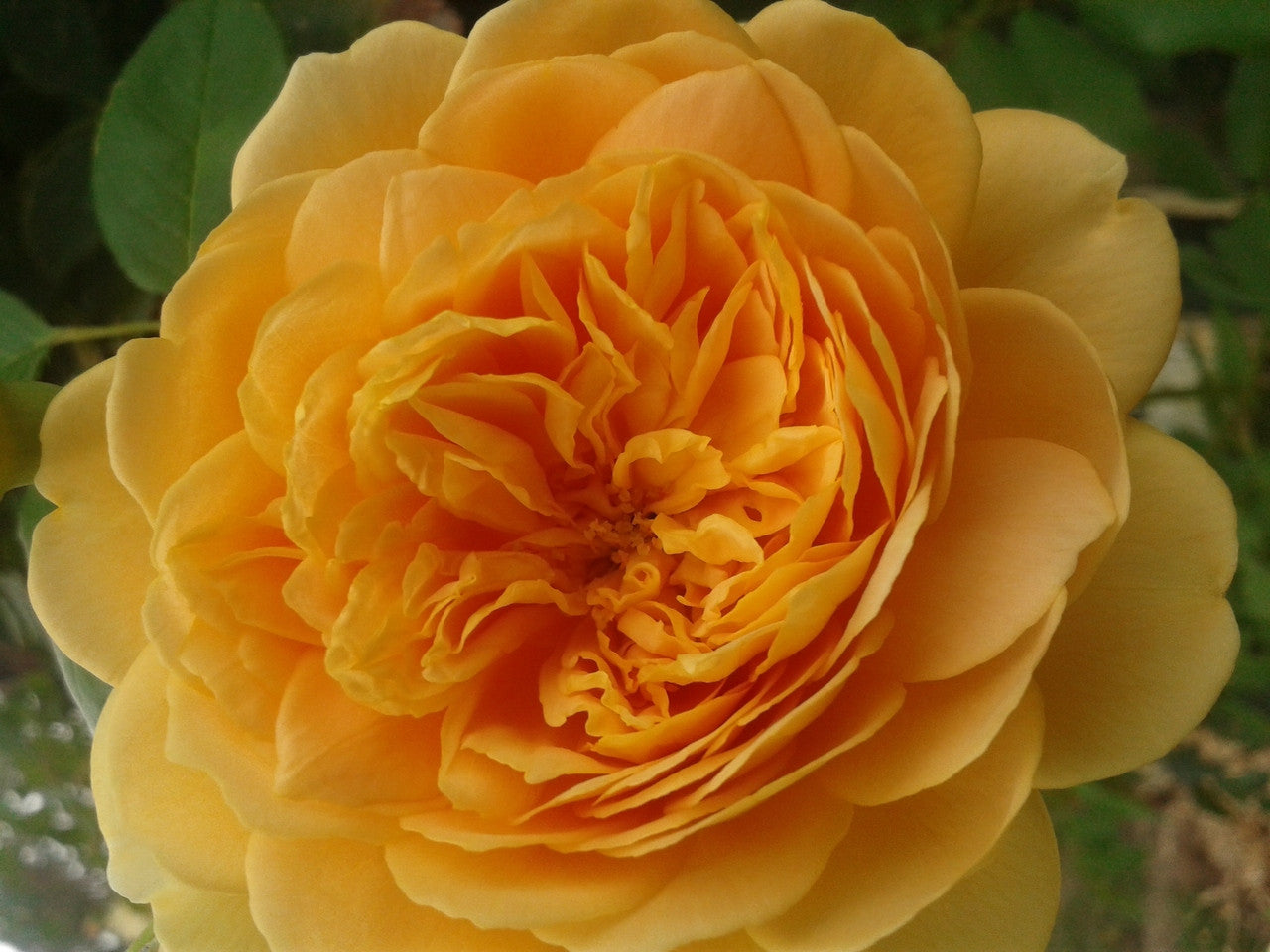 Bred by David Austin, 1992 this magnificent rose has two sensational parents and they are both climbing roses here is Australia’s warm climate – Charles Austin and Abraham Darby.
Bred by David Austin, 1992 this magnificent rose has two sensational parents and they are both climbing roses here is Australia’s warm climate – Charles Austin and Abraham Darby.
Golden Celebration is widely sought after for the name – a wonderful gift on the occasion of a Golden Wedding Anniversary and I have never heard a single complaint about this rose!
From the plumpest large buds the huge warm golden blooms emerge with a wonderful fruity fragrance and continue to flower throughout the entire season unaffected by all the weather conditions Mother Nature can deliver – the flowers just nod in the rain! The dark, glossy foliage is a wonderful foil for the golden blooms.
- Gorgeous rose to gift for Golden Wedding Anniversary
- Strong English Rose fragrance
- Tolerant of all weather
- Very healthy and free flowering throughout the season
CULTURAL NOTES:
The generally sunny, dry and hot conditions of the Australian garden are particularly well suited to planting roses and roses flourish in our gardens when you take measures to provide the following:
WATER – Roses are very deep rooted plants and require one good, deep soaking at least every 10 days in hot and dry conditions.
FEED – Because roses flower throughout all but the Winter season, they should be regularly fertilized with quality (preferably organic) fertilizer which contains a balance of major nutrients (NPK) and trace elements. The fertilizer should be applied at least once a month – small amount often – with fortnightly applications of liquid seaweed over the foliage.
PRUNE – During Winter, 70% of the rose plant should be pruned and all old wood removed back to the crown and the bush pruned to shape.
During the flowering seasons, 25% of all flowering stems should be cut back after flowering to encourage strong re-growth.
MULCH – Particular attention to application of lucerne or pea straw directly around the root-zone of each rose will enhance the overall health of the rose and then the whole bed should be mulched to 75mm with any other mulch medium available.
GRIMALDI – FLORIBUNDA/MODERN SHRUB ROSE WITH SPLASHES OF PALE CREAMY SALMON-PINK WITH FLECKS OF DARKER SALMON-PINK, CONSTANTLY IN FLOWER
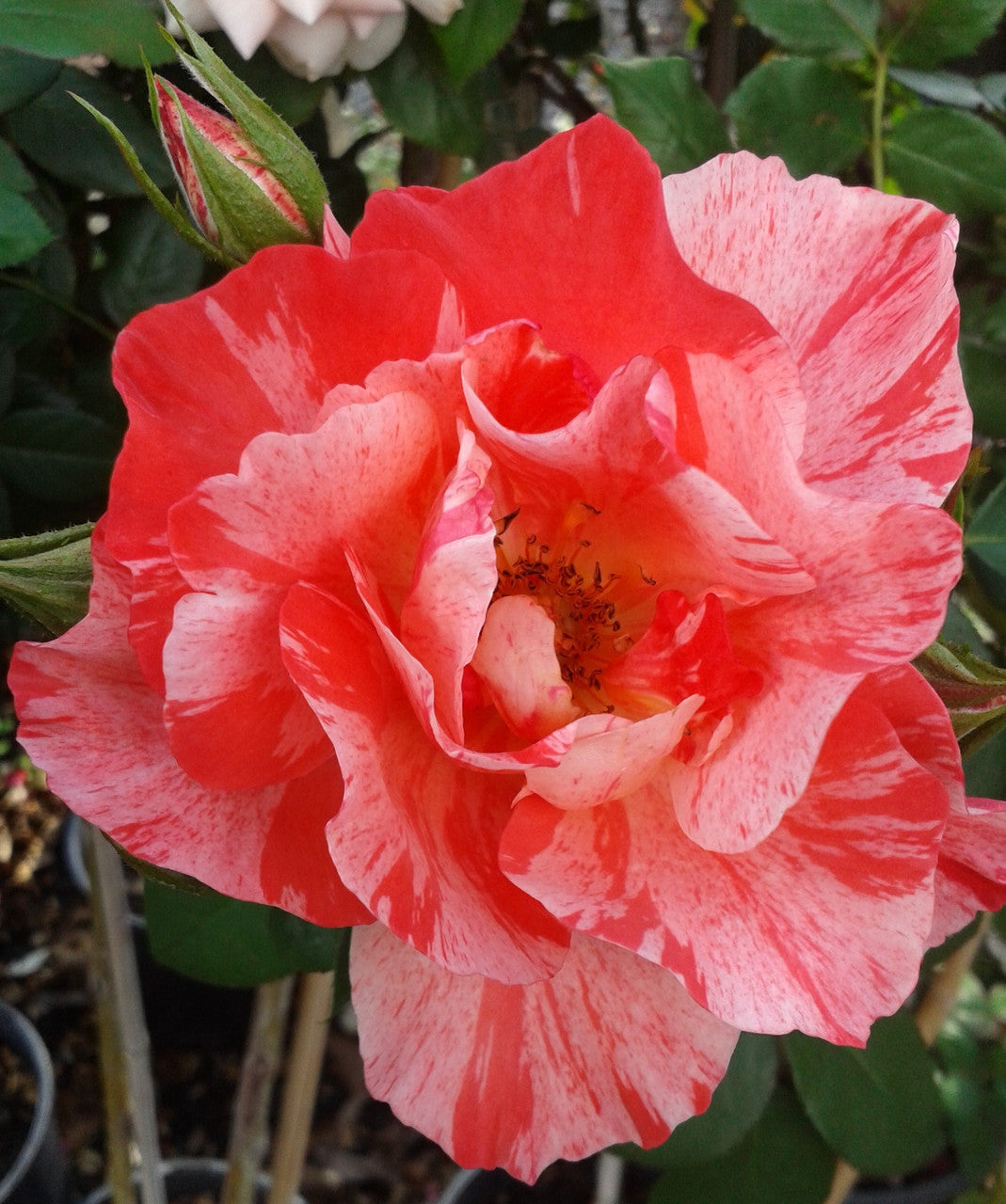 Introduced by Delbard in 1997 and sharing the name of Prince Rainier of Monaco, Grimaldi leaves a lasting impression of the exceptionally elegant beauty of Princess Grace of Monaco – delicate but strong. This robust and highly disease-resistant shrub rose which flowers from season start to season end and all the way in between, is a magnificent sight when planted in groups so that the flowering bracts can be supported and pushed upwards by each other.
Introduced by Delbard in 1997 and sharing the name of Prince Rainier of Monaco, Grimaldi leaves a lasting impression of the exceptionally elegant beauty of Princess Grace of Monaco – delicate but strong. This robust and highly disease-resistant shrub rose which flowers from season start to season end and all the way in between, is a magnificent sight when planted in groups so that the flowering bracts can be supported and pushed upwards by each other.
Not caring about what the weather is, this magnificent shrub rose grows easily to 1.5mts and 1.2mts wide and just continues to produce branching canes of deep green foliage loaded with single, open and lightly fragrant blooms which, when cut, are very long-lasting in the vase.
Grimaldi is ideal for planting as a rose hedge-row, certainly en masse and should be pruned accordingly – with a mechanical hedger or shears.
- Highly disease resistant and easy-care rose
- Ideal for group and rose hedge-row planting
- Unusual salmon-pink-cream combination of colour
- Very low maintenance rose
CULTURAL NOTES:
The generally sunny, dry and hot conditions of the Australian garden are particularly well suited to planting roses and roses flourish in our gardens when you take measures to provide the following:
WATER – Roses are very deep rooted plants and require one good, deep soaking at least every 10 days in hot and dry conditions.
FEED – Because roses flower throughout all but the Winter season, they should be regularly fertilized with quality (preferably organic) fertilizer which contains a balance of major nutrients (NPK) and trace elements. The fertilizer should be applied at least once a month – small amount often – with fortnightly applications of liquid seaweed over the foliage.
PRUNE – During Winter, 70% of the rose plant should be pruned and all old wood removed back to the crown and the bush pruned to shape.
During the flowering seasons, 25% of all flowering stems should be cut back after flowering to encourage strong re-growth.
MULCH – Particular attention to application of lucerne or pea straw directly around the root-zone of each rose will enhance the overall health of the rose and then the whole bed should be mulched to 75mm with any other mulch medium available.
H
HAPPY ANNIVERSARY – MODERN HYBRID TEA ROSE WITH THE MOST UNUSUAL COLOURINGS OF RED MUSHED WITH APRICOT – A STAND-ALONG COLOUR IN THE ROSE GARDEN
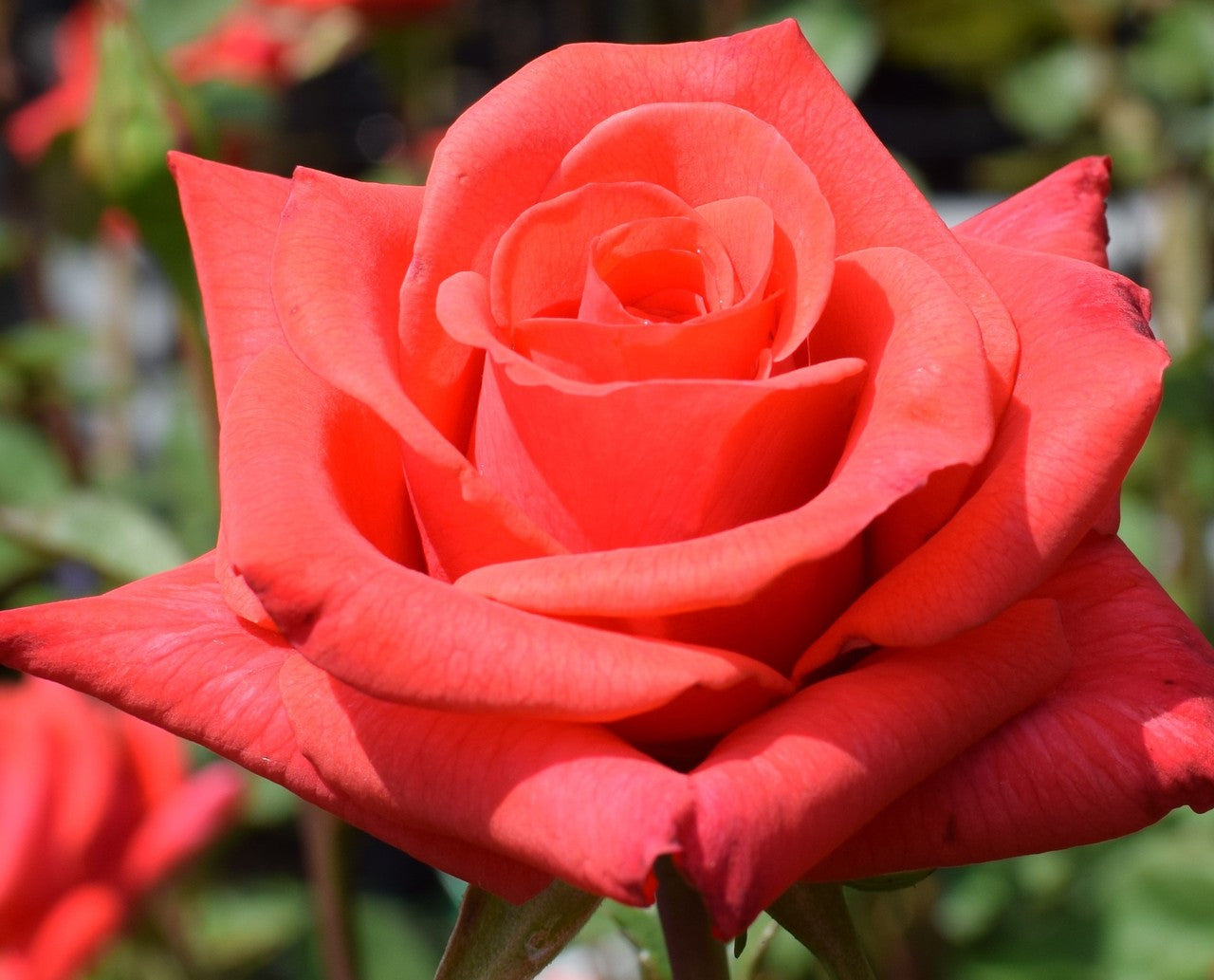 A sport of ‘Kardinal’ discovered by Graeme Catt and released in 2000 this lovely rose is the most appropriate gift on the occasion of a wedding anniversary and will continue to remind the recipient of their special day by producing the most amazing number of blooms that are neither red nor orange but a blend of both with some apricot thrown in just to give a subtle loveliness to what might otherwise be a harsh colour.
A sport of ‘Kardinal’ discovered by Graeme Catt and released in 2000 this lovely rose is the most appropriate gift on the occasion of a wedding anniversary and will continue to remind the recipient of their special day by producing the most amazing number of blooms that are neither red nor orange but a blend of both with some apricot thrown in just to give a subtle loveliness to what might otherwise be a harsh colour.
Happy Anniversary, like the parent sport, ‘Kardinal’ produces the most perfect Hybrid Tea shaped blooms with such enormous consistency and continuity – every bloom is perfect for the vase and once in the vase, will last and last.
The bush is very healthy with strong leathery, dark green foliage and the bush will grow to around 1.2 metres – you cannot resist picking the flowers for a vase!
- Delightfully named rose for anniversary gift
- Stunning colour of red/orange – not harsh
- Blooms of magnificent HT form
- Prolific, healthy and free flowering
CULTURAL NOTES:
The generally sunny, dry and hot conditions of the Australian garden are particularly well suited to planting roses and roses flourish in our gardens when you take measures to provide the following:
WATER – Roses are very deep rooted plants and require one good, deep soaking at least every 10 days in hot and dry conditions.
FEED – Because roses flower throughout all but the Winter season, they should be regularly fertilized with quality (preferably organic) fertilizer which contains a balance of major nutrients (NPK) and trace elements. The fertilizer should be applied at least once a month – small amount often – with fortnightly applications of liquid seaweed over the foliage.
PRUNE – During Winter, 70% of the rose plant should be pruned and all old wood removed back to the crown and the bush pruned to shape.
During the flowering seasons, 25% of all flowering stems should be cut back after flowering to encourage strong re-growth.
MULCH – Particular attention to application of lucerne or pea straw directly around the root-zone of each rose will enhance the overall health of the rose and then the whole bed should be mulched to 75mm with any other mulch medium available.
HENRI MATISSE – FLORIBUNDA/MODERN SHRUB ROSE WHICH IS NOW WIDELY PRODUCED AS A CUT FLOWER FOR FLORISTS
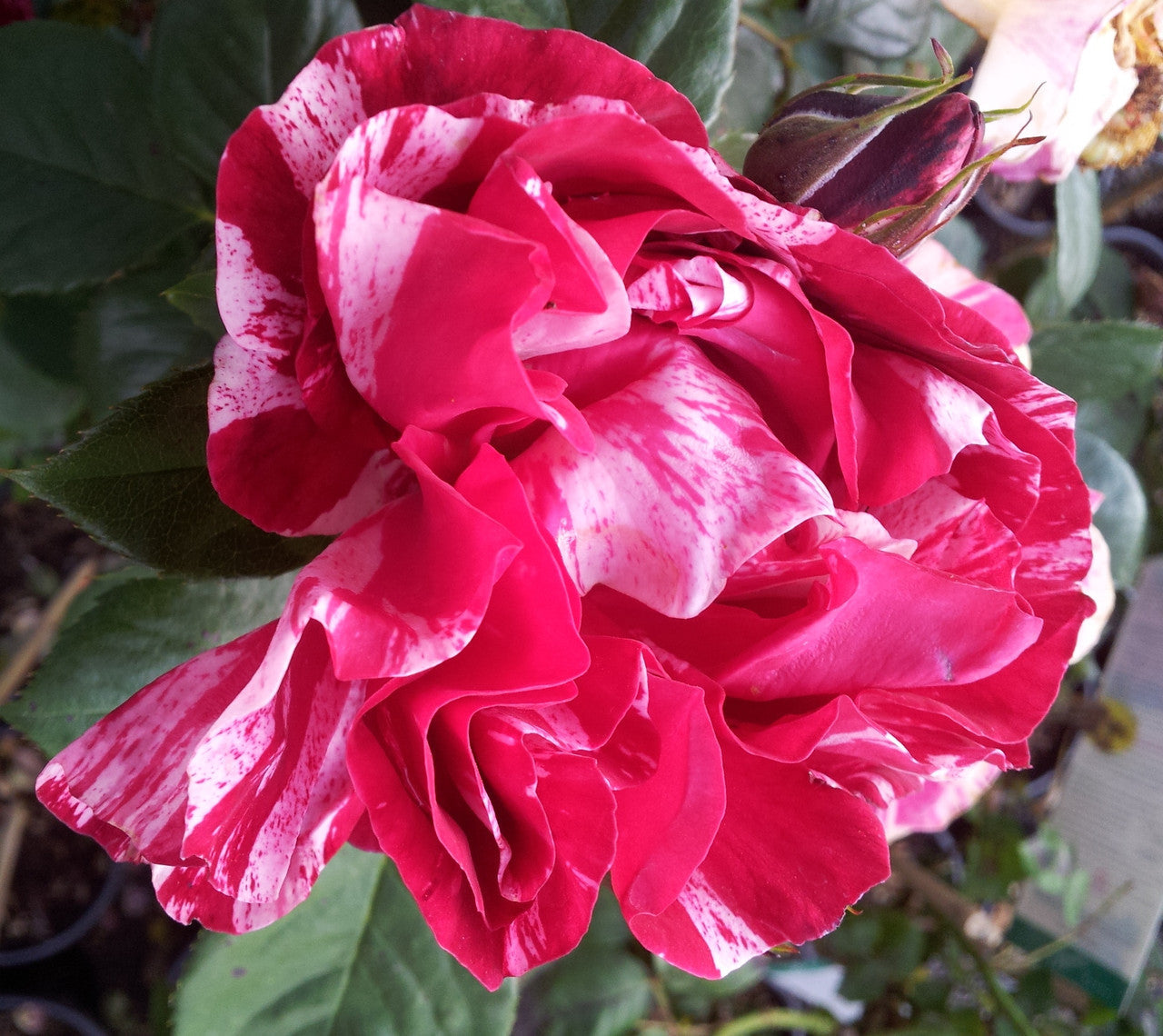 Bred by Georges Delbard, France and released in 1996, this relatively new rose in Australia has enjoyed the publicity of the Delbard roses and this beauty is particularly favoured because it does so well as a cut flower specimen.
Bred by Georges Delbard, France and released in 1996, this relatively new rose in Australia has enjoyed the publicity of the Delbard roses and this beauty is particularly favoured because it does so well as a cut flower specimen.
The dark cerise/red petals are slashed with bars of white and no two blooms are identical so the bush in a garden border, growing to around 1metre in height, is a constant reminder of how interesting roses continue to be!
Henri Matisse is included in the Delbard “Painters Collection” since there is a random but distinct link between the Impressionist Masterpieces and the style and colours of the roses in this series – each bloom neither the same, nor entirely different!
For a massive ‘take a look at me’ garden in the front of your home, plant a garden bed of Henri Matisse – use the standard form for greater height and watch your neighbours gasp with delight.
- Swirling mass of cerise/red and slashes of white
- Exceedingly healthy rose
- Masses and masses of repeat blooms
- Ideal cut flower rose
CULTURAL NOTES:
The generally sunny, dry and hot conditions of the Australian garden are particularly well suited to planting roses and roses flourish in our gardens when you take measures to provide the following:
WATER – Roses are very deep rooted plants and require one good, deep soaking at least every 10 days in hot and dry conditions.
FEED – Because roses flower throughout all but the Winter season, they should be regularly fertilized with quality (preferably organic) fertilizer which contains a balance of major nutrients (NPK) and trace elements. The fertilizer should be applied at least once a month – small amount often – with fortnightly applications of liquid seaweed over the foliage.
PRUNE – During Winter, 70% of the rose plant should be pruned and all old wood removed back to the crown and the bush pruned to shape.
During the flowering seasons, 25% of all flowering stems should be cut back after flowering to encourage strong re-growth.
MULCH – Particular attention to application of lucerne or pea straw directly around the root-zone of each rose will enhance the overall health of the rose and then the whole bed should be mulched to 75mm with any other mulch medium available.
HONEY DIJON – HYBRID TEA ROSE OF A MOST UNCOMMON WARM, GOLDEN BROWN COLOUR WITH PINK TINGES AT THE PETAL ENDS IN COOL WEATHER
 Introduced by Weeks Roses in 2005 (bred by James Sproul), Honey Dijon is outstandingly healthy and disease-resistant which makes it possible for the home-gardener to grow this novelty-coloured rose when most earlier roses with ‘brown’ tones were difficult to grow.
Introduced by Weeks Roses in 2005 (bred by James Sproul), Honey Dijon is outstandingly healthy and disease-resistant which makes it possible for the home-gardener to grow this novelty-coloured rose when most earlier roses with ‘brown’ tones were difficult to grow.
The glossy dark green foliage is a beautiful foil for the heads of flowers which have a magnificently strong, fruity fragrance and are long-lasting when picked for the vase – one could be forgiven for thinking the flowers are made of silk, such is the unusual colour of Honey Dijon.
As the flowers of Honey Dijon fully open, the swirling mass of petals add a delightful dimension to all the other beautiful qualities of this lovely rose.
- Healthy and disease resistant
- Delightful fruity fragrance
- Stunning golden brown tinged pink
- Ideal and unusual colour for flower arrangements
CULTURAL NOTES:
The generally sunny, dry and hot conditions of the Australian garden are particularly well suited to planting roses and roses flourish in our gardens when you take measures to provide the following:
WATER – Roses are very deep rooted plants and require one good, deep soaking at least every 10 days in hot and dry conditions.
FEED – Because roses flower throughout all but the Winter season, they should be regularly fertilized with quality (preferably organic) fertilizer which contains a balance of major nutrients (NPK) and trace elements. The fertilizer should be applied at least once a month – small amount often – with fortnightly applications of liquid seaweed over the foliage.
PRUNE – During Winter, 70% of the rose plant should be pruned and all old wood removed back to the crown and the bush pruned to shape.
During the flowering seasons, 25% of all flowering stems should be cut back after flowering to encourage strong re-growth.
MULCH – Particular attention to application of lucerne or pea straw directly around the root-zone of each rose will enhance the overall health of the rose and then the whole bed should be mulched to 75mm with any other mulch medium available.
HOT COCOA – FLORIBUNDA ROSE WHICH HAS THE MOST UNUSUAL RANGE OF COLOURS FROM ORANGE BUDS TO CHOCOLATE TO MAUVE
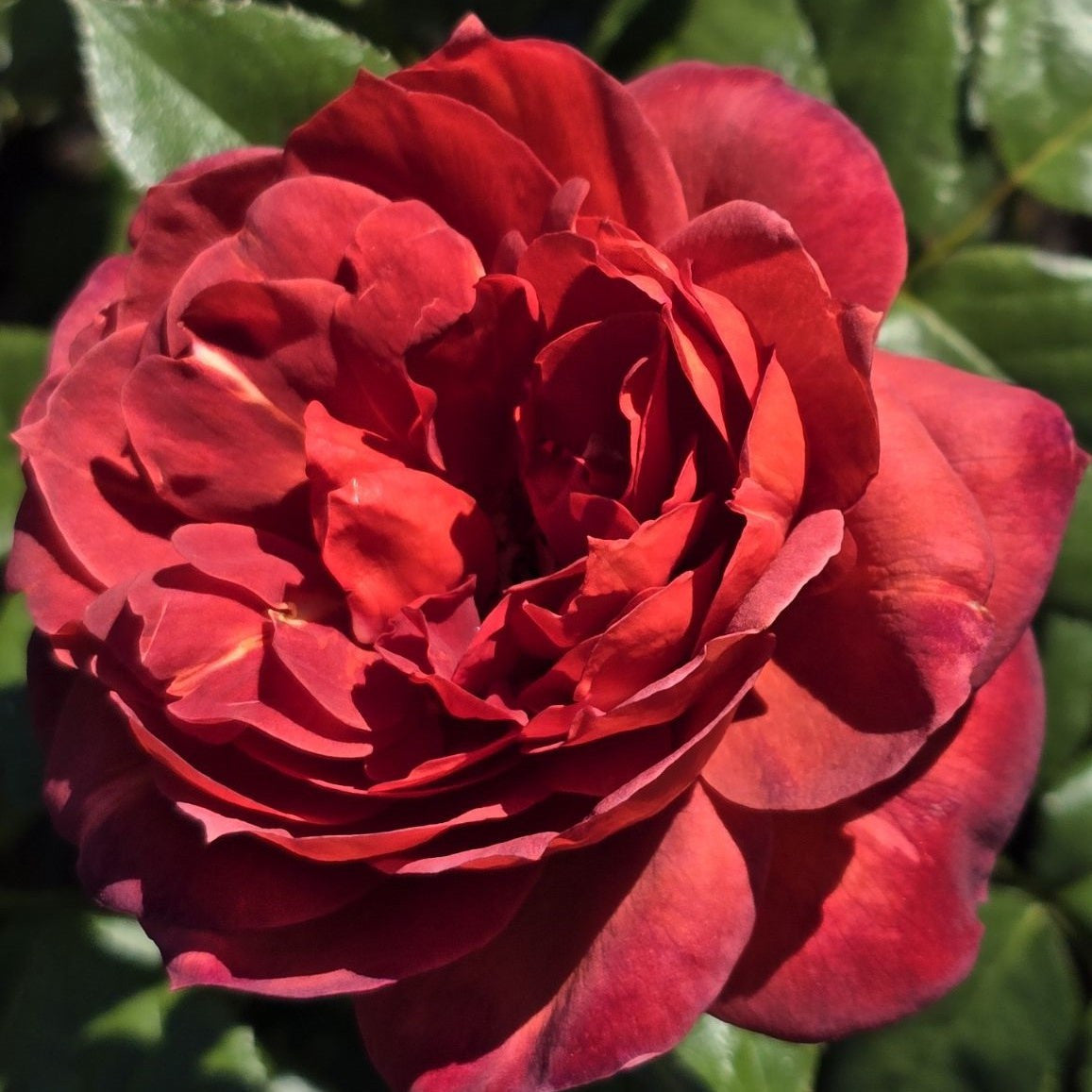 Bred by Tom Carruth, USA, 2001 this extraordinary rose should never be planted at the back of the rose garden because you will be drawn to the most unusual array of colours every time you visit with it … early in the season, the buds can be quite orange on the outer petals however, the surprise is when the bud opens, the petals are distinctly brown and then as they age, they turn are dusky, muddy mauve .. so very pretty at all stages and when the bush is in full bloom, the colour range is amazing!
Bred by Tom Carruth, USA, 2001 this extraordinary rose should never be planted at the back of the rose garden because you will be drawn to the most unusual array of colours every time you visit with it … early in the season, the buds can be quite orange on the outer petals however, the surprise is when the bud opens, the petals are distinctly brown and then as they age, they turn are dusky, muddy mauve .. so very pretty at all stages and when the bush is in full bloom, the colour range is amazing!
Hot Cocoa is outstandingly disease resistant with glossy, glossy foliage which adds to its eclectic beauty. The bush habit is rather upright and I would be sure that if pushed against a wall and wasn’t pruned, this bush would create quite a spectacular pillar/climbing rose.
There’s no great perfume but Hot Cocoa is a highly recommended rose to plant for its unusual range of colours.
- Stunning range of colours from orange/mauve/purple
- Extremely healthy glossy foliage
- Rather upright growth which could create a pillar
- Highly recommended rose
CULTURAL NOTES:
The generally sunny, dry and hot conditions of the Australian garden are particularly well suited to planting roses and roses flourish in our gardens when you take measures to provide the following:
WATER – Roses are very deep rooted plants and require one good, deep soaking at least every 10 days in hot and dry conditions.
FEED – Because roses flower throughout all but the Winter season, they should be regularly fertilized with quality (preferably organic) fertilizer which contains a balance of major nutrients (NPK) and trace elements. The fertilizer should be applied at least once a month – small amount often – with fortnightly applications of liquid seaweed over the foliage.
PRUNE – During Winter, 70% of the rose plant should be pruned and all old wood removed back to the crown and the bush pruned to shape.
During the flowering seasons, 25% of all flowering stems should be cut back after flowering to encourage strong re-growth.
MULCH – Particular attention to application of lucerne or pea straw directly around the root-zone of each rose will enhance the overall health of the rose and then the whole bed should be mulched to 75mm with any other mulch medium available.
I
ICEBERG – FLORIBUNDA ROSE OF PUREST WHITE, EXCEEDINGLY HEALTHY AND FREE FLOWERING
Iceberg is planted in gardens throughout Australia and even the most uninformed gardener tends to recognize this rose. Because it is almost thornless, Iceberg lends itself to planting in public spaces and along walk-ways.
The very bushy, compact growth habit makes Iceberg the ideal rose for budding to a standard understock and has been our biggest-selling standard rose for many years. In our harsh Australian landscape, Iceberg offers a cooling effect when you see it planted in a row with a green lawn or hedge around it and flowers unashamedly in all weather and all conditions.
There are many ‘sports’ of the original Iceberg including the Climbing form and all the sports in a variety of colours are just as vigorous and free-flowering as the parent!
- Extremely hardy and free-flowering
- Lovely cool pure white
- Ideal standard rose
- Almost thornless
CULTURAL NOTES:
The generally sunny, dry and hot conditions of the Australian garden are particularly well suited to planting roses and roses flourish in our gardens when you take measures to provide the following:
WATER – Roses are very deep rooted plants and require one good, deep soaking at least every 10 days in hot and dry conditions.
FEED – Because roses flower throughout all but the Winter season, they should be regularly fertilized with quality (preferably organic) fertilizer which contains a balance of major nutrients (NPK) and trace elements. The fertilizer should be applied at least once a month – small amount often – with fortnightly applications of liquid seaweed over the foliage.
PRUNE – During Winter, 70% of the rose plant should be pruned and all old wood removed back to the crown and the bush pruned to shape.
During the flowering seasons, 25% of all flowering stems should be cut back after flowering to encourage strong re-growth.
MULCH – Particular attention to application of lucerne or pea straw directly around the root-zone of each rose will enhance the overall health of the rose and then the whole bed should be mulched to 75mm with any other mulch medium available.
IN APPRECIATION – HYBRID TEA ROSE OF INTENSELY VIBRANT HOT PINK AND FLOWERING OVER A LONG SEASON
 Bred by Nieuwesteeg, Victoria, Australia, released in 2004 and then proceeding to be awarded a Certificate of Merit for the Best Hybrid Tea at the National Rose Trial Gardens of Australia.
Bred by Nieuwesteeg, Victoria, Australia, released in 2004 and then proceeding to be awarded a Certificate of Merit for the Best Hybrid Tea at the National Rose Trial Gardens of Australia.
In Appreciation is a magnificent rose to gift when ‘Thank You’ just doesn’t seem to say it all because this rose will remind the recipient of your appreciation by producing masses of luminous bright pink, perfectly formed blooms continually throughout the season.
There is a light fragrance which is particularly noted in warmer weather and each single bloom will stand up in the vase and decorate with delight for more than a week.
The bush is strong and hardy with excellent resistance to mildew and black spot because of the tough, shiny foliage.
- Ideal gift rose when saying ‘Thank You’ isn’t quite enough
- Luminous, cerise pink blooms continually
- Extremely healthy, shiny foliage
- Blooms last well as cut flowers in a vase
CULTURAL NOTES:
The generally sunny, dry and hot conditions of the Australian garden are particularly well suited to planting roses and roses flourish in our gardens when you take measures to provide the following:
WATER – Roses are very deep rooted plants and require one good, deep soaking at least every 10 days in hot and dry conditions.
FEED – Because roses flower throughout all but the Winter season, they should be regularly fertilized with quality (preferably organic) fertilizer which contains a balance of major nutrients (NPK) and trace elements. The fertilizer should be applied at least once a month – small amount often – with fortnightly applications of liquid seaweed over the foliage.
PRUNE – During Winter, 70% of the rose plant should be pruned and all old wood removed back to the crown and the bush pruned to shape.
During the flowering seasons, 25% of all flowering stems should be cut back after flowering to encourage strong re-growth.
MULCH – Particular attention to application of lucerne or pea straw directly around the root-zone of each rose will enhance the overall health of the rose and then the whole bed should be mulched to 75mm with any other mulch medium available.
J
JUDE THE OBSCURE – MODERN DAVID AUSTIN SHRUB ROSE WHICH IS ENORMOUSLY POPULAR BECAUSE OF THE OLD-WORLD CHARM
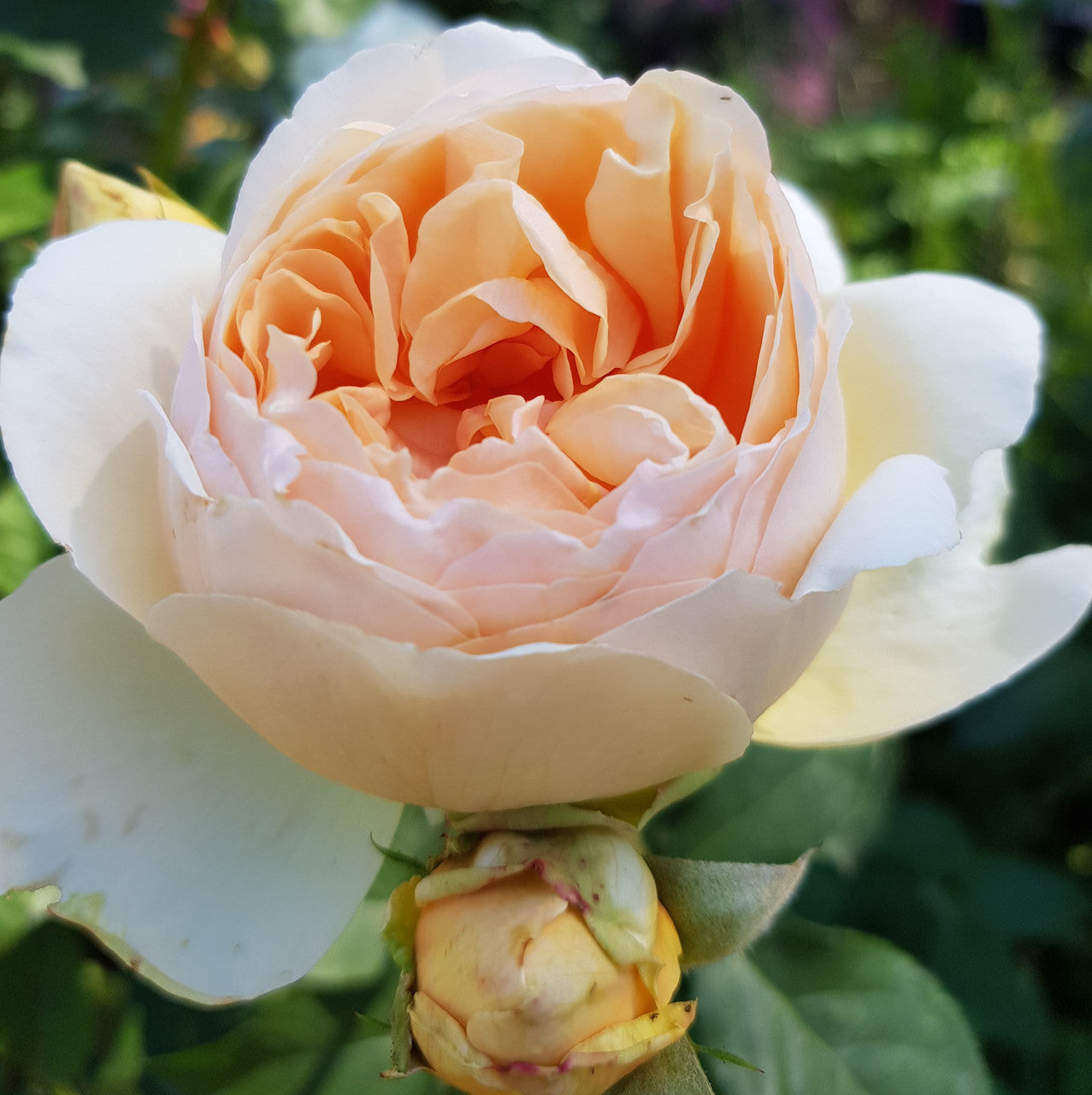 Bred by David Austin, UK, 1995 this is now one of the most popular of the English Roses because of the beautifully and deeply cupped flowers which present an imposing sight and then totally enthral you when you take the cup and breathe the glorious fruity fragrance.
Bred by David Austin, UK, 1995 this is now one of the most popular of the English Roses because of the beautifully and deeply cupped flowers which present an imposing sight and then totally enthral you when you take the cup and breathe the glorious fruity fragrance.
Jude the Obscure must be planted amidst a group of the David Austin English Roses because the gentle clotted creamy coloured blooms blend with all the colours and the bush will stand and branch above other roses. The flowers will nod graciously and beg you to pick them for a vase – they won’t last long in the open vase but are perfect submerged in the ‘Pearly Petals’ solution and water or floated in a flat bowl.
The shrub is very healthy and free flowering. The growth is variable depending on how the shrub is pruned – this wonderful rose would prefer light pruning and then will produce a shrub of 1.8metres in height and 1.2 metres in width.
- Enormously popular because of old-world charm
- Highly fragrant
- Delightfully cupped clotted creamy blooms
- Perfect rose to use in ‘Pearly Petals’
CULTURAL NOTES:
The generally sunny, dry and hot conditions of the Australian garden are particularly well suited to planting roses and roses flourish in our gardens when you take measures to provide the following:
WATER – Roses are very deep rooted plants and require one good, deep soaking at least every 10 days in hot and dry conditions.
FEED – Because roses flower throughout all but the Winter season, they should be regularly fertilized with quality (preferably organic) fertilizer which contains a balance of major nutrients (NPK) and trace elements. The fertilizer should be applied at least once a month – small amount often – with fortnightly applications of liquid seaweed over the foliage.
PRUNE – During Winter, 70% of the rose plant should be pruned and all old wood removed back to the crown and the bush pruned to shape.
During the flowering seasons, 25% of all flowering stems should be cut back after flowering to encourage strong re-growth.
MULCH – Particular attention to application of lucerne or pea straw directly around the root-zone of each rose will enhance the overall health of the rose and then the whole bed should be mulched to 75mm with any other mulch medium available.
JOY OF LIFE – HYBRID TEA ROSE AND A SYMBOL OF HEALTH AND HAPPINESS, LIFE AND BIRTH, FAMILY, FRIENDS AND CONTENTMENT
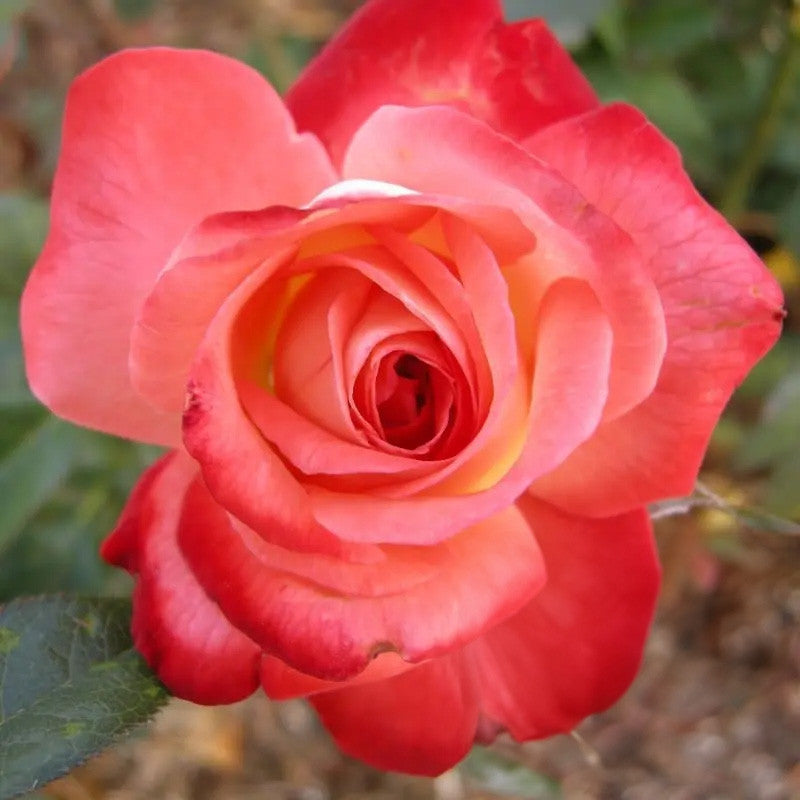 Bred by Tantau, Germany, this beautiful rose was released in Australia in 1996 to raise funds for the Rotary Health Research Foundation.
Bred by Tantau, Germany, this beautiful rose was released in Australia in 1996 to raise funds for the Rotary Health Research Foundation.
Joy of Life produces blooms with off-white centres margined with salmon-dark pink at the petal edge and the flowers darken with age to red. This rose is very strong and vigorous, growing to 1.5mtrs in height with very healthy, dark green foliage, making it a very easy rose to grow – especially important when presenting a rose of this name for a memorial gift!
The flowers of Joy of Life stand up well in a vase. Extremely pretty that the flowers change as they age which adds a lovely aspect to a flower arrangement.
- Stunning confection of colours in every bloom
- Healthy and very free flowering
- Great in flower arrangments
- Ideal rose to present as a memorial gift
CULTURAL NOTES:
The generally sunny, dry and hot conditions of the Australian garden are particularly well suited to planting roses and roses flourish in our gardens when you take measures to provide the following:
WATER – Roses are very deep rooted plants and require one good, deep soaking at least every 10 days in hot and dry conditions.
FEED – Because roses flower throughout all but the Winter season, they should be regularly fertilized with quality (preferably organic) fertilizer which contains a balance of major nutrients (NPK) and trace elements. The fertilizer should be applied at least once a month – small amount often – with fortnightly applications of liquid seaweed over the foliage.
PRUNE – During Winter, 70% of the rose plant should be pruned and all old wood removed back to the crown and the bush pruned to shape.
During the flowering seasons, 25% of all flowering stems should be cut back after flowering to encourage strong re-growth.
MULCH – Particular attention to application of lucerne or pea straw directly around the root-zone of each rose will enhance the overall health of the rose and then the whole bed should be mulched to 75mm with any other mulch medium available.
K
KARDINAL – HYBRID TEA ROSE OF IMMACULATE FORM AND THE BRIGHTEST, RICH ‘KARDINAL’ RED VERY FREQUENTLY SEEN AT A ROSE SHOW ADORNED WITH ‘FIRST PRIZE’ SASHES
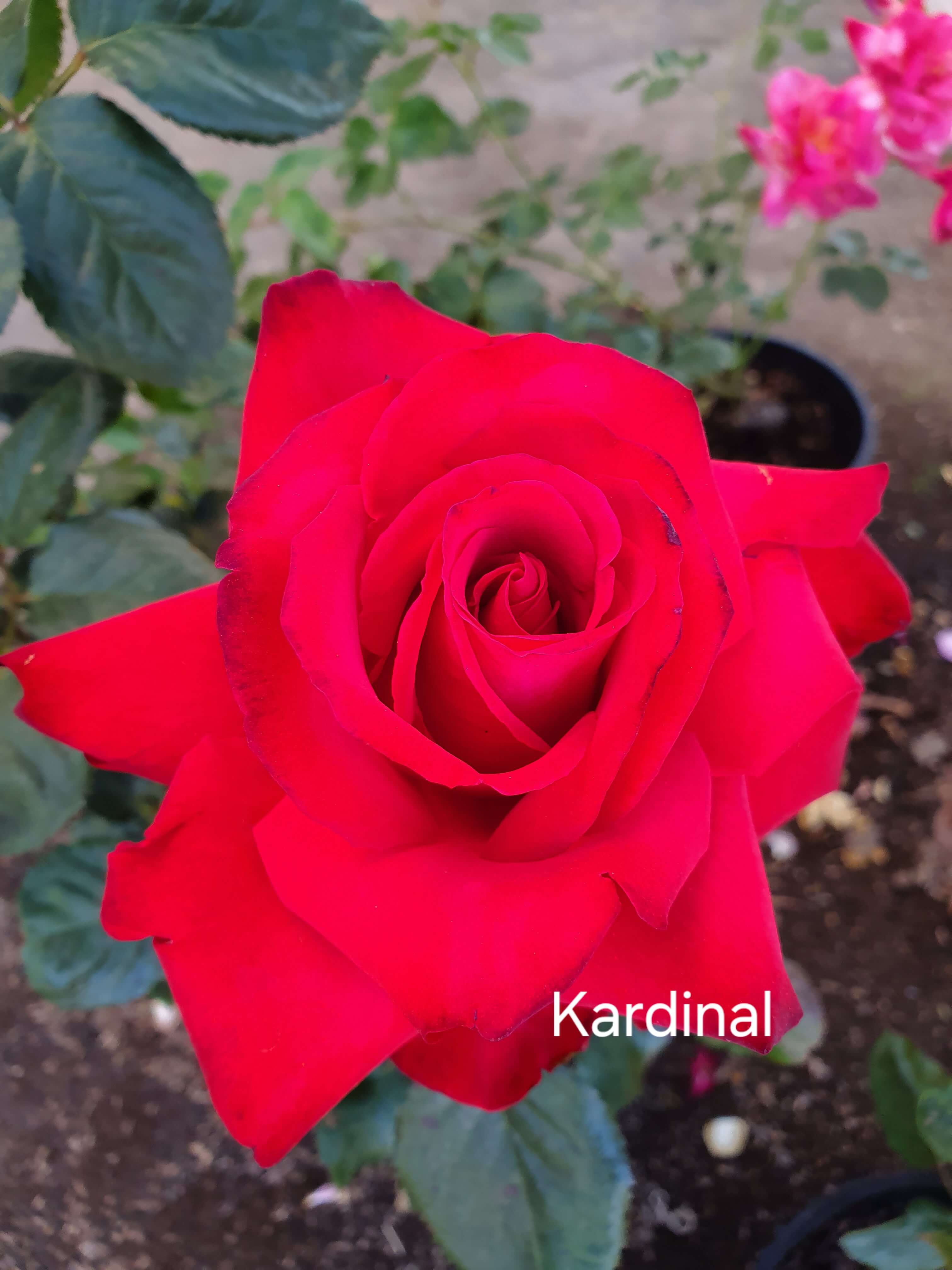 Raised by Kordes, Germany 1985 and originally produced for the cut-flower market, this rose does exceedingly well in the home garden and one bush will continually produce many perfect flowers. However, if three bushes are planted in a clump, gardeners would never have to purchase a red rose from the florist because this abundant flowering rose will generously provide bunches of vase quality roses throughout the season.
Raised by Kordes, Germany 1985 and originally produced for the cut-flower market, this rose does exceedingly well in the home garden and one bush will continually produce many perfect flowers. However, if three bushes are planted in a clump, gardeners would never have to purchase a red rose from the florist because this abundant flowering rose will generously provide bunches of vase quality roses throughout the season.
Unfortunately, because of it’s perfect form, Kardinal invites you to take a sniff to enjoy the perfume – the disappointment of little or no fragrance lasts only moments because the flowers will endure in the vase for more than 10 days! The strong, long stems on this rose carry lots of prickles and there is usually one rose per stem which makes it easy to use a de-thorner.
The foliage is semi-glossy, dark green and has good resistance to black-spot and mildew. If Kardinal is well nurtured, the flowers will be large and flower production will be immense in all weather conditions.
- Prolific cut flower suitable for garden culture
- Long vase life
- Healthy and robust
CULTURAL NOTES:
The generally sunny, dry and hot conditions of the Australian garden are particularly well suited to planting roses and roses flourish in our gardens when you take measures to provide the following:
WATER – Roses are very deep rooted plants and require one good, deep soaking at least every 10 days in hot and dry conditions.
FEED – Because roses flower throughout all but the Winter season, they should be regularly fertilized with quality (preferably organic) fertilizer which contains a balance of major nutrients (NPK) and trace elements. The fertilizer should be applied at least once a month – small amount often – with fortnightly applications of liquid seaweed over the foliage.
PRUNE – During Winter, 70% of the rose plant should be pruned and all old wood removed back to the crown and the bush pruned to shape.
During the flowering seasons, 25% of all flowering stems should be cut back after flowering to encourage strong re-growth.
MULCH – Particular attention to application of lucerne or pea straw directly around the root-zone of each rose will enhance the overall health of the rose and then the whole bed should be mulched to 75mm with any other mulch medium available.
KNOCK OUT – MODERN SHRUB ROSE WHICH MUST SURELY BE ONE OF THE MOST DISEASE-RESISTANT ROSES WE HAVE EVER GROWN
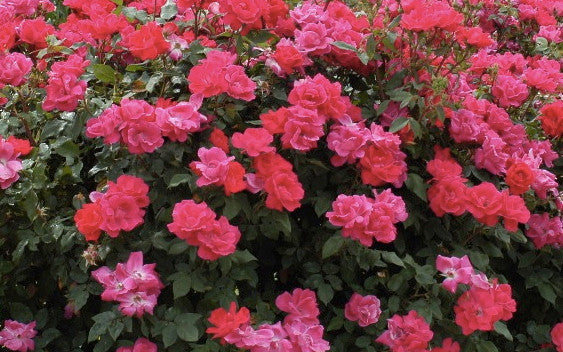 Bred by William J. Radler, USA, 1999, Knock Out has received prestigious awards in trial gardens throughout the world and in 2005 became the most purchased landscape rose in the United States and in 2010, the best selling rose of all time!
Bred by William J. Radler, USA, 1999, Knock Out has received prestigious awards in trial gardens throughout the world and in 2005 became the most purchased landscape rose in the United States and in 2010, the best selling rose of all time!
At the World Rose Convention in South Africa, 2012, we had the privilege to meet Bill Radler and it is exciting to report that through his breeding program, he has set the standard for sustainability in roses. We will see roses such as Knock Out along the highways and byways throughout Australia in the coming years because this series of roses has the capacity to withstand all weather conditions and tolerates little or no maintenance once established.
Knock Out is very dark, luminous pink and stands out. Although the label states that it will grow 1mt x 1mt, where it is presented with some support, it is growing well over 2mts high and will not stop flowering! This is a very versatile rose to grow in ANY sunny situation – free standing it will create a mound of continuous colour, grow it as a hedge and allow it to be as short or tall as the hedge needs to be or give it support and it will grow as a climber.
- Extremely disease resistant and hardy
- The most versatile rose to grow in any sunny location
- Luminous, bright pink single blooms continually
- Anybody can grow this rose without any problems!
CULTURAL NOTES:
The generally sunny, dry and hot conditions of the Australian garden are particularly well suited to planting roses and roses flourish in our gardens when you take measures to provide the following:
WATER – Roses are very deep rooted plants and require one good, deep soaking at least every 10 days in hot and dry conditions.
FEED – Because roses flower throughout all but the Winter season, they should be regularly fertilized with quality (preferably organic) fertilizer which contains a balance of major nutrients (NPK) and trace elements. The fertilizer should be applied at least once a month – small amount often – with fortnightly applications of liquid seaweed over the foliage.
PRUNE – During Winter, 70% of the rose plant should be pruned and all old wood removed back to the crown and the bush pruned to shape.
During the flowering seasons, 25% of all flowering stems should be cut back after flowering to encourage strong re-growth.
MULCH – Particular attention to application of lucerne or pea straw directly around the root-zone of each rose will enhance the overall health of the rose and then the whole bed should be mulched to 75mm with any other mulch medium available.
L
LAMARQUE – OLD FASHIONED CLIMBING/RAMBLING ROSE PRODUCES MASSES OF MEDIUM-SIZED LEMON CENTRED BLOOMS THROUGHOUT THE SEASON
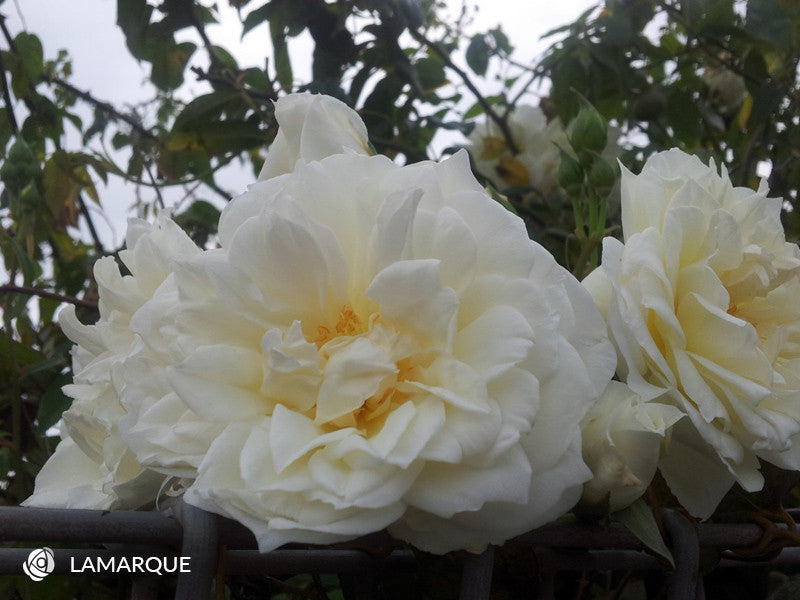 Bred by Marechal, France, 1830, this magnificent Noisette rose has stood the test of time and is still widely grown today.
Bred by Marechal, France, 1830, this magnificent Noisette rose has stood the test of time and is still widely grown today.
Lamarque has the purest white blooms with a pale lemon centre and the mass of petals lay quartered in the medium sized, flat blooms which are produced throughout the season in clusters all over the scrambling canes which can cover more than 6 metres if not pruned.
The foliage is uniquely pointed and a distinct mid-green colour and is the perfect foil for the highly fragrant mass of blooms throughout the flowering season.
- Highly recommended climbing/rambling rose
- Pure white with lemon centres, quartered blooms
- Healthy mid-green foliage
- Highly fragrant rambling rose
CULTURAL NOTES:
The generally sunny, dry and hot conditions of the Australian garden are particularly well suited to planting roses and roses flourish in our gardens when you take measures to provide the following:
WATER – Roses are very deep rooted plants and require one good, deep soaking at least every 10 days in hot and dry conditions.
FEED – Because roses flower throughout all but the Winter season, they should be regularly fertilized with quality (preferably organic) fertilizer which contains a balance of major nutrients (NPK) and trace elements. The fertilizer should be applied at least once a month – small amount often – with fortnightly applications of liquid seaweed over the foliage.
PRUNE – During Winter, 70% of the rose plant should be pruned and all old wood removed back to the crown and the bush pruned to shape.
During the flowering seasons, 25% of all flowering stems should be cut back after flowering to encourage strong re-growth.
MULCH – Particular attention to application of lucerne or pea straw directly around the root-zone of each rose will enhance the overall health of the rose and then the whole bed should be mulched to 75mm with any other mulch medium available.
LICHFIELD ANGEL – DAVID AUSTIN SHRUB ROSE PRODUCING MASSES OF CREAMY-WHITE BLOOMS CONTINUALLY
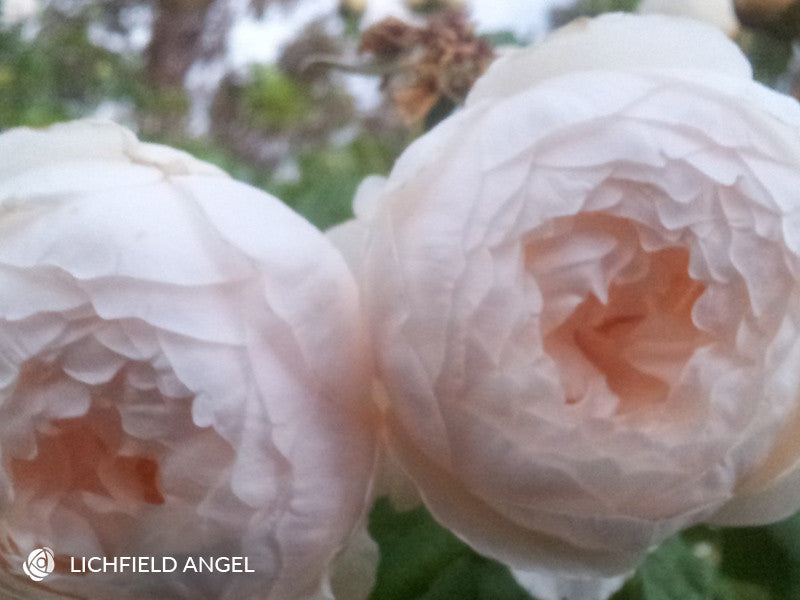 Bred by David Austin Roses, UK, released in Australia in 2009 this lovely rose will be widely grown as a border to the rose garden because of the rounded shape of the shrub which grows 1.2 metres high and wide.
Bred by David Austin Roses, UK, released in Australia in 2009 this lovely rose will be widely grown as a border to the rose garden because of the rounded shape of the shrub which grows 1.2 metres high and wide.
Lichfield Angel produces lovely creamy pale apricot cupped rosettes of blooms which open to quite large creamy white flat flowers on long, strong stems.
- David Austin Rose
- Creamy white rosettes
- Very free flowering
- Healthy, rounded shrub suitable for rose garden border
CULTURAL NOTES:
The generally sunny, dry and hot conditions of the Australian garden are particularly well suited to planting roses and roses flourish in our gardens when you take measures to provide the following:
WATER – Roses are very deep rooted plants and require one good, deep soaking at least every 10 days in hot and dry conditions.
FEED – Because roses flower throughout all but the Winter season, they should be regularly fertilised with quality (preferably organic) fertilizer which contains a balance of major nutrients (NPK) and trace elements. The fertilizer should be applied at least once a month – small amount often – with fortnightly applications of liquid seaweed over the foliage.
PRUNE – During Winter, 70% of the rose plant should be pruned and all old wood removed back to the crown and the bush pruned to shape.
During the flowering seasons, 25% of all flowering stems should be cut back after flowering to encourage strong re-growth.
MULCH – Particular attention to application of lucerne or pea straw directly around the root-zone of each rose will enhance the overall health of the rose and then the whole bed should be mulched to 75mm with any other mulch medium available.
M
MAGGIE – MODERN SHRUB ROSE NAMED FOR OUR VERY OWN MAGGIE TABBERER WHO IS THE PATRON OF THE MELANOMA FOUNDATION WHO RECEIVE THE ROYALTY PAYMENTS FROM SALES OF THIS ROSE IN AUSTRALIA
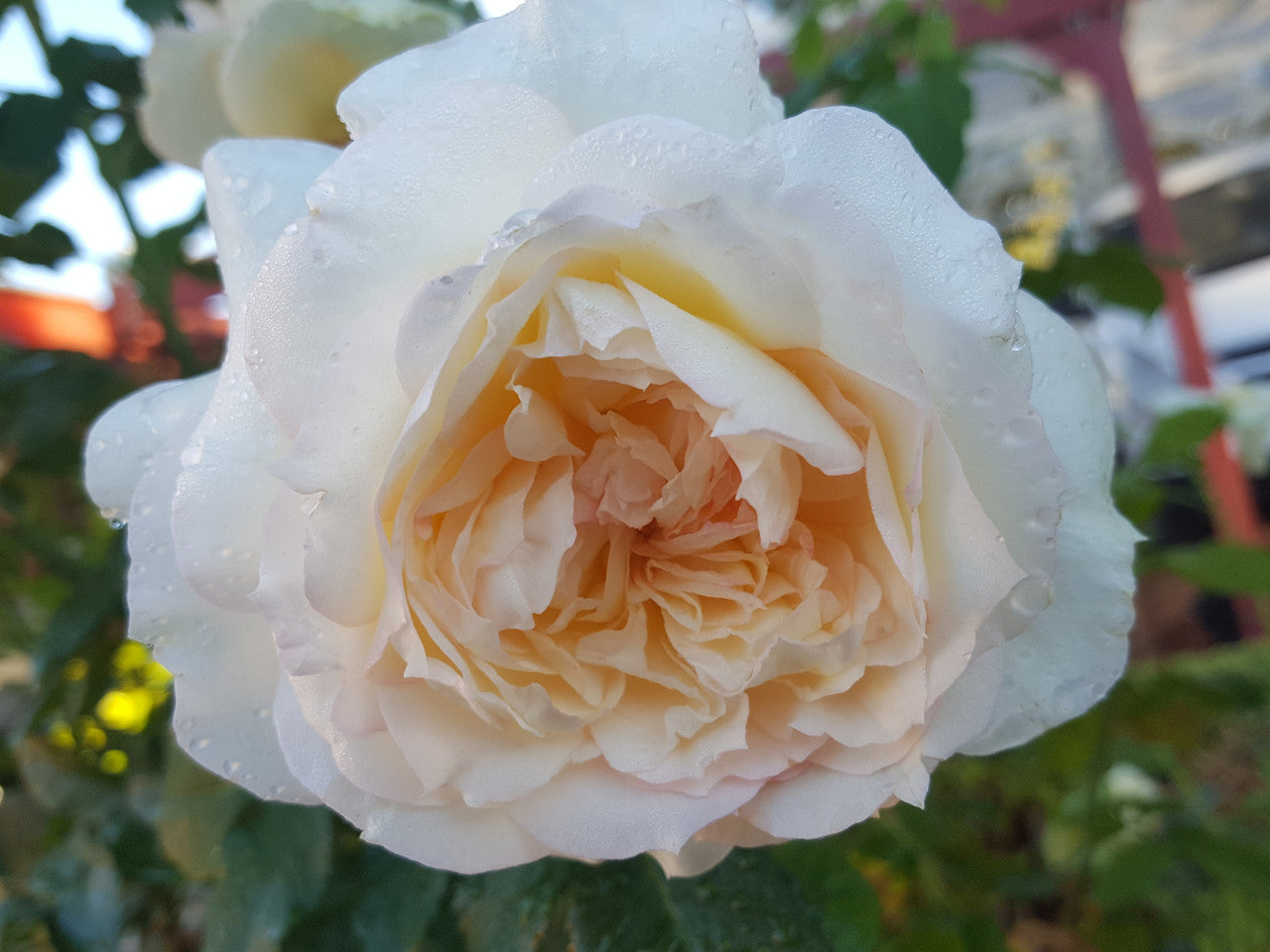 Bred by Alain Meilland, Antibes, France, in 2001 this magnificent rose has all the style and flair, the resilience and beauty we love about Maggie Tabberer!
Bred by Alain Meilland, Antibes, France, in 2001 this magnificent rose has all the style and flair, the resilience and beauty we love about Maggie Tabberer!
This rose is tough with abundant, glossy and healthy foliage and would be suitable to plant as a border or rose hedge – each shrub will grow to 1.5mts high and at least 1mt wide and can be pruned mechanically.
Maggie flowers are wonderful for flower arrangements because the cluster of flowers will slowly open in the vase so that the ruffled petals can be enjoyed and this rose is a favourite of mine to use with the ‘Pearly Petals’ … so, so pretty!- Magnificent creamy white blooms with ruffled petals
- Strong, resilient rose bush
- Long flowering and delightful rose for flower arrangements
- Royalty payments to Melanoma Foundation
CULTURAL NOTES:
The generally sunny, dry and hot conditions of the Australian garden are particularly well suited to planting roses and roses flourish in our gardens when you take measures to provide the following:
WATER – Roses are very deep rooted plants and require one good, deep soaking at least every 10 days in hot and dry conditions.
FEED – Because roses flower throughout all but the Winter season, they should be regularly fertilized with quality (preferably organic) fertilizer which contains a balance of major nutrients (NPK) and trace elements. The fertilizer should be applied at least once a month – small amount often – with fortnightly applications of liquid seaweed over the foliage.
PRUNE – During Winter, 70% of the rose plant should be pruned and all old wood removed back to the crown and the bush pruned to shape.
During the flowering seasons, 25% of all flowering stems should be cut back after flowering to encourage strong re-growth.
MULCH – Particular attention to application of lucerne or pea straw directly around the root-zone of each rose will enhance the overall health of the rose and then the whole bed should be mulched to 75mm with any other mulch medium available.
MANY HAPPY RETURNS – MODERN SHRUB ROSE OF OUTSTANDING HEALTH AND VIGOUR SUITABLE FOR HEDGE-ROW PLANTING
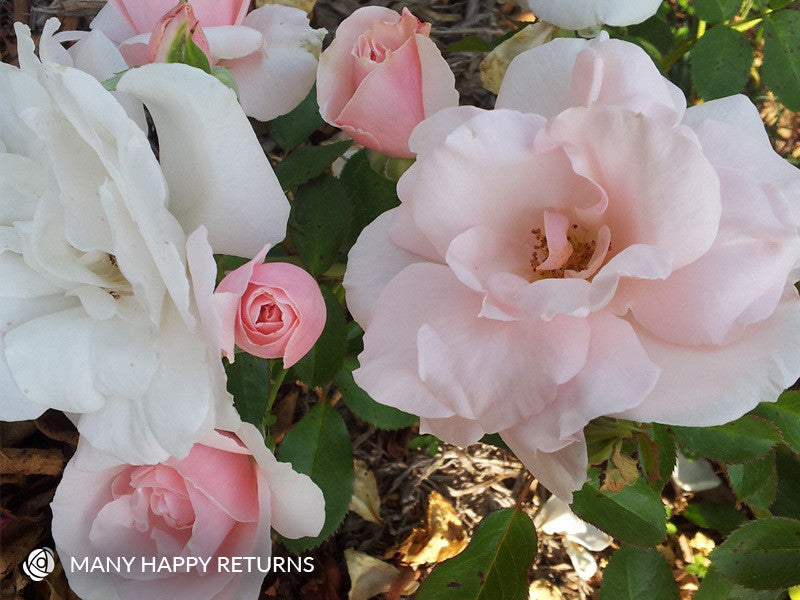 Bred by Meilland, France, this rose is an ideal birthday gift for the person who has everything and might be difficult to find something lovely for to remember their day!
Bred by Meilland, France, this rose is an ideal birthday gift for the person who has everything and might be difficult to find something lovely for to remember their day!
Many Happy Returns produces masses of semi-double pale pink blooms continually throughout the season. It is a very adaptable rose and can be grown in large tubs to create a mound of continual colour.
The foliage is tough and leathery with rather large dark-green leaves. If left unpruned or dead-headed, there will be clusters of bright red rose hips all over the shrub and these hips are ideal to use as added decoration in a flower arrangement or harvested and used to make a wonderful rose-hip liqueur!
- Ideal birthday present – most especially for women
- Pale-pink, semi-double blooms in masses
- Very tough, leathery leaves
- Produces masses of rose hips if not pruned
MARGARET MERRIL – FLORIBUNDA ROSE OF THE MOST PURE WHITE AND PERFECT PETAL FORMATION
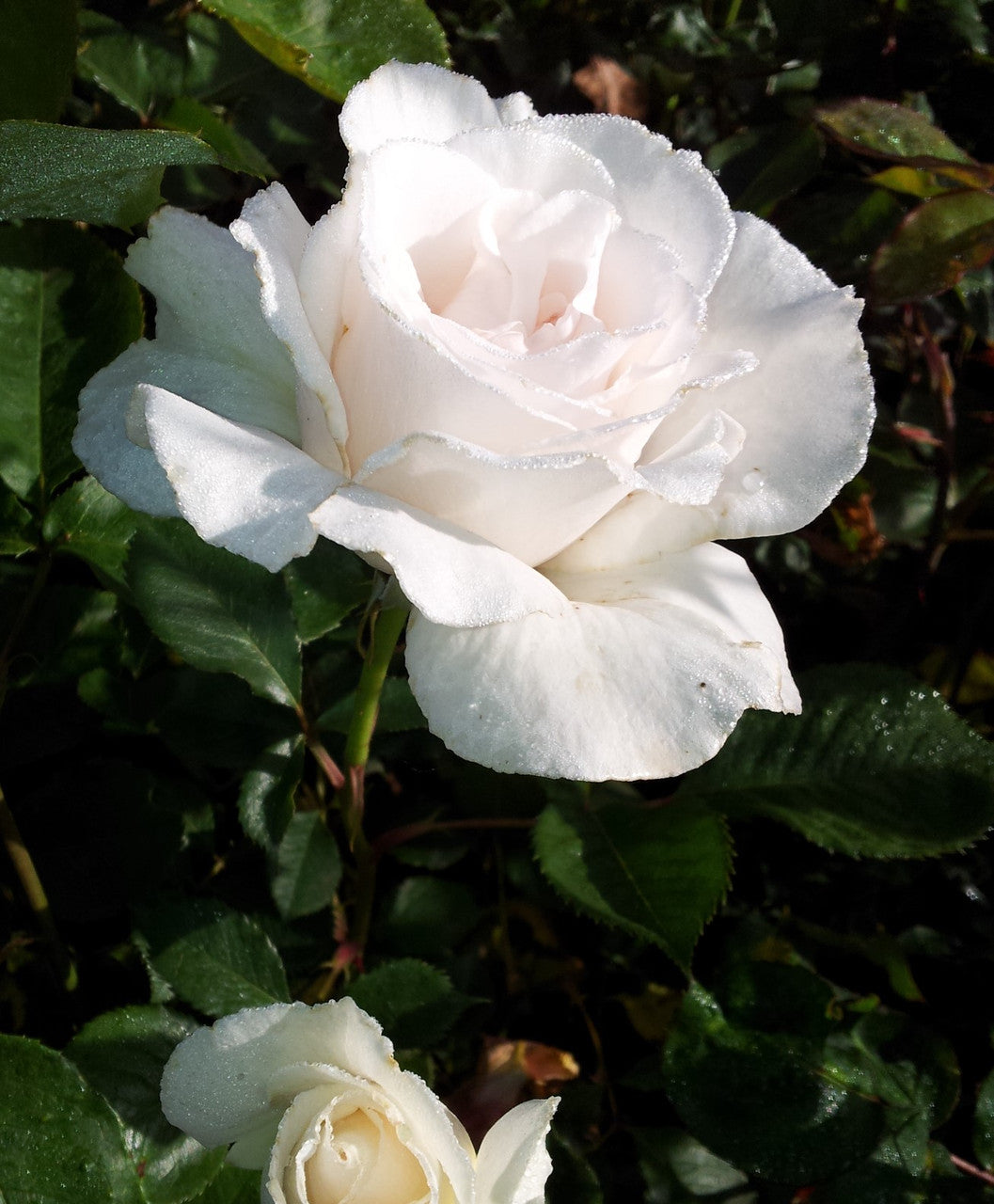 Raised by Harkness, UK, 1977 this glorious rose makes an outstanding addition to the rose garden producing the most perfectly formed, purest white blooms which, when opened, reveal a bed of dark crimson stamens which attract the bees!
Raised by Harkness, UK, 1977 this glorious rose makes an outstanding addition to the rose garden producing the most perfectly formed, purest white blooms which, when opened, reveal a bed of dark crimson stamens which attract the bees!
Margaret Merril has very distinct dark green foliage which is serrated at the edges and the foliage is wonderfully healthy and makes a beautiful foil for the sometimes single and sometimes clusters of perfect blooms. The flowers last well in a vase and the fragrance is unforgettable – sweet and intense old-rose perfume.
The bush is a lovely rounded shape and very low maintenance with flowers produced throughout the season in abundance.
- Purest white floribunda
- Magnificent intense fragrance
- Dark green serrated foliage
- Extremely healthy bush to 1.2mtrs
MAURICE UTRILLO – FLORIBUNDA/MODERN SHRUB ROSE BRIGHT RED, BRILLIANTLY CONTRASTED BY VIBRANT SLASHES OF YELLOW AND CREAM … STUNNING IN THE SUPREME
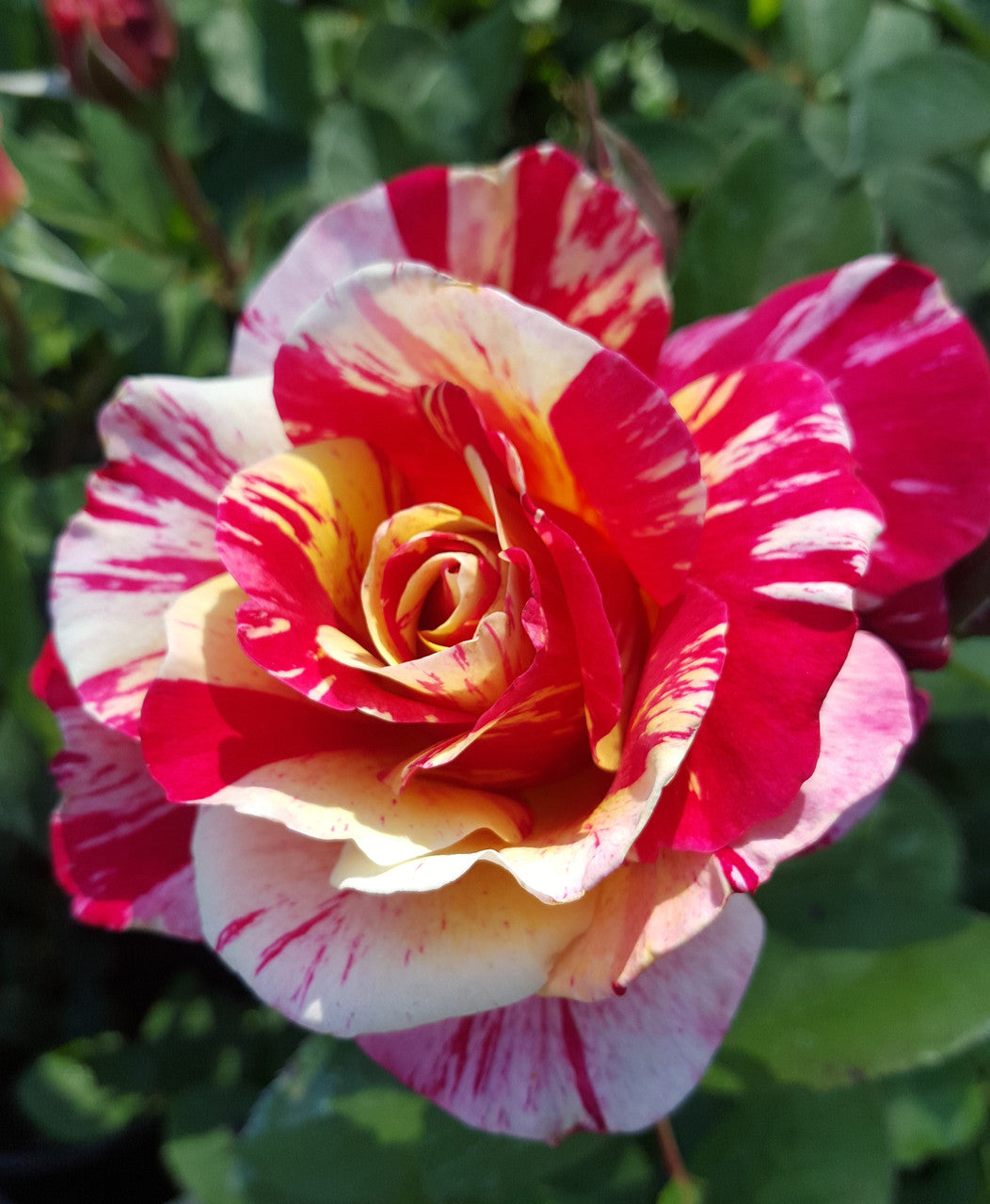 Introduced by Delbard in 2003 it is this rose that I can lay the blame for my passion and love of the striped roses. I previously deplored the striped roses but had planted two standards of Maurice in the nature-strip garden bed which I had to walk past every morning. The extreme difference in each bloom attracted my attention and more and more I came to enjoy the beauty in the craziness!
Introduced by Delbard in 2003 it is this rose that I can lay the blame for my passion and love of the striped roses. I previously deplored the striped roses but had planted two standards of Maurice in the nature-strip garden bed which I had to walk past every morning. The extreme difference in each bloom attracted my attention and more and more I came to enjoy the beauty in the craziness!
And then there was more … this rose was never shy to show off the flowers and the dark, dark green foliage was abundant, fresh and never diseased. I started to fall in love and my passion for this rose will never wane.
Maurice Utrillo is one of the Delbard Great French Impressionist Painters series – honest, naïve yet passionate style and this glorious rose is all of that, from budburst through to the full, voluptuous and generous mature bloom.
Ideally suited to budding to a standard understock, Maurice Utrillo would make you want to waltz to the front door if it was planted along the path to your house!
- Stunning colour blend of bright red and creamy yellow
- Awesome health and vigour
- Seriously free flowering
- A crazy, beautiful rose!
MOLINEUX – DAVID AUSTIN ROSE OF IMMENSE CHARM BECAUSE IT’S VARIETY OF COLOURS IN YELLOW, GOLD AND CREAM
 Bred by David Austin and introduced in 1994 this is one of the most neatly compact of the English Roses. The bush is lovely and rounded and of medium height to around 1 metre tall and almost as wide making this rose ideal for the rose garden border.
Bred by David Austin and introduced in 1994 this is one of the most neatly compact of the English Roses. The bush is lovely and rounded and of medium height to around 1 metre tall and almost as wide making this rose ideal for the rose garden border.
Molineux is always different in colour depending on the weather! It thrives in very hot conditions when the colour will be either rich, warm yellow fading to cream or the blooms might be quite cream with a deeper yellow centre. The heavily petalled rosette shaped flowers have a delightful English Rose fragrance and last well in the vase.
This delightful David Austin rose will always be flowering – one of the very first roses to flower in the Spring and you might find yourself wondering if it will ever stop flowering so that you can prune it in the Winter.
- Tightly rounded shrub to 1 metre high
- Extremely pretty rosette shaped flowers from yellow to cream
- Loves the hot weather
- Flowers over a very long, extended season
MOTHER’S LOVE – HYBRID TEA ROSE WHICH IS SO PERFECTLY APPROPRIATELY NAMED AND IDEAL TO GIFT ON MANY OCCASIONS
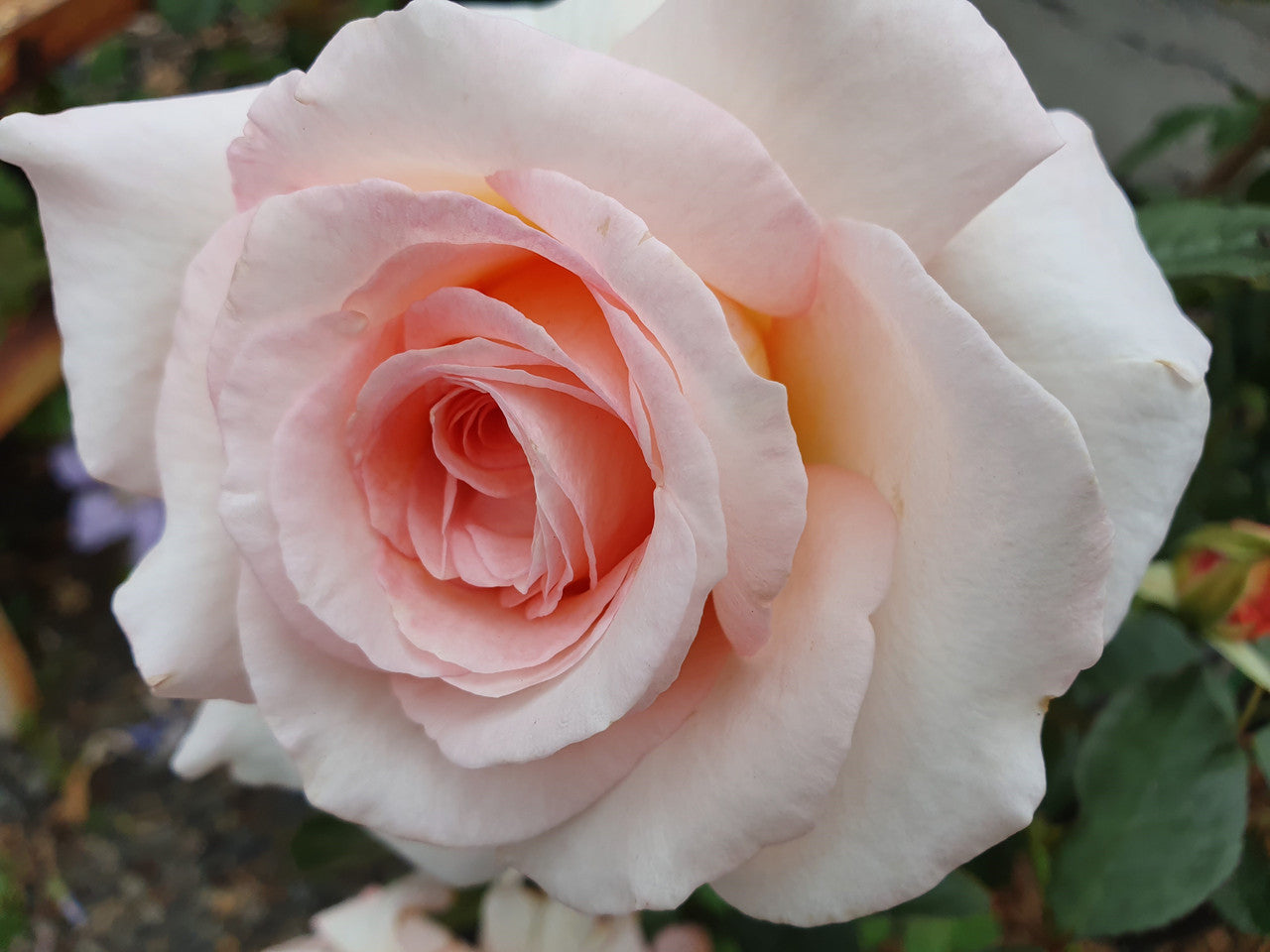 Bred by Dee Bennett, USA, 1989 this wonderful rose graces many gardens as a remembrance rose and because of its extremely hardy nature and reliable repeat flowering, I never hesitate to recommend this rose as a gift to the least green-thumbed gardener – once in the ground this rose will perform and be a delightful reminder of the Mother for whom it was planted.
Bred by Dee Bennett, USA, 1989 this wonderful rose graces many gardens as a remembrance rose and because of its extremely hardy nature and reliable repeat flowering, I never hesitate to recommend this rose as a gift to the least green-thumbed gardener – once in the ground this rose will perform and be a delightful reminder of the Mother for whom it was planted.
Mother’s Love has beautifully long pointed buds of the palest pink with slightly deeper pink centres which may fade in the very hot sun. It is a very feminine rose with graceful branches often producing a single rose but very often a cluster of blooms. The perfume is charming.
The bush is very reliable with very little disease issues and lovely glossy mid-green foliage and there are a good number of prickles! The flowers last well in the vase where the perfume can be truly enjoyed.
- Delightful rose to gift as a remembrance of any Mother
- Pale pink blooms which pale to almost white in hot sun
- Lovely sweet fragrance
- Glossy mid-green foliage on a reliable bush
CULTURAL NOTES:
The generally sunny, dry and hot conditions of the Australian garden are particularly well suited to planting roses and roses flourish in our gardens when you take measures to provide the following:
WATER – Roses are very deep rooted plants and require one good, deep soaking at least every 10 days in hot and dry conditions.
FEED – Because roses flower throughout all but the Winter season, they should be regularly fertilized with quality (preferably organic) fertilizer which contains a balance of major nutrients (NPK) and trace elements. The fertilizer should be applied at least once a month – small amount often – with fortnightly applications of liquid seaweed over the foliage.
PRUNE – During Winter, 70% of the rose plant should be pruned and all old wood removed back to the crown and the bush pruned to shape.
During the flowering seasons, 25% of all flowering stems should be cut back after flowering to encourage strong re-growth.
MULCH – Particular attention to application of lucerne or pea straw directly around the root-zone of each rose will enhance the overall health of the rose and then the whole bed should be mulched to 75mm with any other mulch medium available.
MR. LINCOLN – HYBRID TEA ROSE WHICH HARDLY NEEDS ANY INTRODUCTION AS IT IS THE MOST COMMONLY REQUESTED DARK RED ROSE
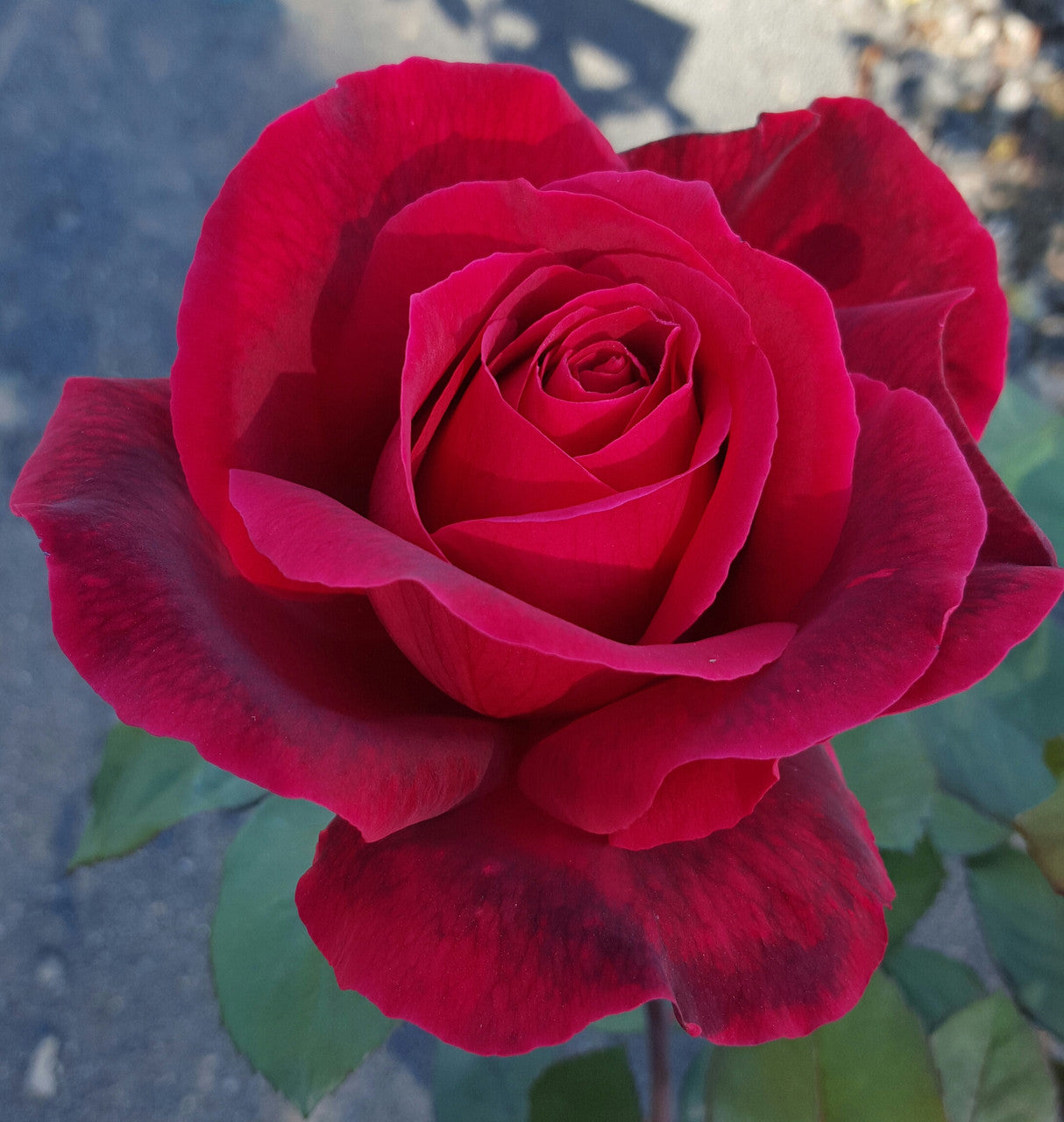 Bred by Swim & Weeks, USA, 1964 this very tall growing rose to 1.8 metres should be planted at the back of the rose bed where it will shine over and above all the roses and the breath-taking fragrance will still be enjoyed.
Bred by Swim & Weeks, USA, 1964 this very tall growing rose to 1.8 metres should be planted at the back of the rose bed where it will shine over and above all the roses and the breath-taking fragrance will still be enjoyed.
Mr. Lincoln has retained its popularity over the years because it is just so reliable a performer with very tough, leathery foliage, especially loving the heat. As with most dark red roses, Mr. Lincoln has very sharp thorns and produces huge, thick watershoots which should be pruned with loppers rather than secateurs.
The dark red blooms are very high-centred and the petals have incredible substance and when fading, take a rather dark purple hue. This rose is ideal for the vase and one bush will produce many magnificent long, strong stems – have the de-thorner handy when working with this rose!
- Most popular dark red rose
- Exquisitely huge fragrance
- Tough, reliable and very tall bush
- Ideal cut rose for flower arrangement
CULTURAL NOTES:
The generally sunny, dry and hot conditions of the Australian garden are particularly well suited to planting roses and roses flourish in our gardens when you take measures to provide the following:
WATER – Roses are very deep rooted plants and require one good, deep soaking at least every 10 days in hot and dry conditions.
FEED – Because roses flower throughout all but the Winter season, they should be regularly fertilized with quality (preferably organic) fertilizer which contains a balance of major nutrients (NPK) and trace elements. The fertilizer should be applied at least once a month – small amount often – with fortnightly applications of liquid seaweed over the foliage.
PRUNE – During Winter, 70% of the rose plant should be pruned and all old wood removed back to the crown and the bush pruned to shape.
During the flowering seasons, 25% of all flowering stems should be cut back after flowering to encourage strong re-growth.
MULCH – Particular attention to application of lucerne or pea straw directly around the root-zone of each rose will enhance the overall health of the rose and then the whole bed should be mulched to 75mm with any other mulch medium available.
MUNSTEAD WOOD – DAVID AUSTIN MODERN SHRUB ROSE WITH LARGE DARK CRIMSON HEAVILY PETALLED BLOOMS
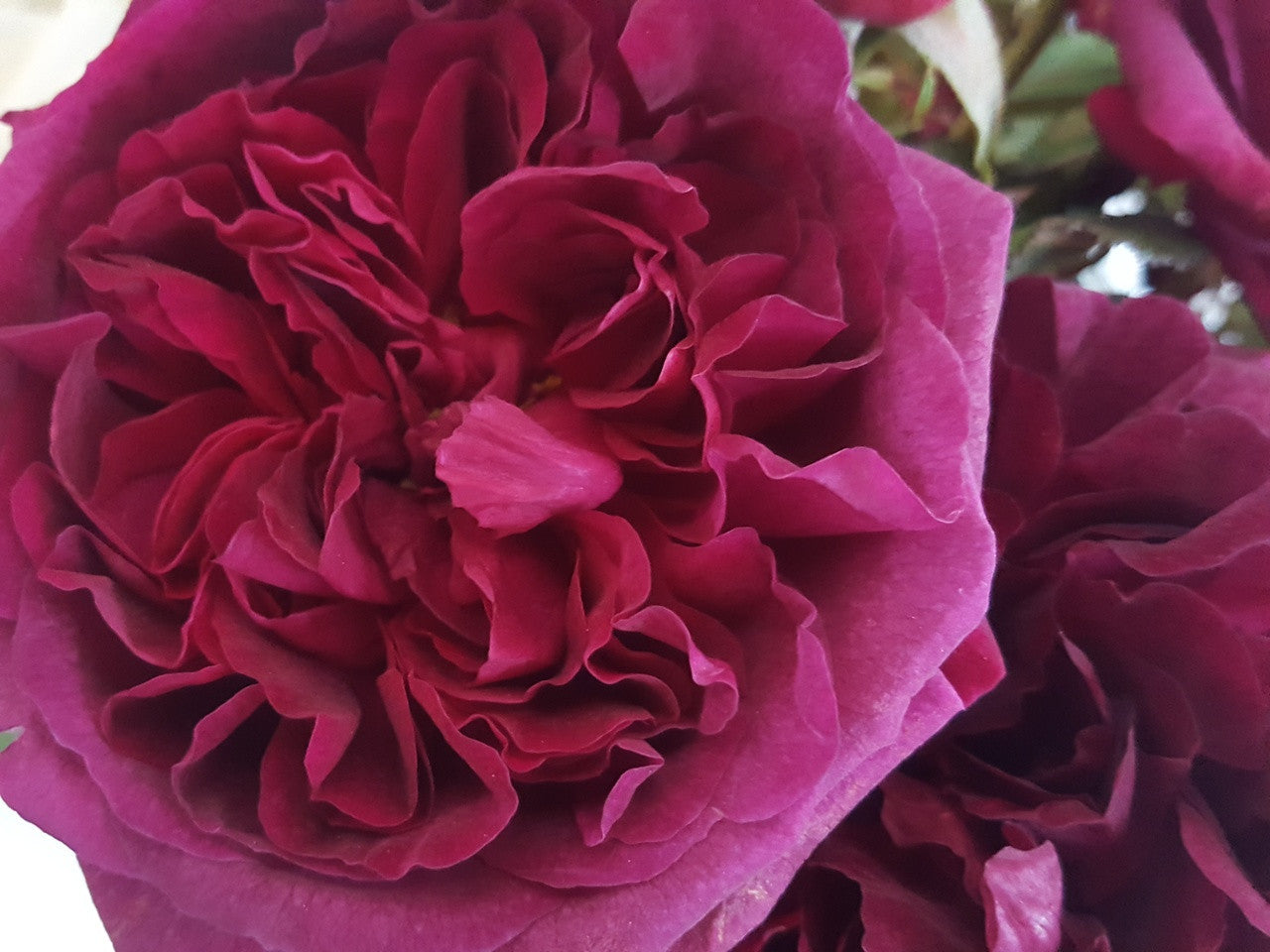 Bred by David Austin, UK, and released in 2010 in Australia this rose has all the qualities we now expect in the recently released English Roses – great hybrid vigour and superb disease resistance.
Bred by David Austin, UK, and released in 2010 in Australia this rose has all the qualities we now expect in the recently released English Roses – great hybrid vigour and superb disease resistance.
Munstead Wood produces masses of rich dark crimson blooms in clusters on a very neat and compact shrub to around 1 metre tall and almost as wide. It is extremely free flowering over a long period and the shrub is very disease resistant and suitable to grow as a hedge-row rose on the border of the garden.
The blooms are full with the outer petals recurving when fully opened and the fragrance is intensely sweet old rose perfume. This English Rose stands up very well as a cut flower in the vase.
- Large dark crimson blooms
- Extremely healthy rounded shrub
- Intense old rose fragrance
- Suitable for use in flower arrangements
CULTURAL NOTES:
The generally sunny, dry and hot conditions of the Australian garden are particularly well suited to planting roses and roses flourish in our gardens when you take measures to provide the following:
WATER – Roses are very deep rooted plants and require one good, deep soaking at least every 10 days in hot and dry conditions.
FEED – Because roses flower throughout all but the Winter season, they should be regularly fertilized with quality (preferably organic) fertilizer which contains a balance of major nutrients (NPK) and trace elements. The fertilizer should be applied at least once a month – small amount often – with fortnightly applications of liquid seaweed over the foliage.
PRUNE – During Winter, 70% of the rose plant should be pruned and all old wood removed back to the crown and the bush pruned to shape.
During the flowering seasons, 25% of all flowering stems should be cut back after flowering to encourage strong re-growth.
MULCH – Particular attention to application of lucerne or pea straw directly around the root-zone of each rose will enhance the overall health of the rose and then the whole bed should be mulched to 75mm with any other mulch medium available.
MY HERO – MODERN SHRUB ROSE OF EXTRAORDINARY HEALTH AND VIGOUR AS A PLEASANT REMINDER OF THE HERO IN YOUR LIFE
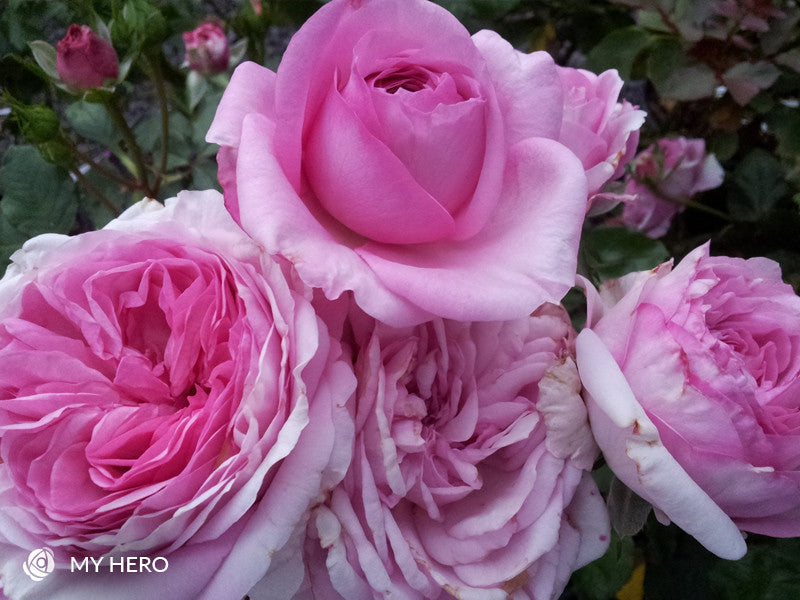 Released by Swane’s Nursery this rose is exclusively grown in Australia and our conditions are perfectly suited to this exceptionally healthy, free flowering rose.
Released by Swane’s Nursery this rose is exclusively grown in Australia and our conditions are perfectly suited to this exceptionally healthy, free flowering rose.
My Hero produces an abundance of classic, shining rose pink blooms which clothe the shrub over a very long flowering season. The petals are massed and have a rather old-fashioned look when the bloom is fully opened.
The perfume is exquisite and one truss of blooms will fill the vase and fragrance your home with lasting fruity freshness. The bush carries a mass of very lush, highly disease-resistant mid-green foliage which is a lovely foil for the continuing mass of blooms.
- Extremely healthy modern shrub rose
- Shining rose pink blooms in clusters
- Exquisite fragrance
- Continually in flower throughout the season
CULTURAL NOTES:
The generally sunny, dry and hot conditions of the Australian garden are particularly well suited to planting roses and roses flourish in our gardens when you take measures to provide the following:
WATER – Roses are very deep rooted plants and require one good, deep soaking at least every 10 days in hot and dry conditions.
FEED – Because roses flower throughout all but the Winter season, they should be regularly fertilized with quality (preferably organic) fertilizer which contains a balance of major nutrients (NPK) and trace elements. The fertilizer should be applied at least once a month – small amount often – with fortnightly applications of liquid seaweed over the foliage.
PRUNE – During Winter, 70% of the rose plant should be pruned and all old wood removed back to the crown and the bush pruned to shape.
During the flowering seasons, 25% of all flowering stems should be cut back after flowering to encourage strong re-growth.
MULCH – Particular attention to application of lucerne or pea straw directly around the root-zone of each rose will enhance the overall health of the rose and then the whole bed should be mulched to 75mm with any other mulch medium available.
N
NAHEMA – CLIMBING ROSE OF SUCH INCREDIBLE BEAUTY AND VERSATILITY WITH A FRAGRANCE THAT SURPASSES ALL EXPECTATIONS OF HOW STRONG A ROSE FRAGRANCE CAN BE
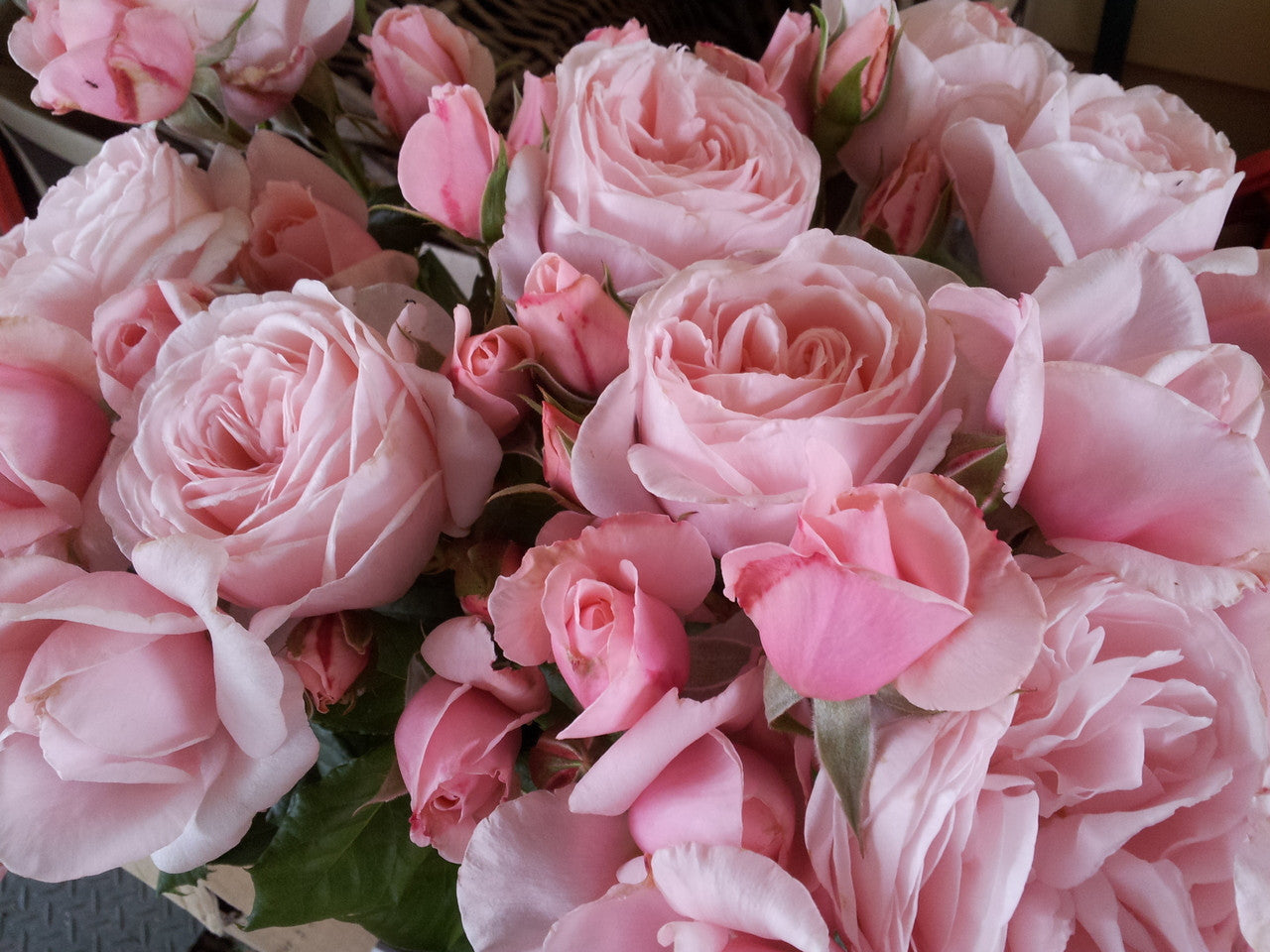 Raised by Georges Delbard, France, 2006 with a renowned perfume in the Guerlain range based on the essence of this wonderful rose.
Raised by Georges Delbard, France, 2006 with a renowned perfume in the Guerlain range based on the essence of this wonderful rose.
Nahema produces literally masses of highly fragrant and deeply cupped pale, China pink blooms in profusion throughout the season. The flowers are sensational to use in flower arrangements because of their durability in the vase and as the petals drop, the perfume remains scattered around the base of the vase – a sight to behold!
The foliage of Nahema is most unusual in that the leaves have a tendency to recurve which in any other rose might be a sign that the rose is too dry. This quirky difference makes Nahema readily identifiable and despite this habit, the foliage is very strong and disease resistant.
Nahema can be espaliered to a wall or used as a pillar rose bound to a verandah post where it will enjoyed because it has very few thorns!
- Awesome fragrant climbing rose
- Pale pink, cupped blooms with last in a vase
- Distinct and disease resistant leaves
- Almost thornless so can be used on verandah posts
CULTURAL NOTES:
The generally sunny, dry and hot conditions of the Australian garden are particularly well suited to planting roses and roses flourish in our gardens when you take measures to provide the following:
WATER – Roses are very deep rooted plants and require one good, deep soaking at least every 10 days in hot and dry conditions.
FEED – Because roses flower throughout all but the Winter season, they should be regularly fertilized with quality (preferably organic) fertilizer which contains a balance of major nutrients (NPK) and trace elements. The fertilizer should be applied at least once a month – small amount often – with fortnightly applications of liquid seaweed over the foliage.
PRUNE – During Winter, 70% of the rose plant should be pruned and all old wood removed back to the crown and the bush pruned to shape.
During the flowering seasons, 25% of all flowering stems should be cut back after flowering to encourage strong re-growth.
MULCH – Particular attention to application of lucerne or pea straw directly around the root-zone of each rose will enhance the overall health of the rose and then the whole bed should be mulched to 75mm with any other mulch medium available.
NEW DAWN – CLIMBING ROSE WITH SHAGGY, SEMI-DOUBLE CAMEO PINK FLOWERS OVER A LONG FLOWERING SEASON
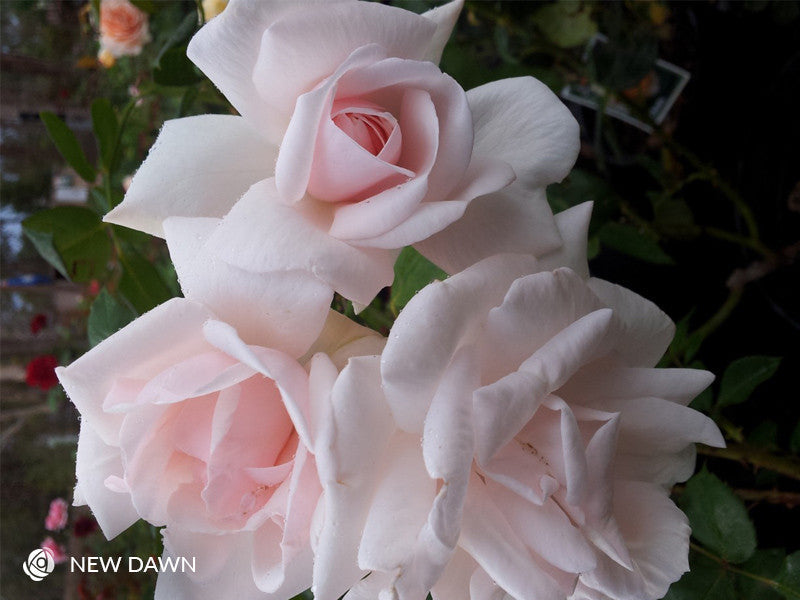 Sport of Dr. W. van Fleet, introduced in 1930 by Somerset Rose Nursery and inducted to the World Rose Hall of Fame in 1997 this wonderful climbing rose is seen in some of the oldest gardens in Australia and because of it’s R. wichuriana parentage, the pliable though thorny canes, make it a climber suitable to accommodate any garden design … you be the boss and New Dawn will comfortably comply with whatever you wish it to do. Let it have it’s head and scramble over an old garden shed, attach it to the fence and cut it frequently, attach it to a pillar in the middle of a garden bed and then let it go to the sky or train it over a garden arch and attack it once a year with the hedger.
Sport of Dr. W. van Fleet, introduced in 1930 by Somerset Rose Nursery and inducted to the World Rose Hall of Fame in 1997 this wonderful climbing rose is seen in some of the oldest gardens in Australia and because of it’s R. wichuriana parentage, the pliable though thorny canes, make it a climber suitable to accommodate any garden design … you be the boss and New Dawn will comfortably comply with whatever you wish it to do. Let it have it’s head and scramble over an old garden shed, attach it to the fence and cut it frequently, attach it to a pillar in the middle of a garden bed and then let it go to the sky or train it over a garden arch and attack it once a year with the hedger.
There is one minor draw-back – New Dawn has the most vicious thorns so it’s not the rose that you ‘play’ with and it really is better suited to the old shed than the neat espalier along the fence or the 1.0mt wide garden arch which you purchased at the local hardware shop and put together one Saturday morning!
The foliage is small, glossy and plentiful. If fertilized whilst in full-bloom, the foliage will retain it’s glossy health but can otherwise resort to black-spot. During the flowering season, New Dawn will always have clusters of flowers and once you have grown this magnificent rose, you can understand why it was inducted to the World Rose Hall of Fame in 1997.
- Magnificent climbing rose that let’s you be the boss
- Delightful shaggy cameo pink blooms in profusion
- Thorns to keep potential intruders at bay
- Flowers all season
CULTURAL NOTES:
The generally sunny, dry and hot conditions of the Australian garden are particularly well suited to planting roses and roses flourish in our gardens when you take measures to provide the following:
WATER – Roses are very deep rooted plants and require one good, deep soaking at least every 10 days in hot and dry conditions.
FEED – Because roses flower throughout all but the Winter season, they should be regularly fertilized with quality (preferably organic) fertilizer which contains a balance of major nutrients (NPK) and trace elements. The fertilizer should be applied at least once a month – small amount often – with fortnightly applications of liquid seaweed over the foliage.
PRUNE – During Winter, 70% of the rose plant should be pruned and all old wood removed back to the crown and the bush pruned to shape.
During the flowering seasons, 25% of all flowering stems should be cut back after flowering to encourage strong re-growth.
MULCH – Particular attention to application of lucerne or pea straw directly around the root-zone of each rose will enhance the overall health of the rose and then the whole bed should be mulched to 75mm with any other mulch medium available.
O
OKLAHOMA – HYBRID TEA ROSE IS ONE OF THE MOST HIGHLY FRAGRANT AND DARKEST RED ROSES AVAILABLE
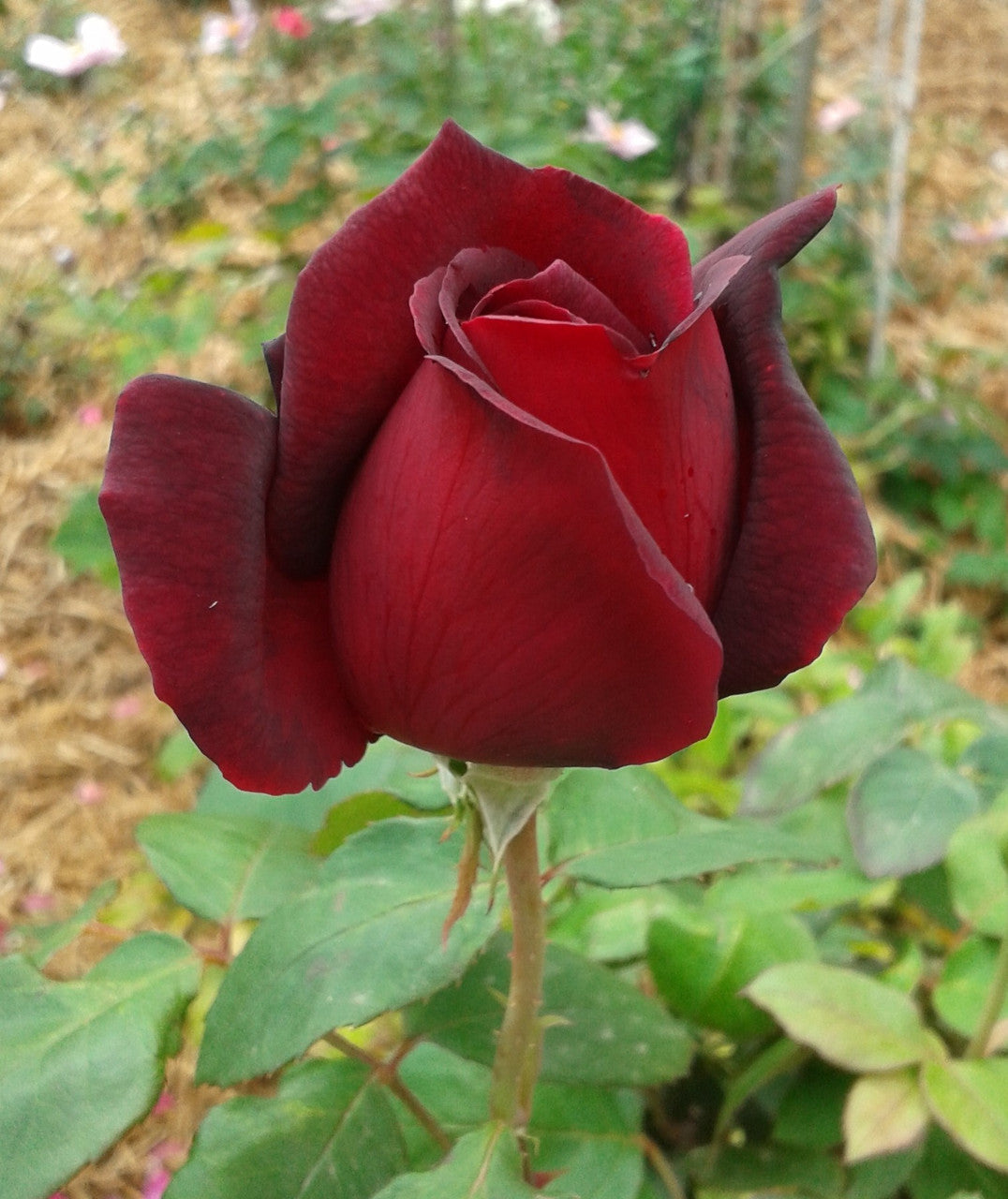 Bred in the USA by Swim & Weeks in 1964 it was named after the State of Oklahoma which translates to: ‘Red Man’s Land’ – how appropriate because men really do love this rose.
Bred in the USA by Swim & Weeks in 1964 it was named after the State of Oklahoma which translates to: ‘Red Man’s Land’ – how appropriate because men really do love this rose.
Oklahoma has very large flowers from long, ovoid buds with high centres and perfect symmetry. Borne on single stems, the heavy flowers are sometimes 15cms across and there are more than 40 very highly fragrant petals in each flower.
For all its wonderful perfume and dark, dark red petals, Oklahoma has a few faults which need to be considered prior to growing it yourself … in the very hot, sunny weather, Oklahoma tends to scorch and in very cold weather, it never quite gets to dark red but pales to dark purple/magenta. I don’t mind those variables but I do not like the weak neck which makes it difficult to place in a vase – it is more suited to ‘Pearly Petals’ (submerged in water and solution) or floating in an open bowl.
Oklahoma is a very tall rose, growing to 1.8mts and branches very nicely to 1.2mts so it does need some good space and although the foliage is dark, matt green, without regular maintenance spraying, Oklahoma will succumb to mildew and black-spot.
- One of the darkest red garden roses
- Magnificent fragrant
- Huge flower buds
- Enjoy for masses of fragrant petals to dry
CULTURAL NOTES:
The generally sunny, dry and hot conditions of the Australian garden are particularly well suited to planting roses and roses flourish in our gardens when you take measures to provide the following:
WATER – Roses are very deep rooted plants and require one good, deep soaking at least every 10 days in hot and dry conditions.
FEED – Because roses flower throughout all but the Winter season, they should be regularly fertilized with quality (preferably organic) fertilizer which contains a balance of major nutrients (NPK) and trace elements. The fertilizer should be applied at least once a month – small amount often – with fortnightly applications of liquid seaweed over the foliage.
PRUNE – During Winter, 70% of the rose plant should be pruned and all old wood removed back to the crown and the bush pruned to shape.
During the flowering seasons, 25% of all flowering stems should be cut back after flowering to encourage strong re-growth.
MULCH – Particular attention to application of lucerne or pea straw directly around the root-zone of each rose will enhance the overall health of the rose and then the whole bed should be mulched to 75mm with any other mulch medium available.
P
PAROLE – HYBRID TEA ROSE AND MY, WHAT A ROSE WHICH IS FAR MORE DESERVING OF THE NAME OF THIS VARIETY IN ENGLAND – ‘BUXOM BEAUTY’
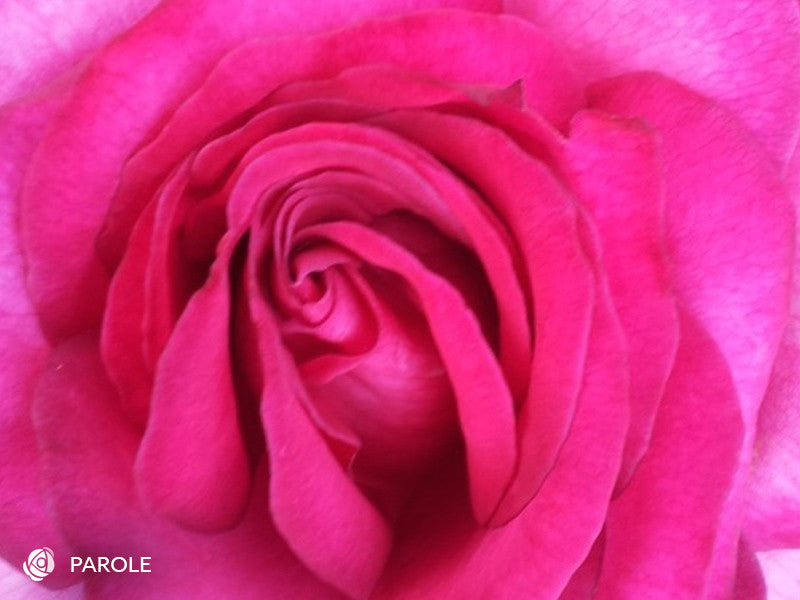 Bred by Kordes, Germany and released in Australia in 2002, this is one of the largest blooms produced on any hybrid tea rose – once measured 22cms across – with huge petals of the darkest, hottest pink with a light slash of silver on some of the petals.
Bred by Kordes, Germany and released in Australia in 2002, this is one of the largest blooms produced on any hybrid tea rose – once measured 22cms across – with huge petals of the darkest, hottest pink with a light slash of silver on some of the petals.
Parole is a very strong grower and the strong stems easily support the massive blooms which are produced on a single stem – the stem could never support more than one bloom at a time. The rose is unaffected by all weather conditions but if you do expect wet weather and there is a lovely bud on the bush, pick it and vase it rather than leave it on the bush to rot. One flower in a vase will certainly fill your home with old-rose fragrance for days on end!
The bush is very upright with dark green leathery foliage and although this rose is not what we would call a profuse bloomer, it does produce a wonderful number of blooms considering the energy the plant must use to produce such large flowers!
- Also known as ‘Buxom Beauty’ – which it is!
- Darkest cerise pink with slashes of silver on outer petals
- Very highly fragrant blooms
- Tall upright bush with healthy leathery foliage
CULTURAL NOTES:
The generally sunny, dry and hot conditions of the Australian garden are particularly well suited to planting roses and roses flourish in our gardens when you take measures to provide the following:
WATER – Roses are very deep rooted plants and require one good, deep soaking at least every 10 days in hot and dry conditions.
FEED – Because roses flower throughout all but the Winter season, they should be regularly fertilized with quality (preferably organic) fertilizer which contains a balance of major nutrients (NPK) and trace elements. The fertilizer should be applied at least once a month – small amount often – with fortnightly applications of liquid seaweed over the foliage.
PRUNE – During Winter, 70% of the rose plant should be pruned and all old wood removed back to the crown and the bush pruned to shape.
During the flowering seasons, 25% of all flowering stems should be cut back after flowering to encourage strong re-growth.
MULCH – Particular attention to application of lucerne or pea straw directly around the root-zone of each rose will enhance the overall health of the rose and then the whole bed should be mulched to 75mm with any other mulch medium available.
PLAYBOY – FLORIBUNDA ROSE WITH MASSES OF FLAMBOYANT SINGLE BLOOMS IN CLUSTERS IN SHADES OF BRIGHT ORANGE/YELLOW WITH SCARLET TIPS
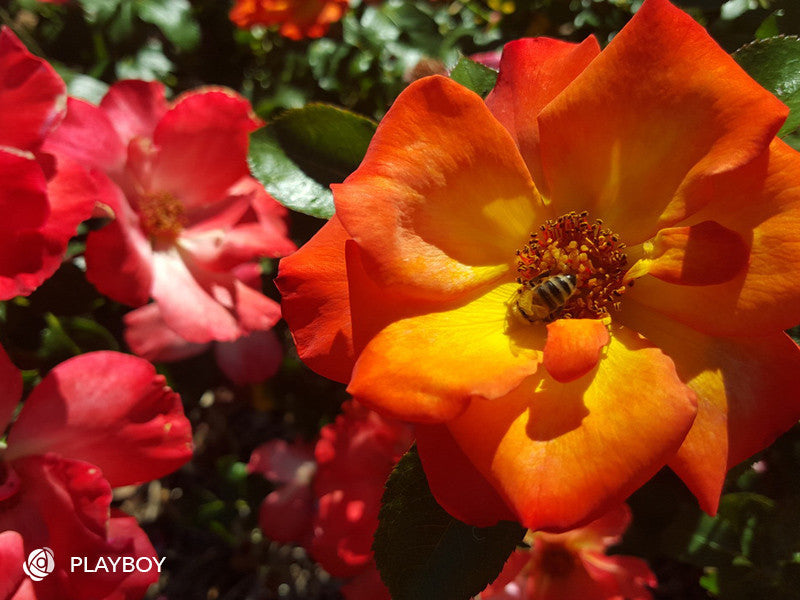 Bred by Cocker of Scotland in 1976 this incredibly delightful rose should be more widely planted for it’s generous ability to produce immense clusters of flowers throughout the flowering season without any care or concern for the weather or however you maintain or neglect it – it’s such a happy rose which was originally named ‘Cheerio’!
Bred by Cocker of Scotland in 1976 this incredibly delightful rose should be more widely planted for it’s generous ability to produce immense clusters of flowers throughout the flowering season without any care or concern for the weather or however you maintain or neglect it – it’s such a happy rose which was originally named ‘Cheerio’!
The foliage of Playboy is so shiny and extremely healthy. It is one of the roses which, while flowering profusely, you can see the new growth and flower buds already being produced for the next round of flowers. If this rose was released today rather than nearly 40 years ago, it would be classed with the ‘Modern Shrub Roses’ because Playboy has the ability to flower all over the bush – from the ground up and it would make a real spectacle in a mass planting where it would require very low maintenance and mechanical pruning.
Sales of the Playboy rose usually have a fun and playful story attached and it is believed that the rose never sold well in the UK because of the name! One charming lady once had to buy this rose “…because I don’t have a playboy in my bed, I should really have one in my garden” and I’m sure she was eternally happy!
- One of the happiest and healthiest roses
- Mass planted it would be a real spectacle
- Extremely healthy and abundant flowering
-
Brilliant as a cut flower for a stand-out arrangement
CULTURAL NOTES:
The generally sunny, dry and hot conditions of the Australian garden are particularly well suited to planting roses and roses flourish in our gardens when you take measures to provide the following:
WATER – Roses are very deep rooted plants and require one good, deep soaking at least every 10 days in hot and dry conditions.
FEED – Because roses flower throughout all but the Winter season, they should be regularly fertilized with quality (preferably organic) fertilizer which contains a balance of major nutrients (NPK) and trace elements. The fertilizer should be applied at least once a month – small amount often – with fortnightly applications of liquid seaweed over the foliage.
PRUNE – During Winter, 70% of the rose plant should be pruned and all old wood removed back to the crown and the bush pruned to shape.
During the flowering seasons, 25% of all flowering stems should be cut back after flowering to encourage strong re-growth.
MULCH – Particular attention to application of lucerne or pea straw directly around the root-zone of each rose will enhance the overall health of the rose and then the whole bed should be mulched to 75mm with any other mulch medium available.
Q
R
REMEMBER ME – HYBRID TEA ROSE WITH A DELIGHTFUL CONFECTION OF COLOURS INCLUDING BURNT ORANGE, AMBER AND BEIGE WITH BURNT RED EDGES
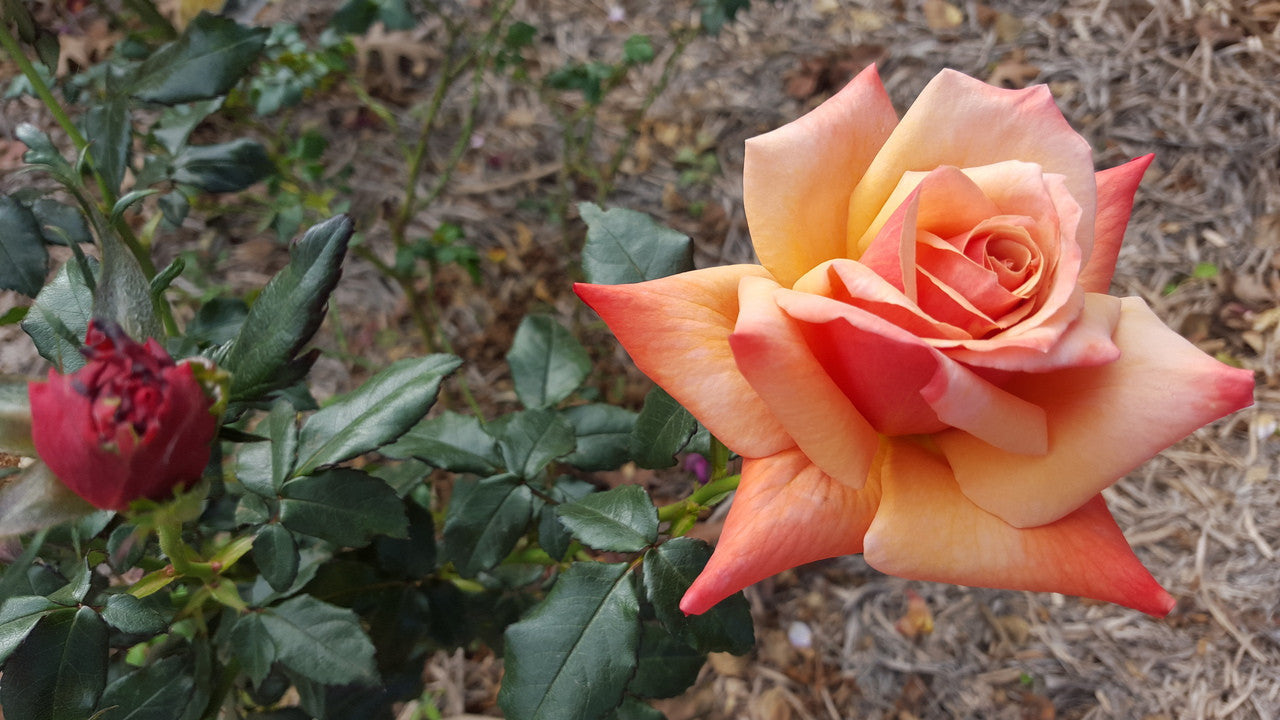 Raised by Cocker & Sons of Scotland in 1984 this wonderful rose flowers in many gardens around Australia for this reason:
Raised by Cocker & Sons of Scotland in 1984 this wonderful rose flowers in many gardens around Australia for this reason:
“REMEMBER ME in your heart, your thoughts and your memories. The times we loved. The times we cried. The times we laughed and the times we shared together will always be Remembered!” is written on the rose tag and this rose is indeed purchased very frequently as a memorial plant. I am always so pleased that it is such a robust and sturdy rose so that even the most amateur gardener would be unlikely to be unsuccessful growing this rose.
This rose has very unique foliage which is light green with a rather dark brown border and looks very pretty against the copper/brown colours of each different flower.
Remember Me is extremely healthy and robustly produces pale-green watershoots from the base which ensure the rose flowers continuously. In extremely hot weather, the flowers may be slightly smaller and the colour will be more intense.
- Ideal remembrance rose because it is guaranteed to grow well
- Extremely unique colours of copper/brown/orange
- Lightly fragrant
- Tall growing and very floriferous.
CULTURAL NOTES:
The generally sunny, dry and hot conditions of the Australian garden are particularly well suited to planting roses and roses flourish in our gardens when you take measures to provide the following:
WATER – Roses are very deep rooted plants and require one good, deep soaking at least every 10 days in hot and dry conditions.
FEED – Because roses flower throughout all but the Winter season, they should be regularly fertilized with quality (preferably organic) fertilizer which contains a balance of major nutrients (NPK) and trace elements. The fertilizer should be applied at least once a month – small amount often – with fortnightly applications of liquid seaweed over the foliage.
PRUNE – During Winter, 70% of the rose plant should be pruned and all old wood removed back to the crown and the bush pruned to shape.
During the flowering seasons, 25% of all flowering stems should be cut back after flowering to encourage strong re-growth.
MULCH – Particular attention to application of lucerne or pea straw directly around the root-zone of each rose will enhance the overall health of the rose and then the whole bed should be mulched to 75mm with any other mulch medium available.
S
SCENTIMENTAL – MODERN FLORIBUNDA/SHRUB ROSE AND NO, THIS IS NOT A SPELLING ERROR! THE ROSE NAME IS SO SPELT BECAUSE IT HAS AN AMAZING FRAGRANCE
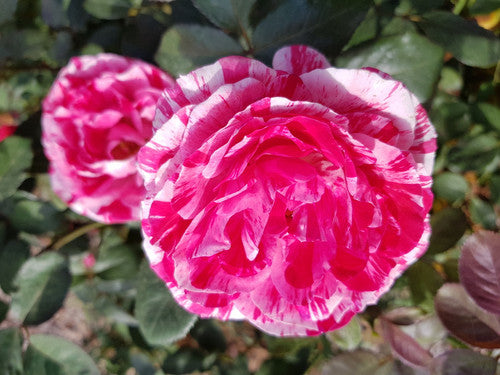 Raised by Tom Carruth, USA, 1999 produces masses of medium sized pointed buds mostly in clusters, and opening with a riot of stripes of burgundy-red and creamy white where no two flowers are exactly the same.
Raised by Tom Carruth, USA, 1999 produces masses of medium sized pointed buds mostly in clusters, and opening with a riot of stripes of burgundy-red and creamy white where no two flowers are exactly the same.
Scentimental has an intense spicy Damask rose fragrance and to make a real statement with this rose in the garden, it should always be planted in a group – nobody would ever walk past and keep their mouth closed … this is a real oooh, aaah rose!
The bush is very shrubby with large dark green, plentiful and healthy foliage which is rather serrated and very leathery. It is a very rounded shrub and flowers constantly throughout the flowering season.
- Highly recommended novelty rose
- Intensely spice and Damask rose fragrance
- Lovely rounded bushy shrub
- Constantly in flower
CULTURAL NOTES:
The generally sunny, dry and hot conditions of the Australian garden are particularly well suited to planting roses and roses flourish in our gardens when you take measures to provide the following:
WATER – Roses are very deep rooted plants and require one good, deep soaking at least every 10 days in hot and dry conditions.
FEED – Because roses flower throughout all but the Winter season, they should be regularly fertilized with quality (preferably organic) fertilizer which contains a balance of major nutrients (NPK) and trace elements. The fertilizer should be applied at least once a month – small amount often – with fortnightly applications of liquid seaweed over the foliage.
PRUNE – During Winter, 70% of the rose plant should be pruned and all old wood removed back to the crown and the bush pruned to shape.
During the flowering seasons, 25% of all flowering stems should be cut back after flowering to encourage strong re-growth.
MULCH – Particular attention to application of lucerne or pea straw directly around the root-zone of each rose will enhance the overall health of the rose and then the whole bed should be mulched to 75mm with any other mulch medium available.
SLIM DUSTY ROSE – FLORIBUNDA ROSE RELEASED TO COMMEMORATE THE LIFE OF THE AUSTRALIAN ICON AND COUNTRY MUSIC LEGEND HIMSELF
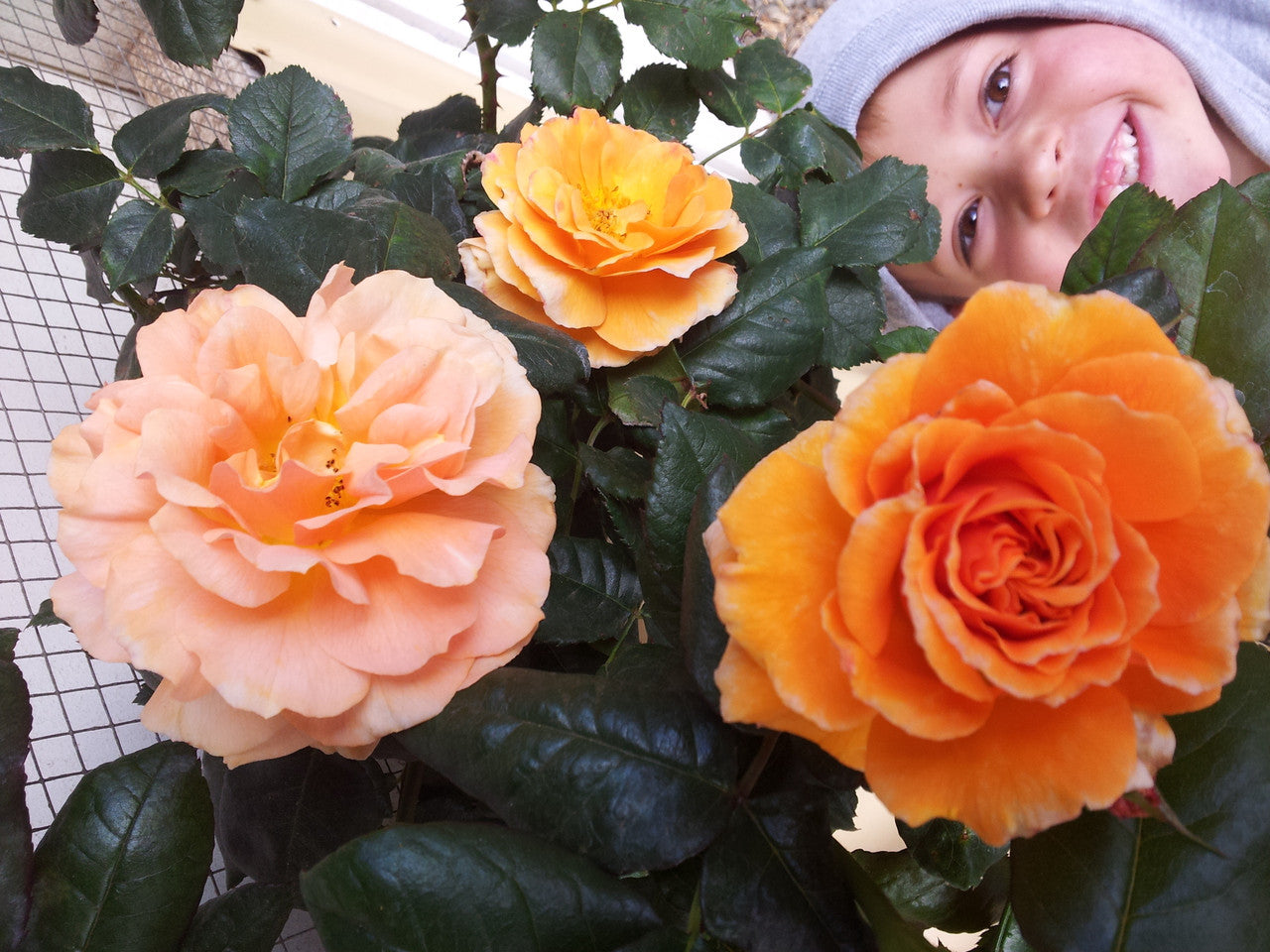 This rose was released in Australia by Landsdale Rose Gardens and part of the proceeds from the sale of this rose will go towards the development of the Slim Dusty Centre in Kempsey, NSW, Slim’s home town.
This rose was released in Australia by Landsdale Rose Gardens and part of the proceeds from the sale of this rose will go towards the development of the Slim Dusty Centre in Kempsey, NSW, Slim’s home town.
Slim Dusty Rose is rich golden coppery orange – a colour reminiscent of the Australian outback. The flowers are carried on strong-stemmed clusters and produced in massive profusion throughout the flowering season.
The bush is very compact to a height of around one metre and a group planting or rose hedge would make a stunning, eye-catching border of the rose garden.
- A rose named for the iconic Country Music Legend
- Stunning rich golden coppery orange blooms
- Clusters of strong stemmed blooms continually
- Compact bush would suit rose hedge or garden border
CULTURAL NOTES:
The generally sunny, dry and hot conditions of the Australian garden are particularly well suited to planting roses and roses flourish in our gardens when you take measures to provide the following:
WATER – Roses are very deep rooted plants and require one good, deep soaking at least every 10 days in hot and dry conditions.
FEED – Because roses flower throughout all but the Winter season, they should be regularly fertilized with quality (preferably organic) fertilizer which contains a balance of major nutrients (NPK) and trace elements. The fertilizer should be applied at least once a month – small amount often – with fortnightly applications of liquid seaweed over the foliage.
PRUNE – During Winter, 70% of the rose plant should be pruned and all old wood removed back to the crown and the bush pruned to shape.
During the flowering seasons, 25% of all flowering stems should be cut back after flowering to encourage strong re-growth.
MULCH – Particular attention to application of lucerne or pea straw directly around the root-zone of each rose will enhance the overall health of the rose and then the whole bed should be mulched to 75mm with any other mulch medium available.
ST. PATRICK – HYBRID TEA ROSE WITH UNUSUAL GREEN BUDS WHICH, DEPENDING ON THE WEATHER, TURN GOLDEN YELLOW IN THE SUMMER OR RETAIN A CHARTREUSE GREEN IN COLD WEATHER
 Bred by an amateur breeder, Frank Strickland, California, USA, 1995 by ‘Brandy’ x Gold Medal’ this stunning rose is a must-have if you like to exhibit at rose shows.
Bred by an amateur breeder, Frank Strickland, California, USA, 1995 by ‘Brandy’ x Gold Medal’ this stunning rose is a must-have if you like to exhibit at rose shows.
Unfortunately, St. Patrick is not suitable to grow in our region because it flourishes where it gets really, really hot or where it is planted against a hot north/western wall to protect it from any cold at all. (The summer of 2013 would have been an exception in Victoria but who could have predicted that?).
The fully double blooms of St. Patrick are one of the longest-lasting cut flower garden roses I have ever experienced. It has high pointed centres and the outer green petals are very appealing and different. The foliage is matte mid-green and plentiful and when grown in the warmer climates, it is abundantly free-flowering and a joy to all who can grow it.
- Unusual green buds
- Long lasting cut flower
- Suitable for exhibiting at Rose Shows
- Plant only in hot climates
CULTURAL NOTES:
The generally sunny, dry and hot conditions of the Australian garden are particularly well suited to planting roses and roses flourish in our gardens when you take measures to provide the following:
WATER – Roses are very deep rooted plants and require one good, deep soaking at least every 10 days in hot and dry conditions.
FEED – Because roses flower throughout all but the Winter season, they should be regularly fertilized with quality (preferably organic) fertilizer which contains a balance of major nutrients (NPK) and trace elements. The fertilizer should be applied at least once a month – small amount often – with fortnightly applications of liquid seaweed over the foliage.
PRUNE – During Winter, 70% of the rose plant should be pruned and all old wood removed back to the crown and the bush pruned to shape.
During the flowering seasons, 25% of all flowering stems should be cut back after flowering to encourage strong re-growth.
MULCH – Particular attention to application of lucerne or pea straw directly around the root-zone of each rose will enhance the overall health of the rose and then the whole bed should be mulched to 75mm with any other mulch medium available.
SWEET INTOXICATION – FLORIBUNDA ROSE WITH VERY HYBRID TEA SHAPED BLOOMS IN MASSIVE CLUSTERS
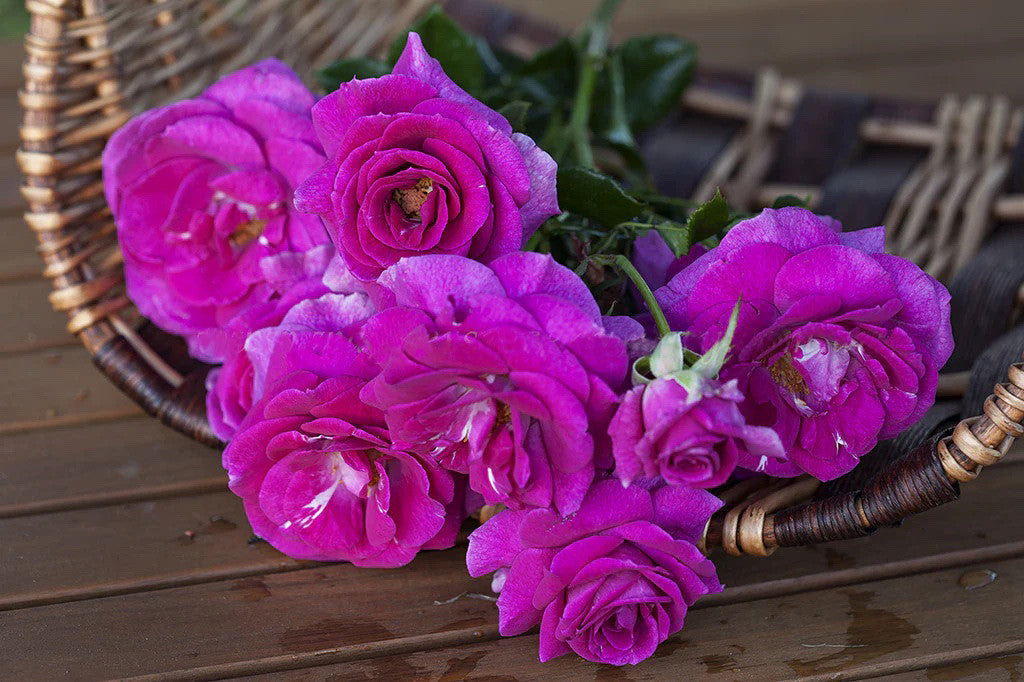 Raised in the USA and released by Swane’s Nursery this exceedingly showy rose is “The Ultimate Garden Vixen” producing massive heads of blooms which have rich magenta petals deep in the centre fading to sparkling amethyst outside petals.
Raised in the USA and released by Swane’s Nursery this exceedingly showy rose is “The Ultimate Garden Vixen” producing massive heads of blooms which have rich magenta petals deep in the centre fading to sparkling amethyst outside petals.
Sweet Intoxication will permeate your garden with the most alluring and lasting clove fragrance – hence its name!
The glossy green foliage is an indication of the extreme disease resistance and health of this rather tall growing (1.2 metres) shrub. The strong clusters of blooms last well in the vase and will fill the room with spicy perfume.
- Extremely healthy, disease resistant shrub rose
- Intoxicating clove fragrace
- Long strong clusters of blooms suitable to vase
- Glossy green foliage
CULTURAL NOTES:
The generally sunny, dry and hot conditions of the Australian garden are particularly well suited to planting roses and roses flourish in our gardens when you take measures to provide the following:
WATER – Roses are very deep rooted plants and require one good, deep soaking at least every 10 days in hot and dry conditions.
FEED – Because roses flower throughout all but the Winter season, they should be regularly fertilized with quality (preferably organic) fertilizer which contains a balance of major nutrients (NPK) and trace elements. The fertilizer should be applied at least once a month – small amount often – with fortnightly applications of liquid seaweed over the foliage.
PRUNE – During Winter, 70% of the rose plant should be pruned and all old wood removed back to the crown and the bush pruned to shape.
During the flowering seasons, 25% of all flowering stems should be cut back after flowering to encourage strong re-growth.
MULCH – Particular attention to application of lucerne or pea straw directly around the root-zone of each rose will enhance the overall health of the rose and then the whole bed should be mulched to 75mm with any other mulch medium available.
T
TUSCAN SUN – FLORIBUNDA ROSE OF DAZZLING BEAUTY AND EXTREMELY HIGH-HEALTH PERFORMANCE
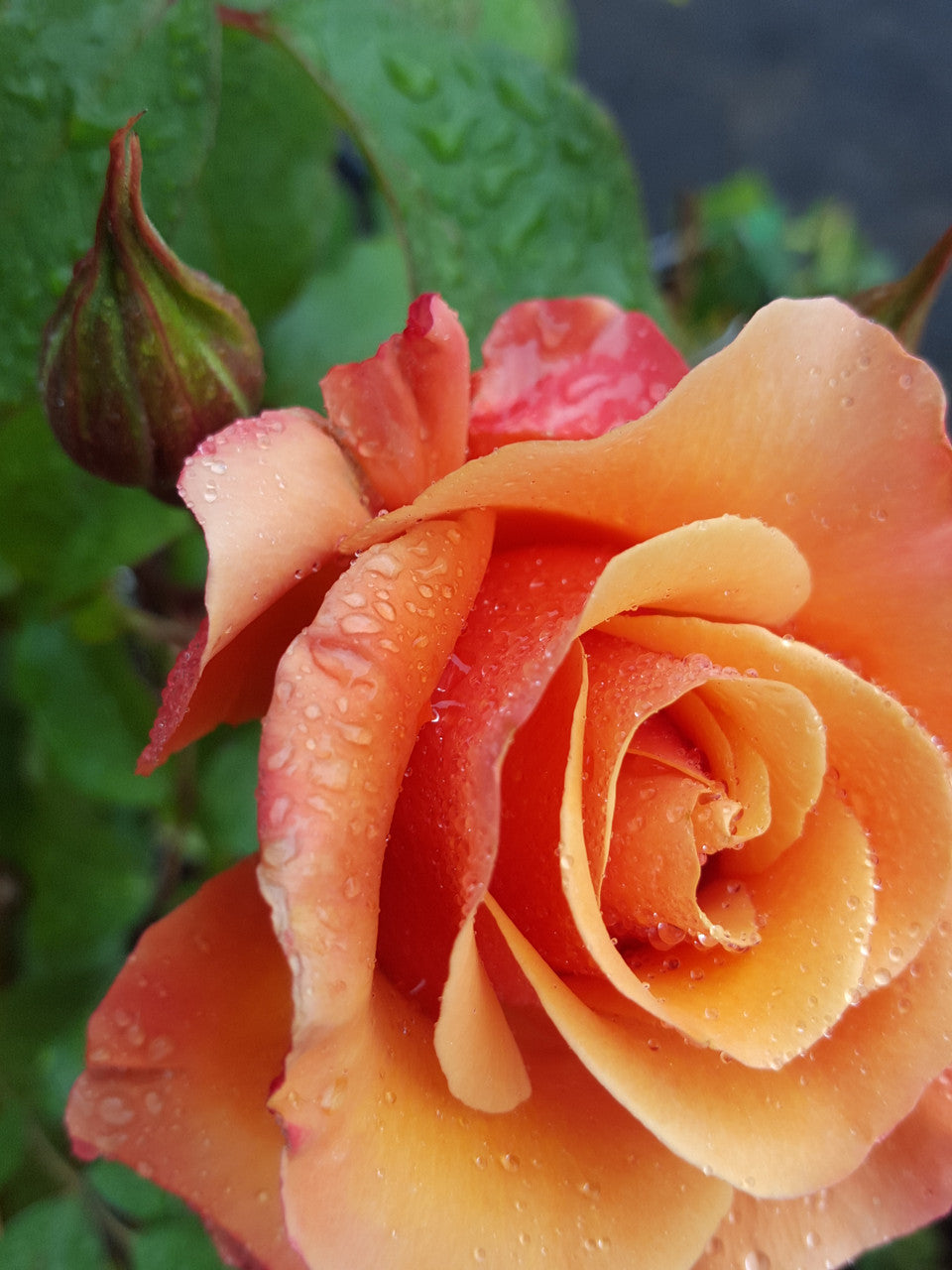 Raised in the USA and released in Australia by Swane’s Nursery, this gutsy floribunda was awarded the Best Performer in the Fields of 2006. During the hot, dry summers of the drought, this rose just kept right on blooming.
Raised in the USA and released in Australia by Swane’s Nursery, this gutsy floribunda was awarded the Best Performer in the Fields of 2006. During the hot, dry summers of the drought, this rose just kept right on blooming.
Tuscan Sun has deep warm apricot high-centred buds which open to fully reveal the eye-catching bronze which finishes a coppery pink … intriguing colour blends borne in generous clusters and lovely spicy scent.
The long strong stems of blooms are very suited to the vase and complimented with lush, clean mid-green foliage. The bush is rounded and well-branched to a height of around 1.2 metres with outstanding disease resistance.
- Intriguing colour of warm apricot and bronze, finishing coppery pink
- Stunning is vase arrangements
- Outstanding disease resistance
- Spicy fragrance
CULTURAL NOTES:
The generally sunny, dry and hot conditions of the Australian garden are particularly well suited to planting roses and roses flourish in our gardens when you take measures to provide the following:
WATER – Roses are very deep rooted plants and require one good, deep soaking at least every 10 days in hot and dry conditions.
FEED – Because roses flower throughout all but the Winter season, they should be regularly fertilized with quality (preferably organic) fertilizer which contains a balance of major nutrients (NPK) and trace elements. The fertilizer should be applied at least once a month – small amount often – with fortnightly applications of liquid seaweed over the foliage.
PRUNE – During Winter, 70% of the rose plant should be pruned and all old wood removed back to the crown and the bush pruned to shape.
During the flowering seasons, 25% of all flowering stems should be cut back after flowering to encourage strong re-growth.
MULCH – Particular attention to application of lucerne or pea straw directly around the root-zone of each rose will enhance the overall health of the rose and then the whole bed should be mulched to 75mm with any other mulch medium available.
U
V
VALENCIA – HYBRID TEA ROSE OF EXQUISITE FORM WITH HUGE CLOTTED-CREAMY COLOURED BLOOMS ON A TALL, VIGOROUS BUSH
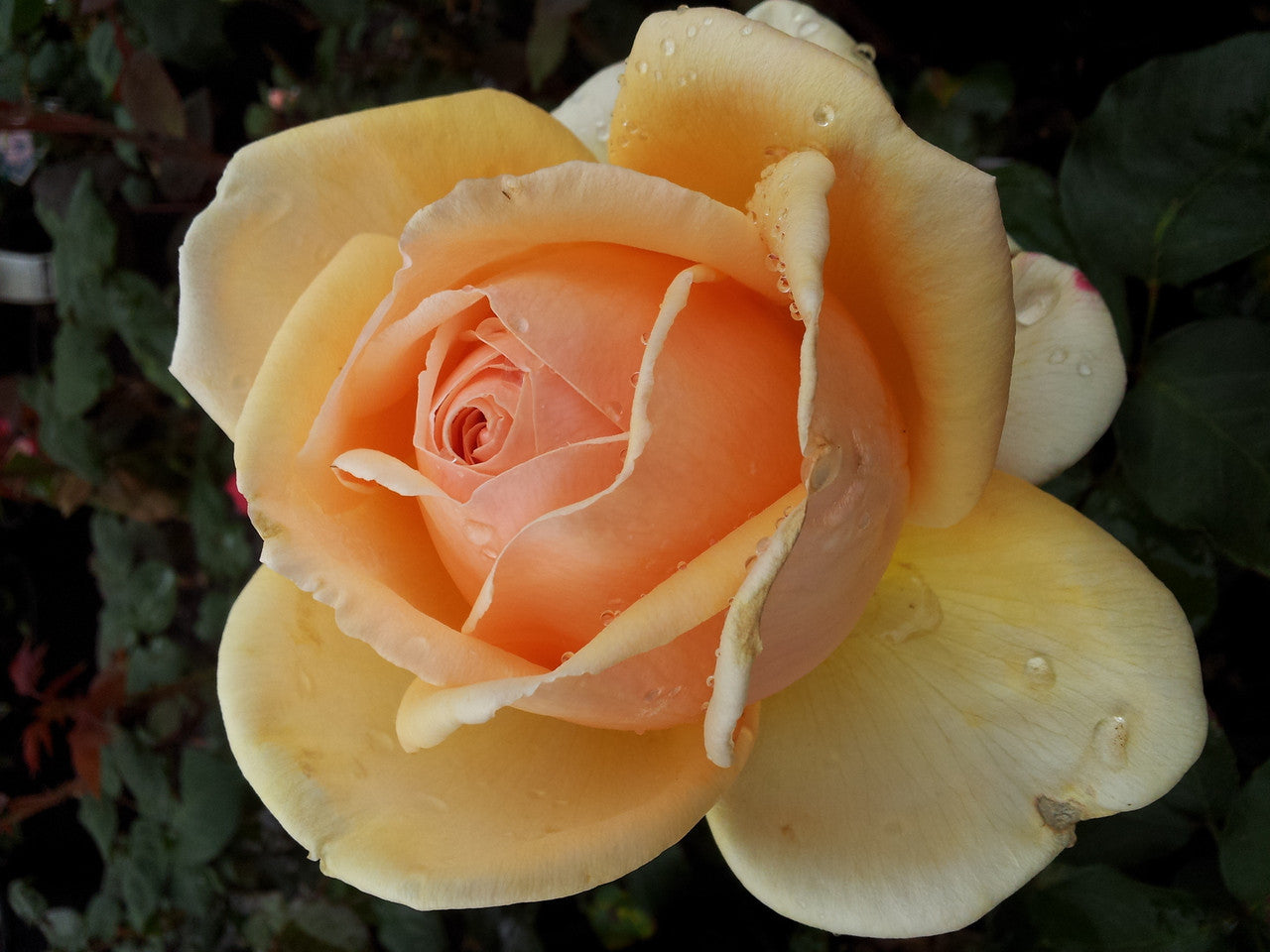 Bred by Kordes, Germany in 1989 Valencia has a colour of its very own – a blend of copper-yellow-cream and huge flowers, most especially in the warmer weather when it our-performs other roses for flower production and health.
Bred by Kordes, Germany in 1989 Valencia has a colour of its very own – a blend of copper-yellow-cream and huge flowers, most especially in the warmer weather when it our-performs other roses for flower production and health.
Valencia has very dark green, tough and leathery foliage which ensures that the bush remains healthy in all weather. The flowers are produced on long, strong stems, usually one to a stem because the flowers are so large and the stem could only support one flower at a time, so large is the beautiful, subtly fragrant bloom.
The flowers are ideal for flower arranging with the warm copper-yellow blooms blending well with a huge range of various colours and décor.
Valencia grows on a moderately sized bush to around 1.2 metres and if planted in a group, would be spectacular and produce a succession of blooms for the vase over a long flowering period.
- Highly recommended rose in this colour range of copper-yellow
- Extremely healthy, lush, dark green foliage
- Exquisite strong stemmed cut flower
- Large flowers with lovely fragrance
CULTURAL NOTES:
The generally sunny, dry and hot conditions of the Australian garden are particularly well suited to planting roses and roses flourish in our gardens when you take measures to provide the following:
WATER – Roses are very deep rooted plants and require one good, deep soaking at least every 10 days in hot and dry conditions.
FEED – Because roses flower throughout all but the Winter season, they should be regularly fertilized with quality (preferably organic) fertilizer which contains a balance of major nutrients (NPK) and trace elements. The fertilizer should be applied at least once a month – small amount often – with fortnightly applications of liquid seaweed over the foliage.
PRUNE – During Winter, 70% of the rose plant should be pruned and all old wood removed back to the crown and the bush pruned to shape.
During the flowering seasons, 25% of all flowering stems should be cut back after flowering to encourage strong re-growth.
MULCH – Particular attention to application of lucerne or pea straw directly around the root-zone of each rose will enhance the overall health of the rose and then the whole bed should be mulched to 75mm with any other mulch medium available.
W
WESTERLAND – MODERN CLIMBING ROSE WITH BRIGHT APRICOT-ORANGE FLOWERS WHICH, WHEN OPENED, REVEAL CRIMSON STAMENS
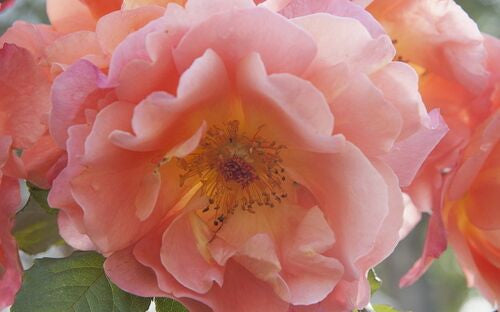 Bred by Kordes, Germany in 1969 this moderate climbing rose is suitable to position against a fence, espalier on a wall, grow as a pillar with support or allow to free-stand in a corner of the garden and billow.
Bred by Kordes, Germany in 1969 this moderate climbing rose is suitable to position against a fence, espalier on a wall, grow as a pillar with support or allow to free-stand in a corner of the garden and billow.
Westerland has a delightful spicy clove fragrance and the vigorous upright canes are clothed in large, dark green serrated foliage which is very healthy and disease-resistant. It carries lots of thorns so less ideal over a small arch.
The bright orange flowers are produced in clusters continually all over the rose and this rose is particularly handy to draw the eye to a particular section of the garden. Because the orange colour is blended with apricot, this is not a harsh colour but blends well and this wonderful climber is particularly pretty when planted together with a dark purple hybrid clematis. If not pruned regularly, Westerland will produce hips and this may reduce the repeat flowering qualities so regular dead-heading is highly recommended.
- Orange-apricot climbing rose
- Spicy clove fragrance
- Incredibly free flowering when regularly trimmed
- Very healthy, lush green foliage
CULTURAL NOTES:
The generally sunny, dry and hot conditions of the Australian garden are particularly well suited to planting roses and roses flourish in our gardens when you take measures to provide the following:
WATER – Roses are very deep rooted plants and require one good, deep soaking at least every 10 days in hot and dry conditions.
FEED – Because roses flower throughout all but the Winter season, they should be regularly fertilized with quality (preferably organic) fertilizer which contains a balance of major nutrients (NPK) and trace elements. The fertilizer should be applied at least once a month – small amount often – with fortnightly applications of liquid seaweed over the foliage.
PRUNE – During Winter, 70% of the rose plant should be pruned and all old wood removed back to the crown and the bush pruned to shape.
During the flowering seasons, 25% of all flowering stems should be cut back after flowering to encourage strong re-growth.
MULCH – Particular attention to application of lucerne or pea straw directly around the root-zone of each rose will enhance the overall health of the rose and then the whole bed should be mulched to 75mm with any other mulch medium available.
X
Y
Z
ZEPHERINE DROUHIN – CLIMBING BOURBON ROSE WITH SEMI-DOUBLE CERISE-PINK BLOOMS OVER THE WHOLE SEASON
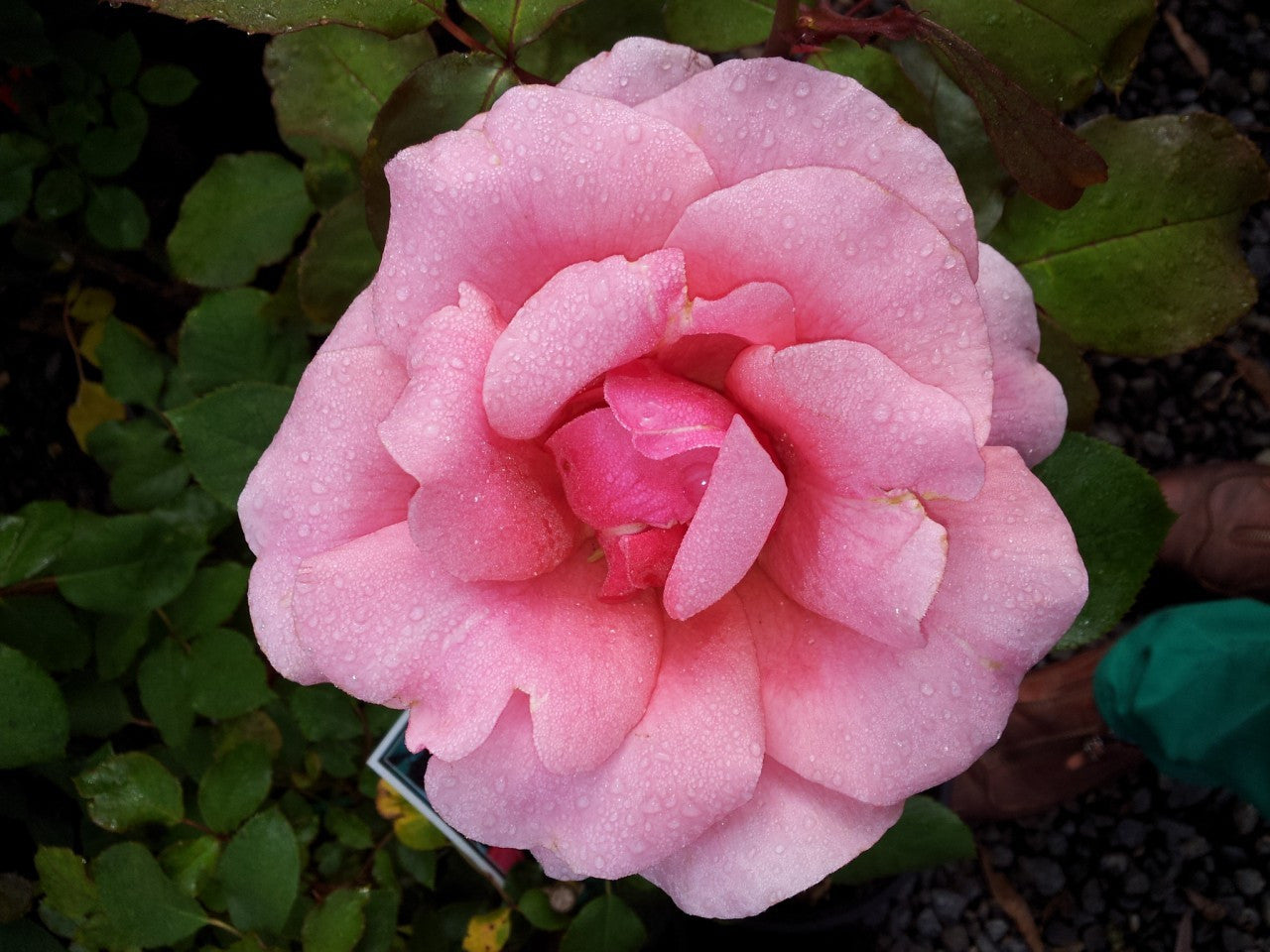 Bred by Bizot, France in 1868 this lovely rose is very renowned for the fact that it is one of the very few climbing roses which is totally thornless and flowers profusely throughout the season.
Bred by Bizot, France in 1868 this lovely rose is very renowned for the fact that it is one of the very few climbing roses which is totally thornless and flowers profusely throughout the season.
Zepherine Drouhin should always be planted as far out in the open as is possible within your garden design! Without lots of good airflow and wind, this delightful rose will succumb to powdery mildew – over the years I have referred to this rose as ‘the mildew magnet rose’ … in humid, still weather, this rose will show signs of mildew and it should never, ever be watered late in the evening. In fact, the foliage should never get wet because it is just so susceptible to powdery mildew.
However, despite the bad news, the great news is that in a good location, this rose will give immense pleasure – the fragrance is amazing and because it is completely thornless, this rose will continue to be grown by many gardeners who shirk away from growing roses because of the thorns!
Throughout the entire season, Zepherine Drouhin will delight with masses of medium sized bright pink blooms and the foliage is plentiful when the rose is healthy.
- Most popular thornless climbing rose
- Flowers consistently throughout the season
- Masses of dark pink and very highly fragrant blooms
- Plant in the right position with lots of airflow!
CULTURAL NOTES:
The generally sunny, dry and hot conditions of the Australian garden are particularly well suited to planting roses and roses flourish in our gardens when you take measures to provide the following:
WATER – Roses are very deep rooted plants and require one good, deep soaking at least every 10 days in hot and dry conditions.
FEED – Because roses flower throughout all but the Winter season, they should be regularly fertilized with quality (preferably organic) fertilizer which contains a balance of major nutrients (NPK) and trace elements. The fertilizer should be applied at least once a month – small amount often – with fortnightly applications of liquid seaweed over the foliage.
PRUNE – During Winter, 70% of the rose plant should be pruned and all old wood removed back to the crown and the bush pruned to shape.
During the flowering seasons, 25% of all flowering stems should be cut back after flowering to encourage strong re-growth.
MULCH – Particular attention to application of lucerne or pea straw directly around the root-zone of each rose will enhance the overall health of the rose and then the whole bed should be mulched to 75mm with any other mulch medium available.
- Choosing a selection results in a full page refresh.

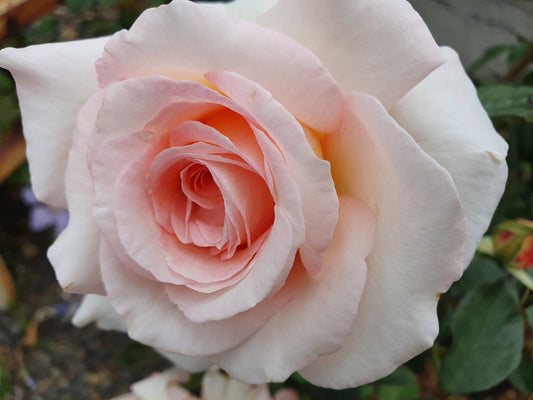
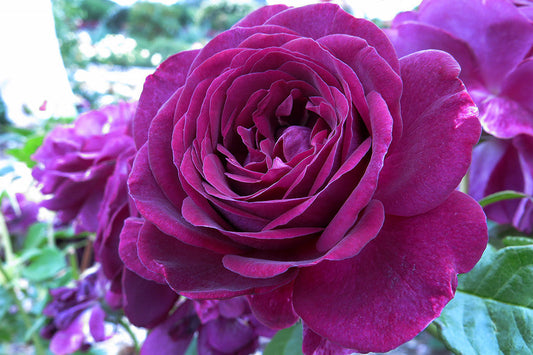
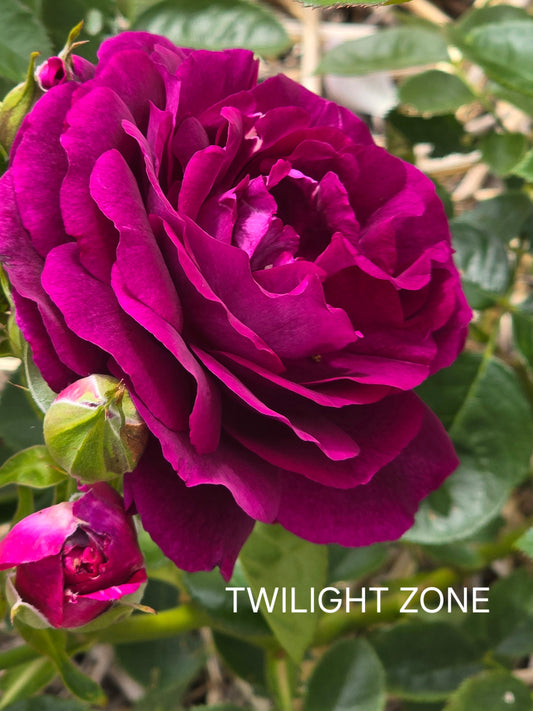
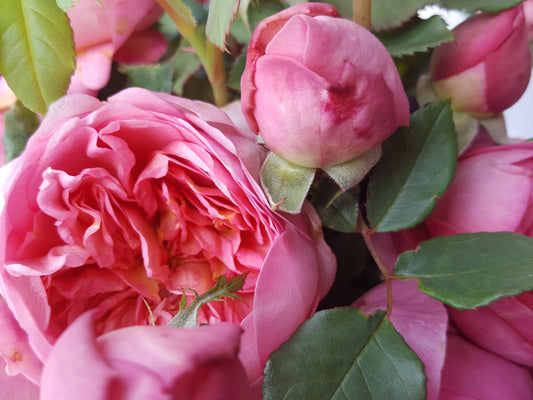
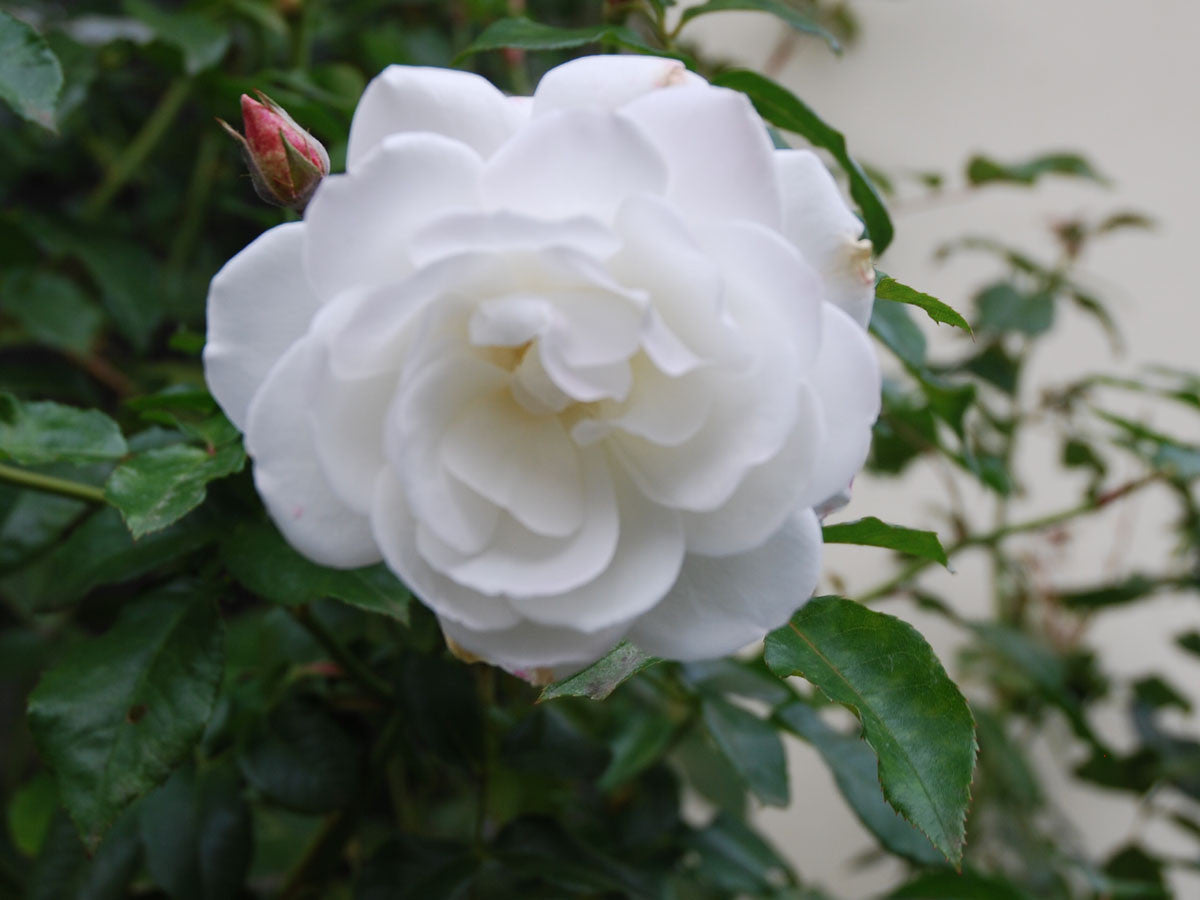 Bred by Kordes in 1958 and worthy of the title we use for it: “Rose of the Century” because of it’s extremely healthy and free-flowering, easy care qualities. Inducted to the Rose Hall of Fame in 1983.
Bred by Kordes in 1958 and worthy of the title we use for it: “Rose of the Century” because of it’s extremely healthy and free-flowering, easy care qualities. Inducted to the Rose Hall of Fame in 1983.